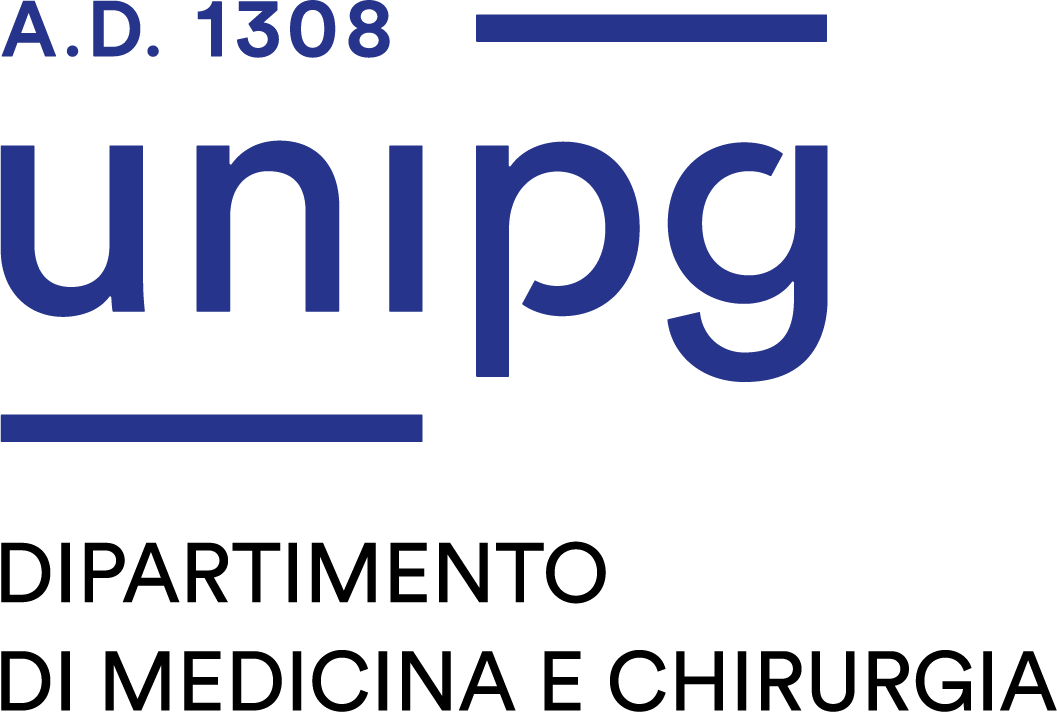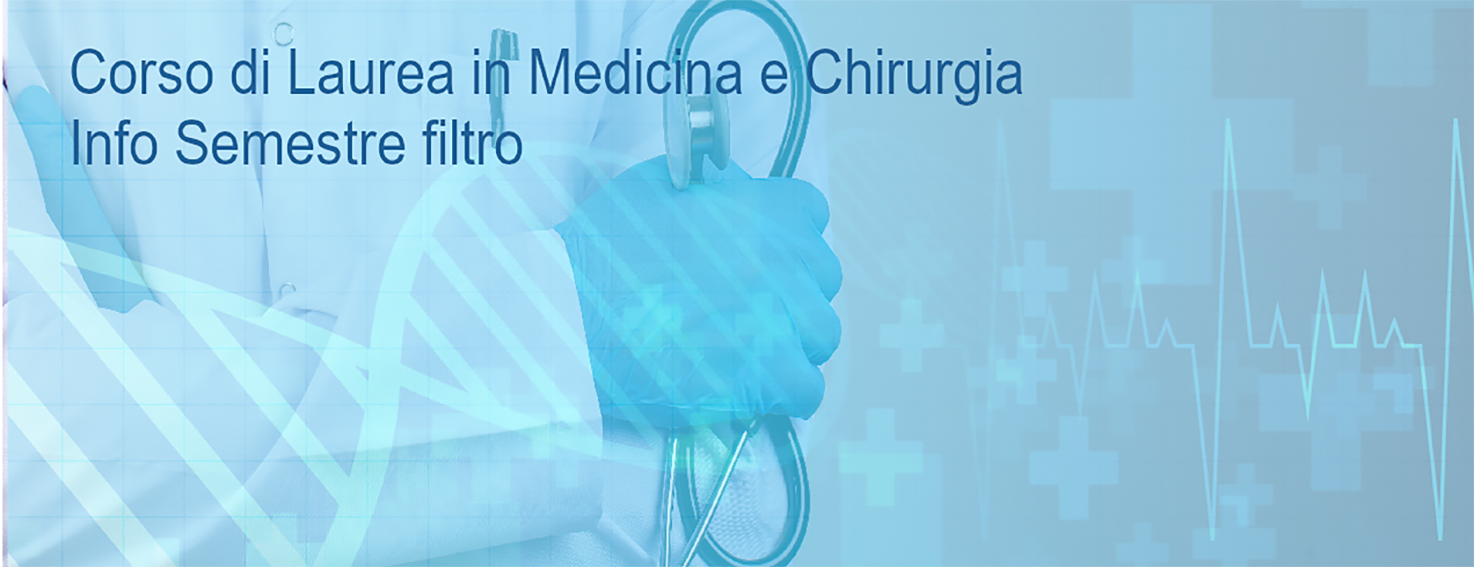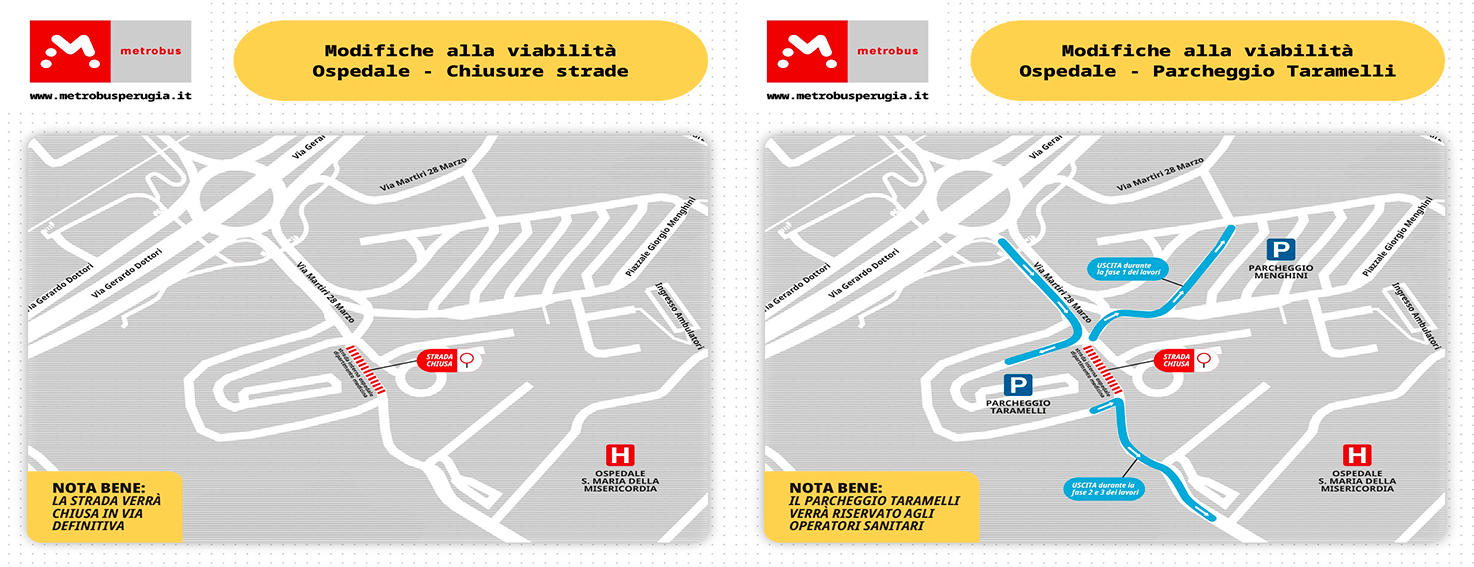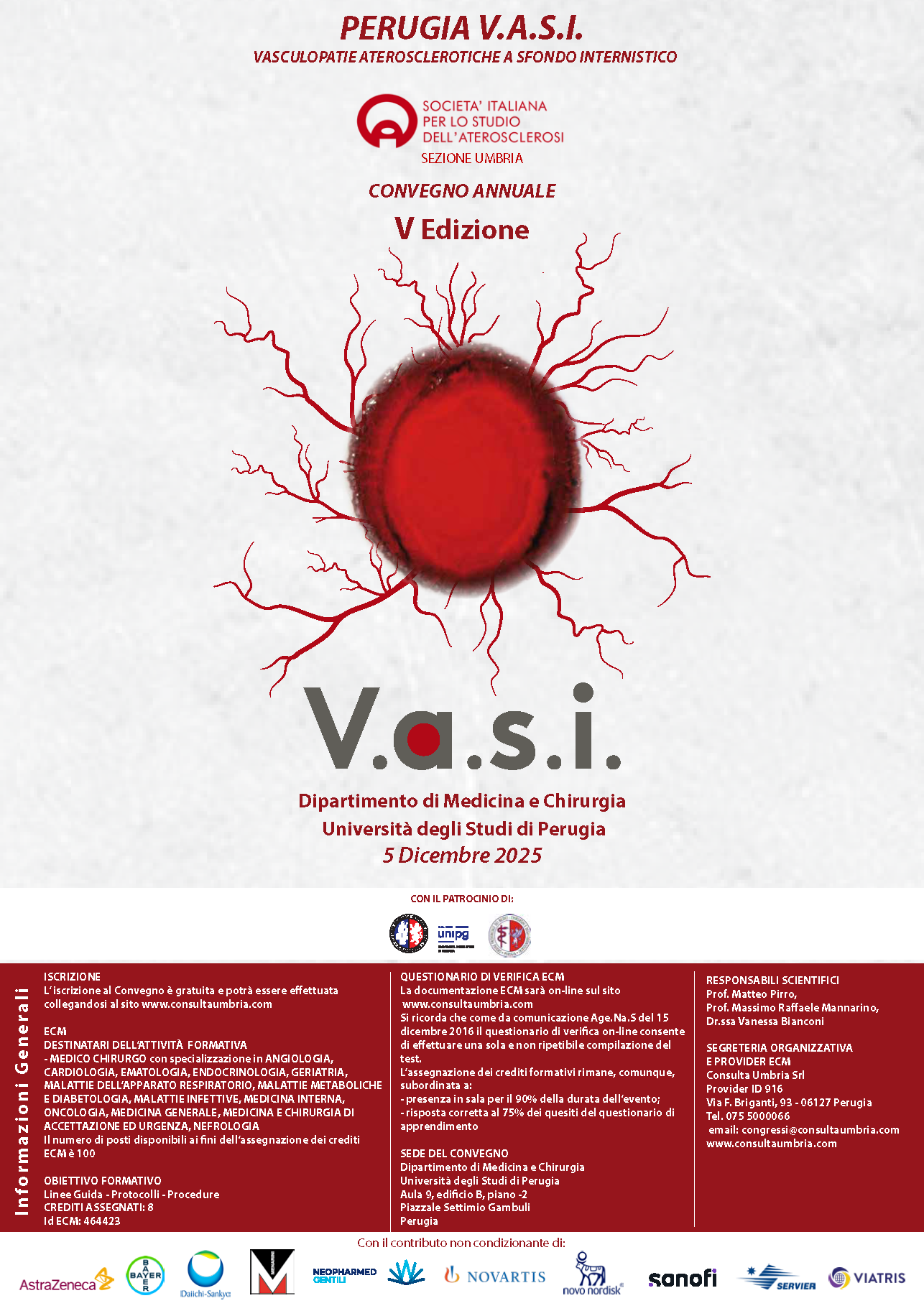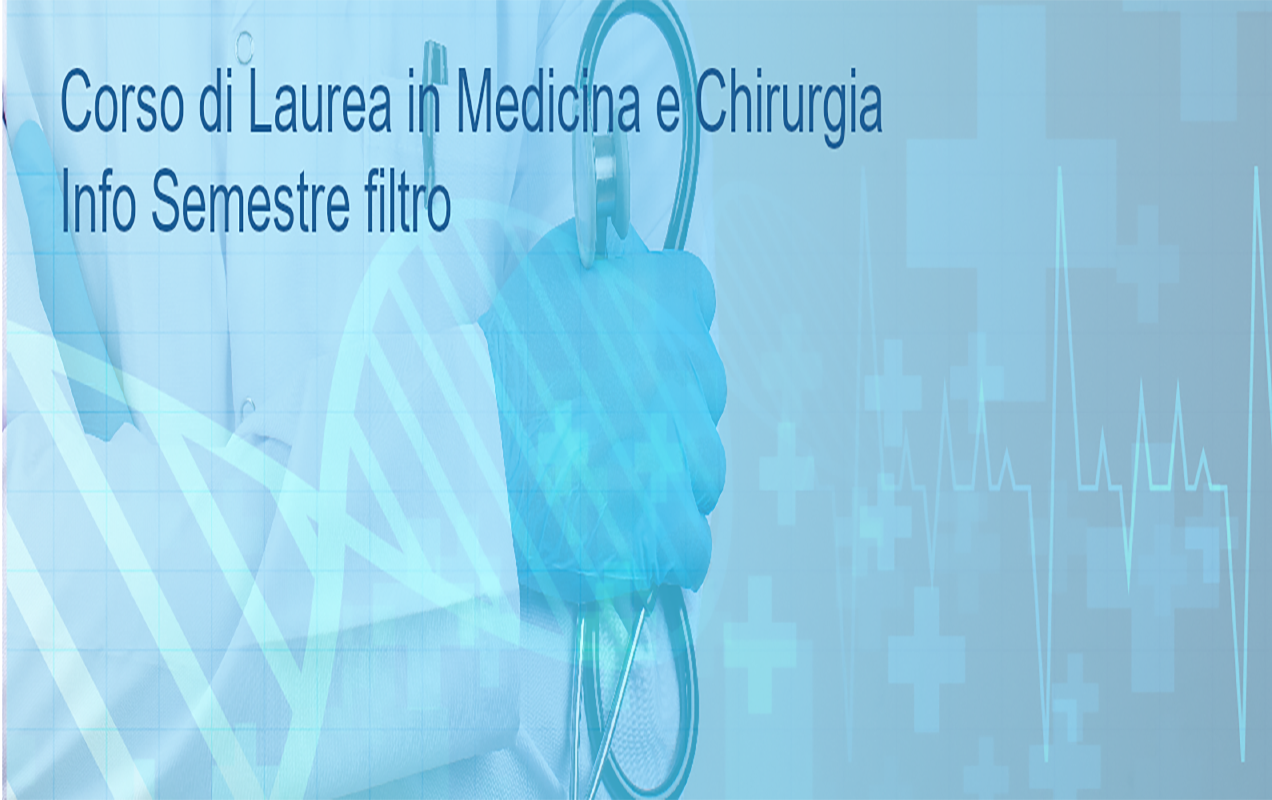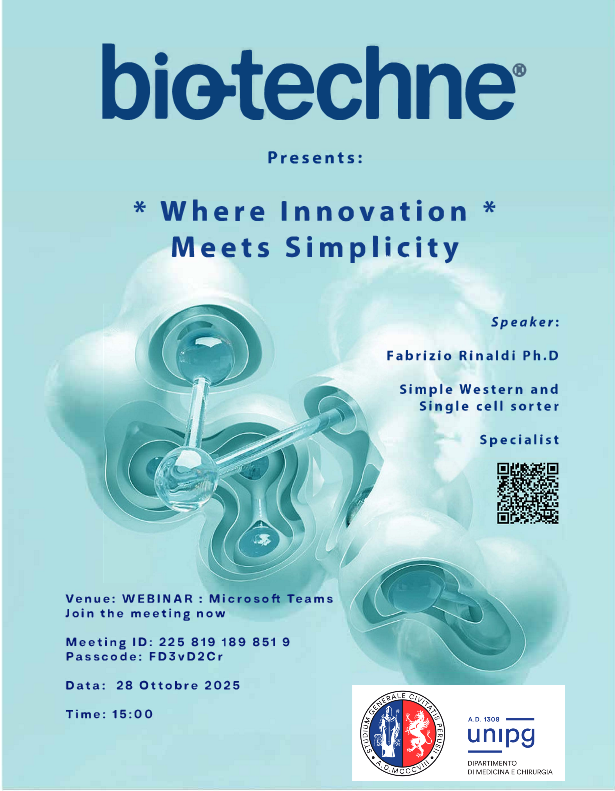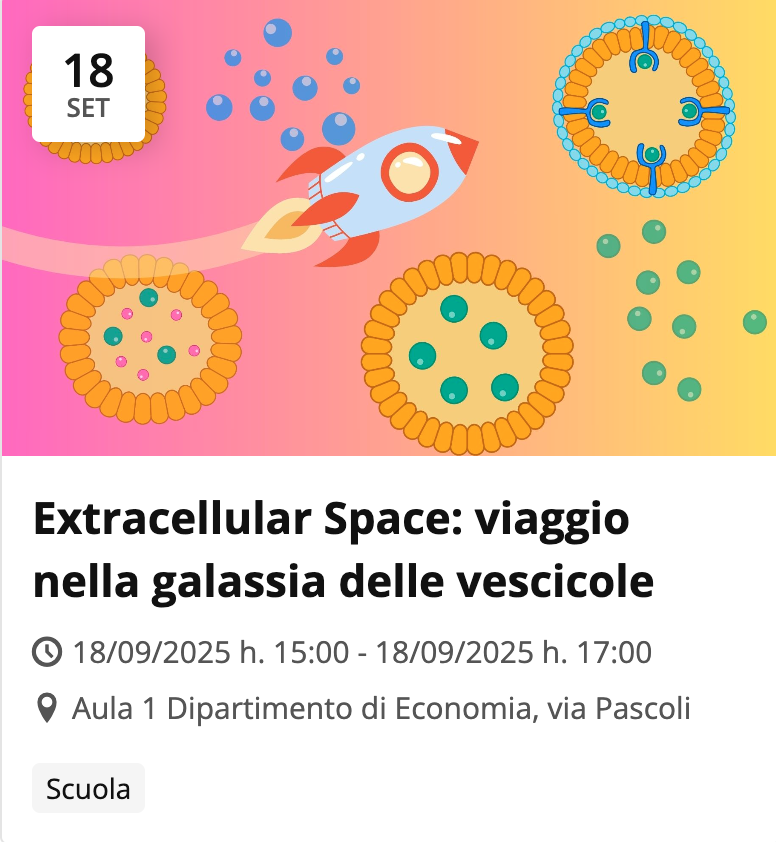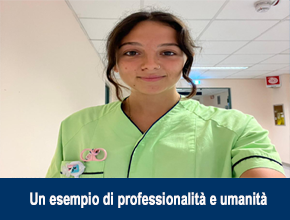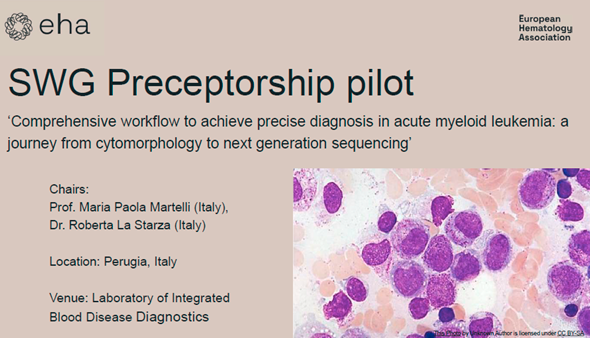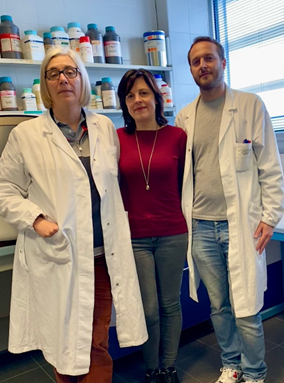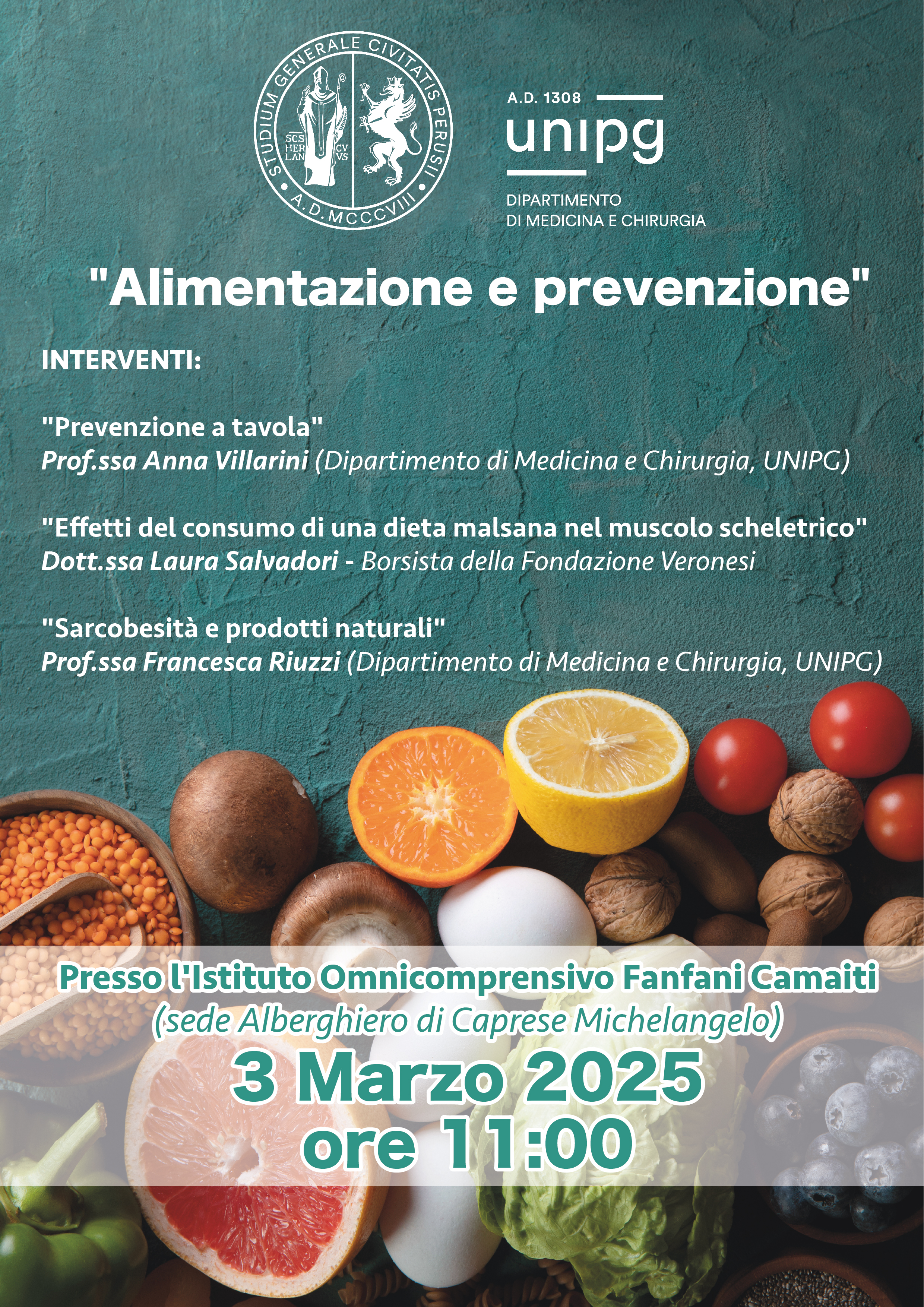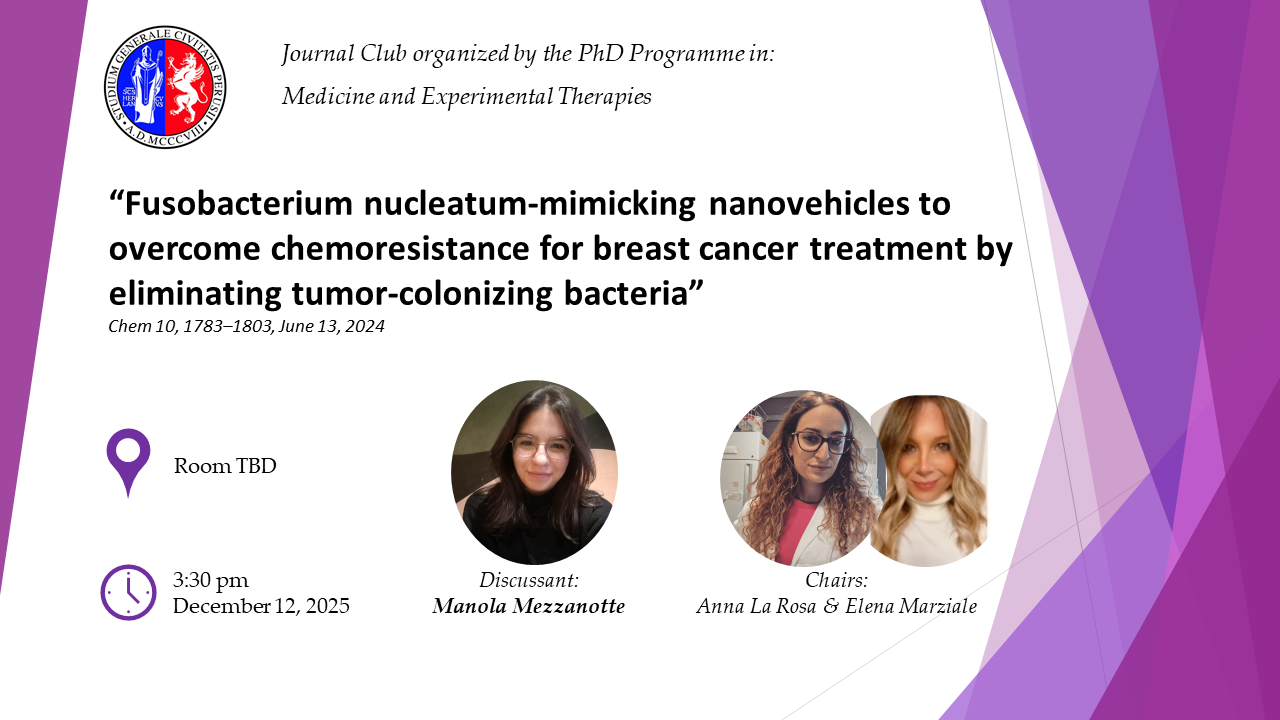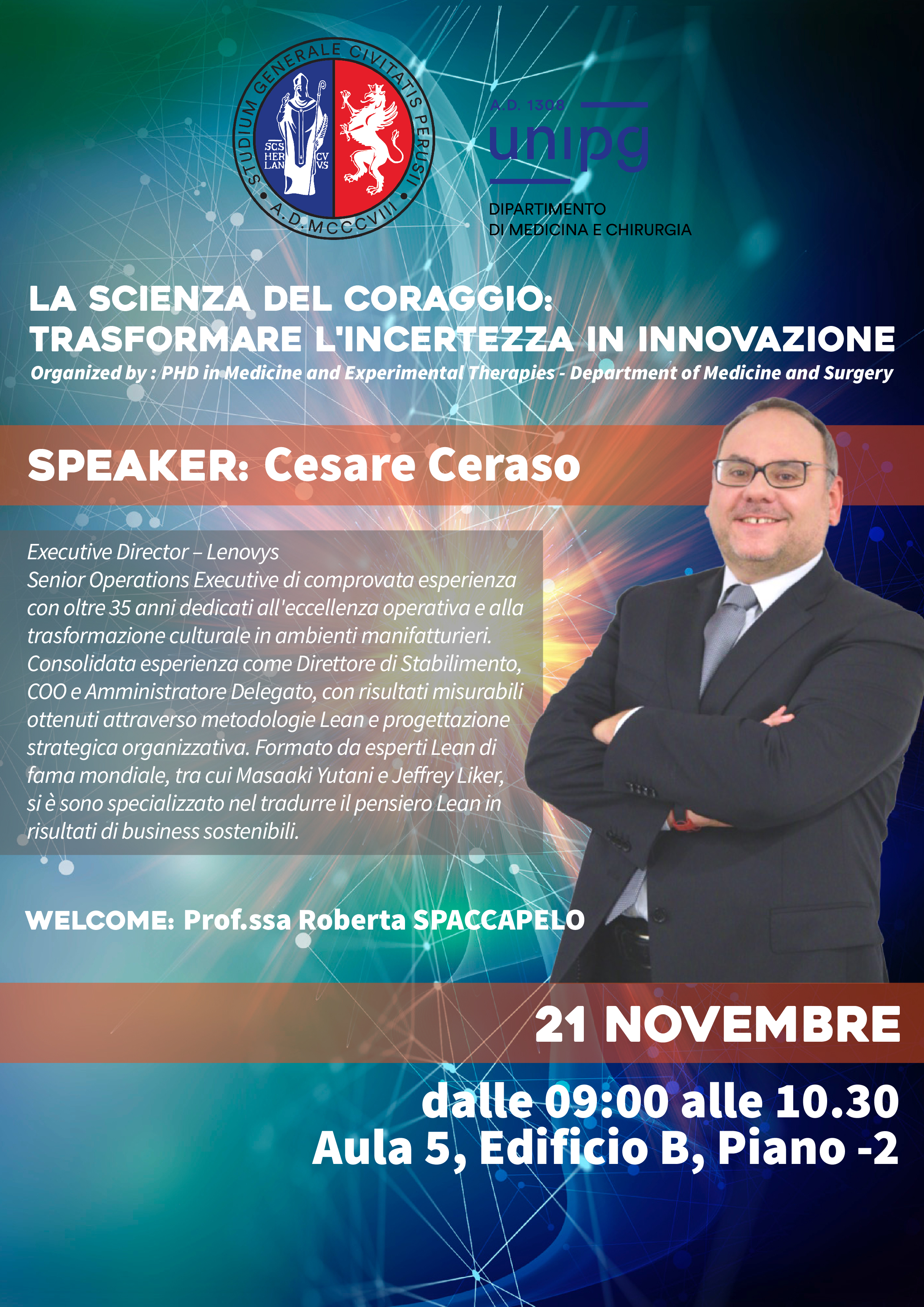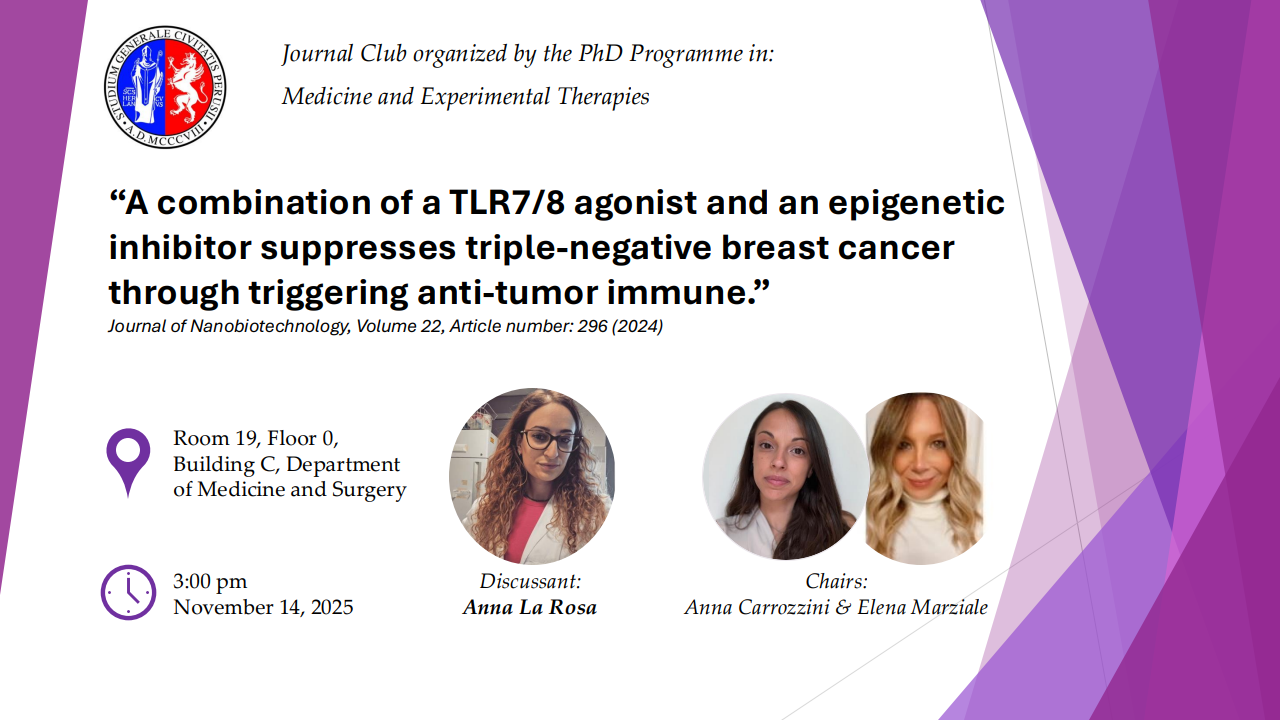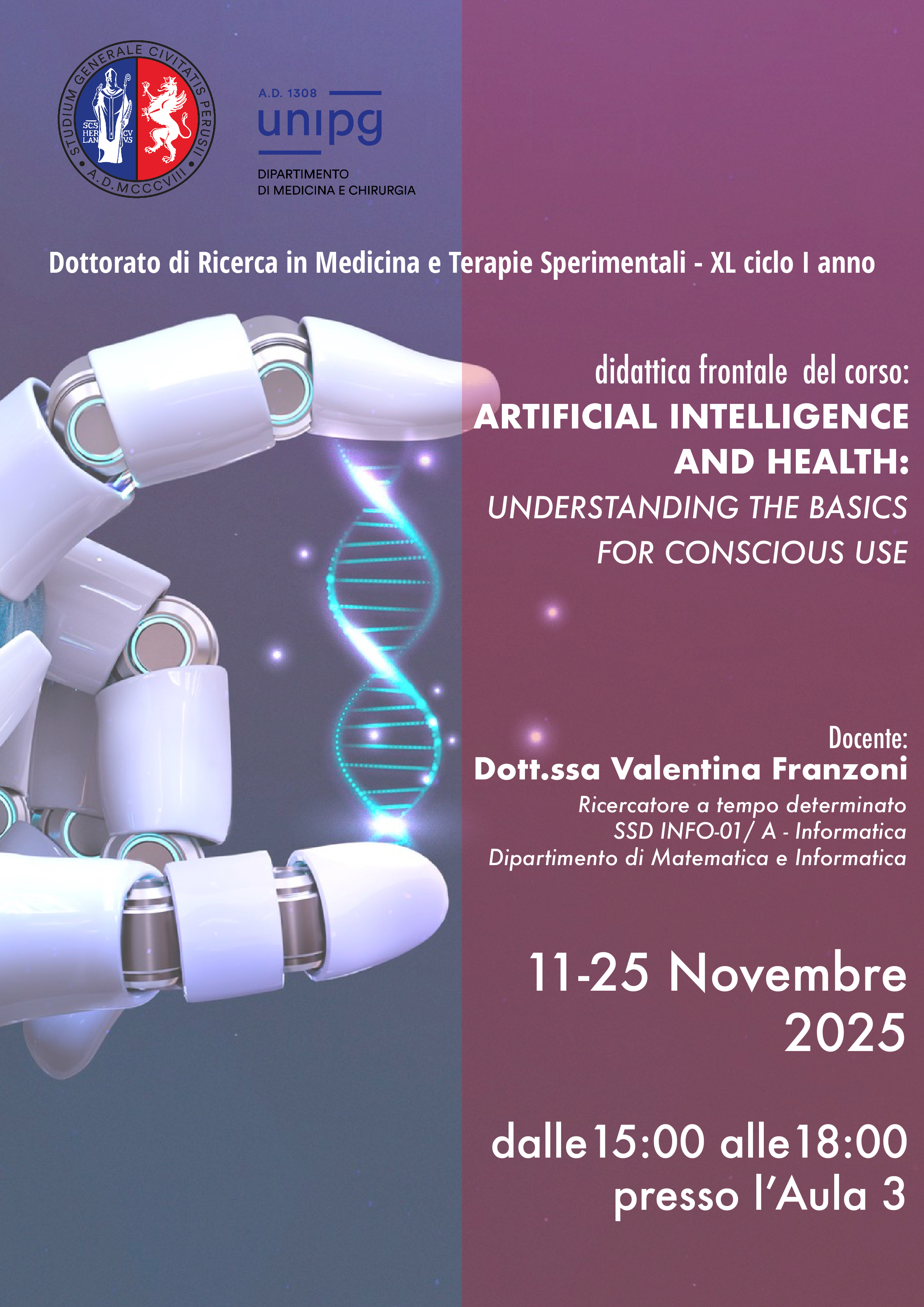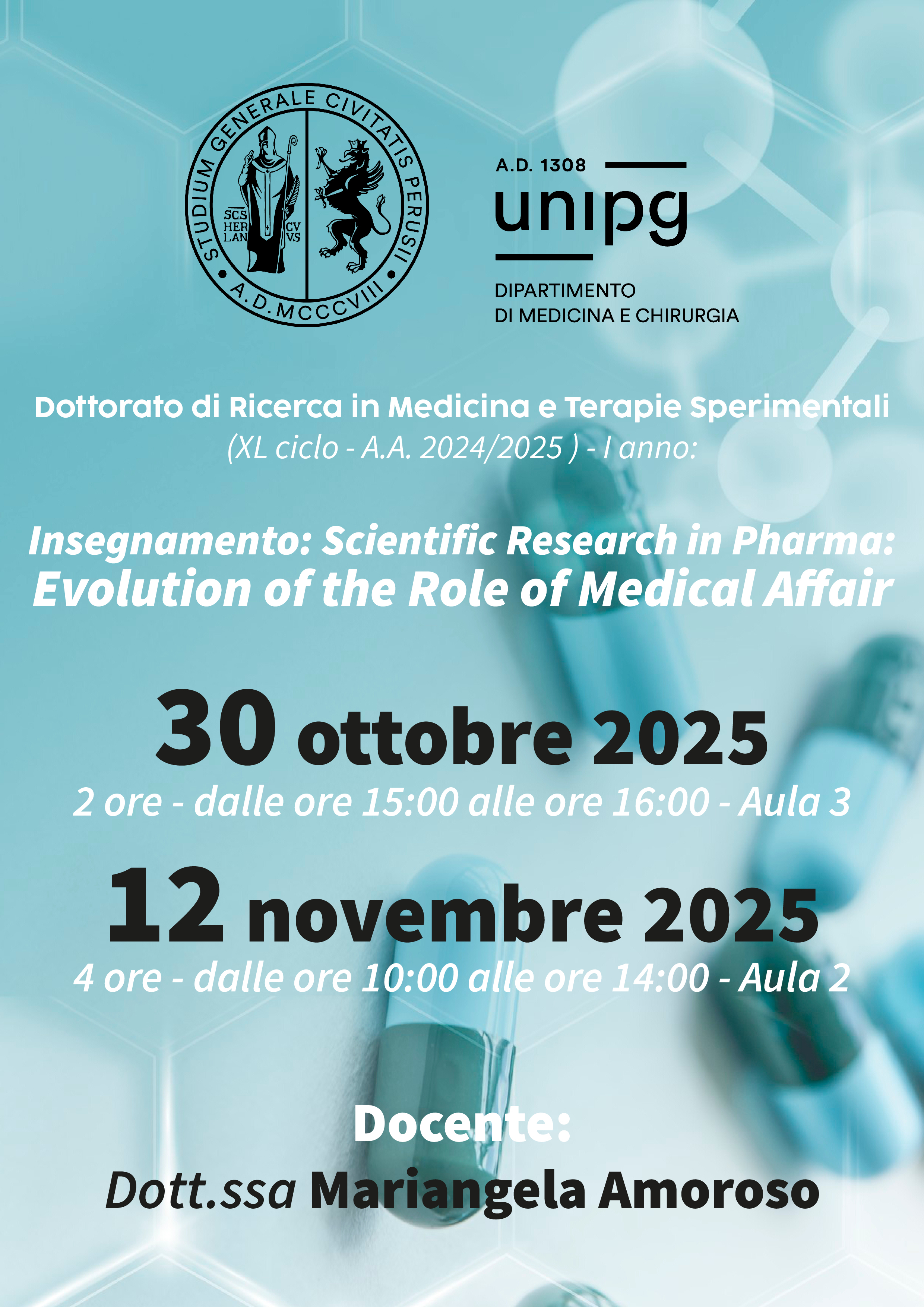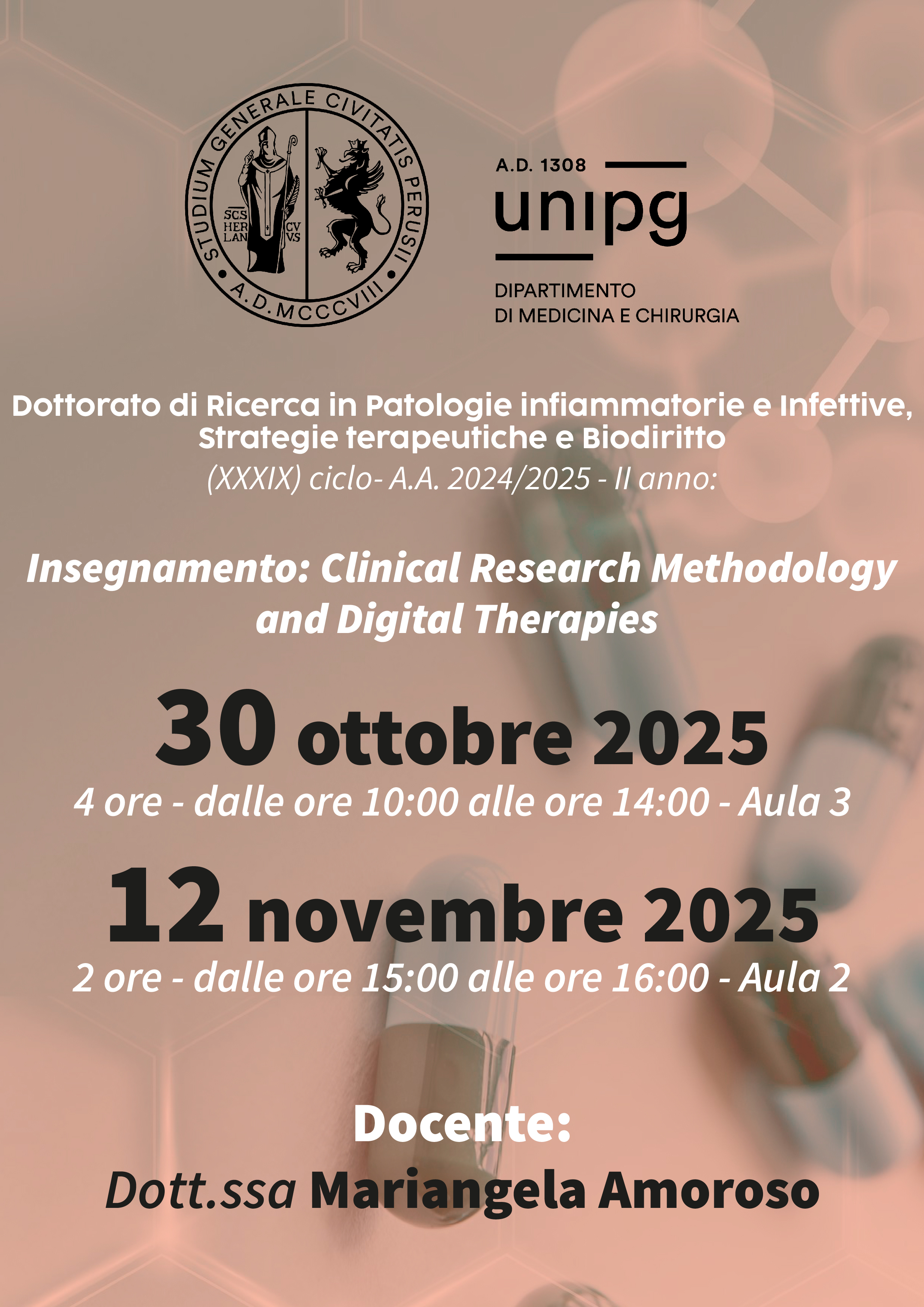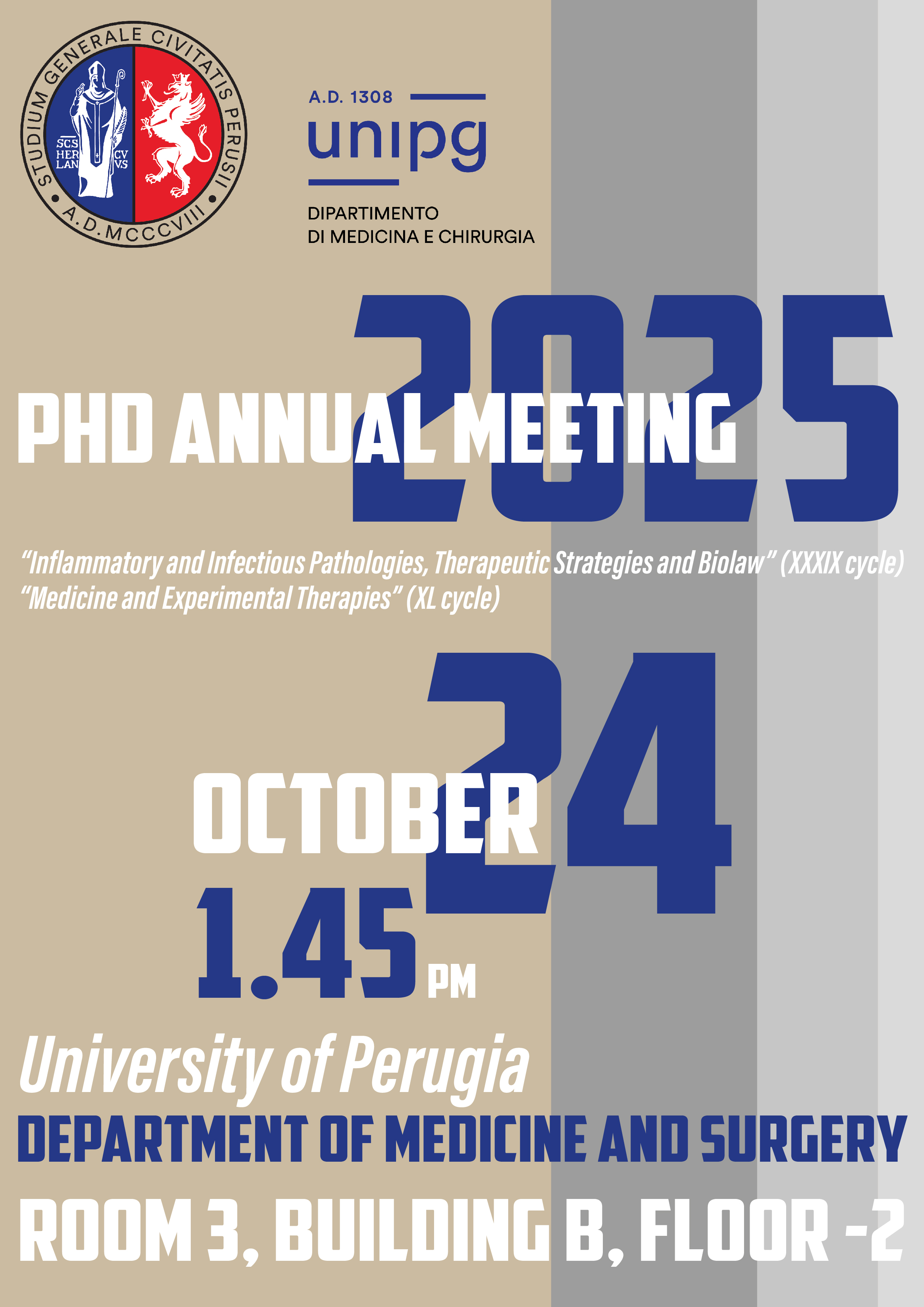- Dettagli
- Scritto da Andrielli Gianluca
L’Area Comunicazione utilizza diverse piattaforme digitali per garantire una diffusione capillare ed efficace delle informazioni: · Sito web del Dipartimento (dimec.unipg.it): per aggiornamenti su eventi, didattica e attività di ricerca;
- Sito web del Dipartimento (dimec.unipg.it): per aggiornamenti su eventi, didattica e attività di ricerca;
- Facebook: per la condivisione di eventi, iniziative accademiche e contenuti divulgativi;
Attraverso questi strumenti, ci impegniamo a rendere la comunicazione più dinamica e interattiva, favorendo il coinvolgimento della comunità studentesca e del personale.
- Dettagli
- Scritto da Andrielli Gianluca
Prof.ssa Francesca Riuzzi delegato alla Comunicazione e Presidente della Commissione
Prof. Arcangelo Liso delegato alla Comunicazione
Dottoranda Florinda Apone
Gianluca Andrielli
- Dettagli
- Scritto da Andrielli Gianluca
PRIN 2022
Finanziatore: MUR
Responsabile Scientifico: ANTOGNELLI Cinzia
Finanziamento: € 87.600 €
Durata:2023-2025
Summary: Cystic fibrosis (CF) is a genetic autosomal recessive disease caused by a defect in the CF transmembrane regulator (CFTR) gene. It is a multi-organ disease that affects the glandular secretion system and is mainly associated with a reduced lung function. Chronic inflammation, oxidative stress (OxS) and abnormal susceptibility to infections are pathogenic traits of CF, causing severe tissue damage. Notably, a strong interplay between inflammation and OxS occurs, inducing one another in a precise feedforward loop that aggravates tissue impairment. Although of great interest, anti-inflammatory therapies have shown limited efficacy in CF patients. Therefore, the identification of specific compounds that can reduce both OxS and inflammation (oxinflammation) could be an appealing approach to elaborate novel treatment strategies in this devastating disease. To this aim, the identification of novel pathways underpinning oxinflammation is mandatory. In this project the role of the glyoxalase pathway, consisting of glyoxalase 1 (Glo1) and glyoxalase 2 (Glo2), will be investigated. Why? Since the glyoxalase pathway is involved in the removal of the potent pro-oxinflammatory and glycating agent methylglyoxal (MG), it could represent a potential target to dampen MG-dependent oxinflammation in CF. Importantly, we have recently observed that the expression and activity of Glo1 are defective in murine and human bronchial epithelial cells models of CF upon challenge with Aspergillus fumigatus, a common pathogen in CF, and this is associated with pathogenic inflammation. Moreover, we have shown that anakinra, the recombinant version of the interleukin-1 receptor antagonist and an activator of indoleamine 2,3 dioxygenase (IDO)1, enzyme involved in immune tolerance and dysfunctional in CF, is able to restore Glo1 mRNA expression in CF mice upon aspergillosis, significantly mitigating CF pathogenic inflammation. Finally, in preliminary studies, we observed a concomitant Glo1 down- and Glo2 up-regulation in IDO1 knockout mice infected with A. fumigatus, as compared to A. fumigatus-infected WT mice. These data suggest a possible link between IDO1 and the glyoxalase pathway to be intriguingly explored in CF. The role of Glo2 in CF has never been investigated before. In order to dissect the role of the glyoxalase pathway in CF for the identification of novel targets to treat oxinflammation, we will take advantage of in vitro (CFBE41o-cells transduced with p.Phe508del-CFTR or WT-CFTR), in vivo (CftrF508del and C57BL/6 mice) and ex vivo (HBE cells from CF patients and controls) CF models and controls, both in the absence or presence of A. fumigatus conidia infection, and use Glo1, Glo2 and IDO1 modulators, including bioactive natural compounds. Our goal will be to identify a novel druggable IDO1/Glo1-Glo2-based patho-mechanism to elaborate safe and low-cost pharmacological therapies to dampen CF pathogenic oxinflammation.
Acronyme: BARRIO
Finanziatore: MUR
Responsabile Scientifico: ARISTEI Cynthia
Finanziamento: € 100.231
Durata: 2023-2025
Summary: Breast cancer (BC) is the most frequent type of cancer in women. It is considered strictly linked to different risk factors such as familial history, eating habits, general lifestyle, and hormone replacement. Furthermore, genetics plays a role in a minority of cases. Interestingly, not all cases may be related to the known listed above risk factors. Therefore, in recent years, several groups of researchers have investigated a correlation between patient microbiome and BC. Altered composition of gut and breast microbiome represent a new risk factor in the occurrence of BC and may hinder therapeutic treatment. Moreover, the role of microbiome in the development and maintenance of inflammation, estrogen metabolism, and epigenetic alterations is under investigation. However, studies need to be conducted to exploit the role of microbiome in Radiation Therapy (RT) in BC. The success of BC RT may be dependent on both the microbiome niche in breast tissue as well as in the gut. - Hypothesis Since the sensitivity and outcome of BC therapy is strictly related to the environment, this may be associated with the microbial signature. Modulation of the microbial signature may impact the outcome of BC therapy. Thus, the aims of this proposal are: 1. To identify: a. the microbial signature in BC patient subtypes in a cohort of early stage BC patients b. microbial changes induced during BC treatment c. microbial changes during the evolution of the cancer itself post-RT 2. To correlate the metagenomic signatures with immune profiles of the mammary breast tissue 3. To establish patient-derived organoids, containing immune cells from the tumor microenvironment for validation of the results obtained in the human cohort 4. To establish a mouse model of BC undergoing RT and administered with probiotic and polyphenol treatments to investigate potential in improving BC therapy outcomes - Experimental Design This study employs a two-pronged approach (Fig. 1). A cohort study will be established with BC patients focused on women undergoing breast-conserving therapy. We aim to study both the gut and breast tissue microbiome and understand how BC radiotherapy may impact on the microbiome through the collection of fecal samples, and the 'nipple aspirate fluid' (NAF) during the course of therapy. In addition, tumor specimens from BC patients collected before commencement of therapy will be used for immune signature profiling and the generation of organoids to establish a BC-tumoroids biobank. Healthy breast tissue from women undergoing elective reduction mammaplasty will be used as control for comparison of tumor specimens. Concurrent animal studies will be done to establish a suitable mouse BC model to investigate the potential of probiotic and polyphenol treatment in improving BC radiation therapy outcomes.
Finanziatore: MUR
Responsabile Scientifico: BELLEZZA Ilaria
Finanziamento: € 130.451
Durata: 2023-2025
Summary: Age-associated chronic diseases are placing a tremendous burden on healthcare systems. The dissection of mechanisms driving aging and the development of novel therapeutics are urgent needs. Aging is characterised by the loss of stem cells (SCs) regenerative capacity which impairs the ability to respond to stress. However, physiological aging, which does not always result in age-associated diseases, differs from accelerated aging, which compromise tissue functions later in life. Thus, a cellular model recapitulating accelerated SCs aging will permit to delineate the molecular signature of age-associated diseases. In this scenario, oral mucosa derived epithelial SCs (OMESCs) from patients affected by EEC syndrome, represent a valuable resource since they undergo an accelerated aging process. All cells, including SCs, produce and secrete extracellular vesicles (EVs), membrane-enclosed particles devoted to cell-cell communication. EVs cargo composition is affected by the aging process. Our project aims to analyse EVs derived from SCs at different aging stages and their potential to control the behaviour of immune, endothelial and SCs to identify molecular pathways to be tackled for assuring healthy aging. To reach these goals, the project will be divided in 4 work packages (WP) developed by two research units (RUs) based in University of Perugia and University of Padua. Fondazione Banca degli Occhi del Veneto ONLUS, providing OMESCs cells for functional analyses and their conditioned medium for EVs isolation, will be involved as subunit. In WP1 we will perform the analysis of OMESC at different aged stages and the characterization of their EVs. We will obtain a deep miRNomic and proteomic characterization of EVs from OMESCs at different stages of aging. In WP2 we will elucidate whether OMESC-EVs differentially alter inflammatory responses and endothelial cell fitness. In WP3 we will define the role of OMESC-EVs on corneal keratinocytes fitness. In WP4 we aim to identify molecular candidates for the observed effects, paving the way for the identification EVs-carried molecules that can be recognized as targets for the prevention of aging-associated diseases. This project is expected to give important insights into the involvement of EVs in the mechanisms of aging induced by the accelerated epithelial SC aging. The novelty of this project resides in the molecular and functional characterization of EVs isolated from a model of prematurely aged SCs. The extensive functional portrait of the EVs from our cell models, will contribute to understand the effects on target cells which, together with the deep molecular characterization of the EVs cargo will be fundamental to define the molecular cargo selectively included in EVs during the aging process. The discovery of the EVs molecular signature of aging may allow the identification of druggable pharmacological targets and propose EVs administration as cell-free option to prevent accelerated epithelial aging.
Finanziatore: MUR
Responsabile Scientifico: BIAGIOLI Michele
Finanziamento: € 120.000
Durata: 2023-2025
Summary: In the last decades the onset of several chronic inflammatory disorders is increased in the worldwide population due to unhealthy lifestyles, genetic predisposition or immune system malfunction. Inflammatory bowel disease (IBD), encompassing ulcerative colitis (UC) and Crohn’s disease (CD), is a chronic condition that displays relapsing-remitting chronic inflammation of the gastrointestinal tract. Although the aetiology of IBD remains largely unknown, its pathogenesis is associated with dysregulated immune responses that drives a persistent inflammatory state within the intestinal mucosa. The clinical course of this disease has shown to be variable and often difficult to manage. Furthermore, IBD increases long-term risk of developing colitis-associated cancer. Currently, there is no definitive treatment for this disease therefore the discovery of new targets, involved in the inflammatory process, and new chemical entities able to interact with them represents an important starting point for our proposed drug discovery program. Several evidences suggest that gastrointestinal homeostasis is strongly dependent on nuclear receptors (NRs) and G protein-coupled receptors (GPCRs) functions, resulting potential drug targets for therapeutic interventions in patients with IBD. These receptors, such as PPAR, VDR, FXR, RORγt and GPBAR1, play a variety of roles ranging from nutrient absorption and transport, sensing of microbial metabolites, to regulation of immune response and intestinal cell integrity. The present research program is focused on the development of a novel polypharmacology strategy for the treatment of IBD based on the restoration gut anti-inflammatory pathways by targeting some NRs and GPCRs. In particular, we will focus our attention on the discovery of new GPBAR1, RORγt and FXR modulators involved in gastrointestinal inflammation. The proposed project has a multidisciplinary and multi-target architecture combining integrated and complementary expertise in computational methods (virtual screening, molecular dynamics), chemical synthesis and experimental pharmacology evaluations in vitro and in vivo.
Finanziatore: MUR
Responsabile Scientifico: BOCCARDI Virginia
Finanziamento: € 53.768
Durata: 2023-2025
Summary: Aging represents the major risk factor for most chronic diseases, including dementia. At the cellular level, aging is characterized by the accumulation of molecular damages leading to the so-called Age-Related Changes (ARCs). Brain ARCs can lead to cognitive decline, which have been demonstrated to strongly correlate with alterations of functional and structural plasticity at glutamatergic synapses, mostly hosted at dendritic spines. In this context, cellular senescence driven by mitochondrial and bioenergetic defects and telomere biology impairment may play a detrimental role. Two proteins, i.e., LIMK1 and CREB, are hubs on which converge critical molecular pathways involved in synaptic functions and cellular bioenergetics, thus being central for neuronal plasticity and memory. Remarkably, the expression of both LIMK1 and CREB was significantly reduced with age; thus, strategies to correct their functional impairment might help in rescuing cognitive and learning functions. This project gathers research groups entirely composed of young researchers with complementary expertise and skills in the fields of cellular and molecular neuroscience to validate a toolbox of genetically encoded engineered proteins (GEEPs), whose activity can be controlled in neurons to harness spine plasticity and modulation of transcriptional factors required for memory formation, thus counteracting their age-related loss. The viability of this approach is supported by our preliminary results obtained by engineering LIMK1, a kinase critically involved in actin filament dynamics. Spatiotemporal GEE-LIMK1 activation in organotypic hippocampal slice cultures induced long-term enlargement of dendritic spines and boosted glutamatergic synaptic transmission. Similarly, we developed GEE-CREB to regulate the transcription of specific genes required for memory formation that, in our preliminary data, contrasted some aspects of the neuronal senescence. The proposed strategies are potentially important for both brain research and therapy allowing the control of neuronal activity by targeting cells with exogenous inert proteins that are engineered to respond selectively to a small-molecule agonist. Moreover, the use of a safe and well-tolerated clinically approved agonist such as rapamycin that i) crosses the blood-brain barrier, ii) activates the engineered proteins and iii) has well-known slow-aging beneficial effects, represents an additional strength of our proposal. To achieve our goal, we will test the ability of GEEPs to boost intracellular signaling regulating synaptic plasticity in living neurons (AIM1). Then, we will validate, in vivo, the therapeutic potential of GEEPs in aged mice characterized by cognitive deficits and synaptopathy (AIM2). Since brain aging still lacks efficacious pharmacological treatments, our study will boost further research into next-generation genetically encoded drugs as novel therapeutic strategies for brain aging and related cognitive decline.
Finanziatore: MUR
Responsabile Scientifico: BRUSCOLI Stefano
Finanziamento: € 100.500
Durata: 2023-2025
Summary: Immune thrombocytopenia (ITP) is the most common childhood piastrinopenia, caused by immune platelets destruction. It is characterized by immune system and inflammatory response compromise, determined by a prevalence of M1 pro-inflammatory macrophages and Th1 lymphocytes, and also mesenchymal stromal cells (MSCs) impairment. MSCs have immunosuppressive and anti-inflammatory properties. ITP MSCs are strongly impaired. Glucocorticoids (GCs) are the mainstay therapy for pediatric ITP with long term side effects. GCs regulate innate and adaptive immunity cells and also MSCs. GCs effects are in part mediated by Glucocorticoid-Induced Leucine Zipper (GILZ). MSCs produce secretome, constituted by cytokines, proteins, and extracellular vesicles (EVs). EVs contain several molecules, among them miRNAs, and are involved in several physiological and pathological conditions. MSCs-derived EVs (microvesicles (MVs) and exosomes) have been tested in inflammatory or autoimmune diseases. Our study aims to identify a novel and safety therapeutic strategy for pediatric ITP using MSC-derived MVs loaded with miRNA involved in ITP pathogenesis. We will enroll newly diagnosed ITP patients and healthy donors (CTR) to obtain MSCs, lymphocytes and macrophages. We will isolate and characterize MVs from CTR-MSCs and ITP-MSCs secretome and obtain in vitro co-cultures (CTR and ITP-MSCs-derived MVs with ITP lymphocytes and macrophages). We will analyze cytokines release, lymphocytes viability, cell cycle progression and phenotype switch, and macrophages phenotypes. We expect to observe an alteration of MSC-derived MVs in their immunomodulating and anti-inflammatory properties in pediatric ITP. We will perform a small-RNA sequencing of CTR and ITP MSC-derived MVs to identify differentially expressed miRNAs, potentially responsible for observed functional alterations and we will transfect these MVs with identified miRNAs (miRNA-loaded MVs). They will be used to realize co-cultures with ITP macrophages and lymphocytes, and then we will evaluate viability, cell cycle progression, cytokine release and phenotype switch on lymphocytes and macrophages. We expect to observe an amelioration of immune and inflammatory profiles. We will also compare miRNA loaded MSC-derived MVs effects with ITP standard therapy. We will perform in vivo experiments on ITP passive murine model, injecting miRNA-loaded MVs and then monitoring disease progression. We will test whether combinatory therapy with GCs and miRNA-loaded MVs will induce an improvement of the parameters for the remission of the disease. Moreover, we will test whether deletion or over-expression of GILZ in the ITP mouse model affects the MSC-derived MVs composition. We expect that miRNAs expression in MSC-derived MVs is regulated by GCs and dependent by GILZ. This study will be the first one investigating the role of miRNA-loaded MVs in pediatric ITP.
Finanziatore: MUR
Responsabile Scientifico: CELLINI Barbara
Finanziamento: € 72.144
Durata: 2023-2025
Summary: Kidney stones, most of which are formed by calcium oxalate, affect up to 10% individuals worldwide. Oxalate is a metabolic end-products excreted by urine. High urinary oxalate concentrations lead to hyperoxaluria, which thus represents a major risk factor for kidney stones. The amount of urinary oxalate depends on both endogenous production and exogenous absorption by dietary intake, both of which could be impaired leading to pathological conditions. Indeed, increased endogenous oxalate formation, due inherited deficits of enzymes involved in the hepatic metabolism of the oxalate precursor glyoxylate, leads to Primary hyperoxaluria (PH). On the other hand, increased intestinal absorption of exogenous oxalate, e.g. due to fat malabsorption, leads to secondary hyperoxaluria (SH). In other cases hyperoxaluria is idiopathic and causes recurrent kidney stones or contributes to the onset of end-stage kidney disease (ESKD) in other pathologies. Thus, the identification of genetic biomarkers influencing the onset and/or the progression of hyperoxaluria represents an unmet medical need. Our project combines molecular, preclinical, and clinical approaches to (i) investigate the biochemical effects of genetic variations on proteins involved in oxalate metabolism, (ii) unravel their association with the onset and/or evolution of hyperoxaluria, and (iii) pave the way for new therapies in patients at risk. By whole exon sequencing analyses of different cohorts of patients we will investigate if genetic variations of genes involved in hepatic oxalate metabolism (AGXT1, AGXT2, GRHPR, HOGA1, and HAO1), exogenous oxalate transport (SLC26A1, SLC26A3, SLC26A6, SLC4A1) or both, could represent risk factors for the onset of SH, modulate severity and progression of PH, and affect the onset of idiopathic hyperoxaluria and ESKD, respectively. We will perform a detailed analysis of the effects of the identified genetic variations at protein level with multiple approaches ranging from analyses in silico and experiments in purified proteins to cellular models mimicking the natural environment of each protein. We will then pave the way for the development of a new treatment approach based on the use of an available engineered form of oxalate decarboxylase (EngOxDC), showing highly improved stability under physiological conditions. We will test the ability of EngOxDC to degrade both exogenous and endogenous oxalate, using an in-vivo model of SH or ex-vivo models of PH, respectively. The complementary background of the participating units and their previous collaboration, along with the expertise in the field and solid preliminary data, guarantee project feasibility. The expected results will have important relapses for a better understanding of oxalate metabolism and inter-individual variability in hyperoxaluria, the identification of patients at risk, and the development of new treatment strategies that could prevent or mitigate the symptoms.
Finanziatore: MUR
Responsabile Scientifico: DI SANTE Gabriele
Finanziamento: € 64.000
Durata: 2023-2025
Summary: Even if they are pretty homogeneous as for histology (more than 90% are squamous cell carcinomas, SCC), head and neck cancers, altogether the 6th most frequent malignancy worldwide, are a very heterogeneous group of tumors. The most relevant heterogeneity factor is primary site. In the present project, we focus on SCC of the oral cavity (OSCC), whose prognosis slowly slightly improved in the last decades, in association with refinements in surgery, which remains the mainstay of treatment, and multimodality treatments. However, differently from oropharyngeal SCC, with an inclusion of molecular markers, and in particular HPV, in the diagnostic work up and staging, predictors presently in use for OSCC are only “classical” clinical and histopathological ones. This configures an unmet need of additional predictors in OSCC. The oral cavity harbors one the most diverse microbiota including more than 770 species of bacteria. Some of them have been associated with certain cancers, as is the case of Fusobacterium nucleatum (Fn), a species highly represented in the oral cavity, in colorectal cancer (CRC). An association of Fn also with OSCC has been reported. However, when it comes to prognostic prediction, the Fn role seems opposite. In fact, recently two different groups independently reported consistent results concerning a protective role of Fn in patients with OSCC, with a better prognosis and a markedly reduced nodal metastatic potential in cases with a higher representation of Fn in tumors. These findings support a role of microbiota, and of Fn in particular, in influencing the interaction of immune cells with tumor cells, which has been postulated to play a pivotal role in OSCC progression. Indeed, a novel histopathologic classifications of OSCC has been proposed based on the assessment of the inflammatory and lymphocytic cell infiltrates as a part of their grading system (immunoscore), with a promising prognostic value in early mobile tongue cancer. The goal of the present project is to look for novel reliable risk factors, predictors and prognostic markers by defining the role of microbiota and associated immune profile as determinants of progression of OSCC. We aim at these targets by defining changes in microbiota among precancerous lesions, small and bulky OSCC, and normal mucosa of the same areas, to obtain information about its role as cause or consequence of tumor progression. Patients and controls will be enrolled, evaluated, treated and followed up according to the main international guidelines, in a multidisciplinary setting, with a standardized prospective data collection. Swabs, blood, primary tumor and lymph node samples will be obtained. We will evaluate the impact of oral microbiota on the immune system in OSCC patients. Finally, we will analyze correlation of microbiota and associated immune responses with known relevant clinical and histopathological parameters and ultimately with prognosis.
Finanziatore: MUR
Responsabile Scientifico: FALLARINO Francesca
Finanziamento: € 116.000
Durata: 2023-2025
Summary:Protein and Gene Therapies (GT) are innovative treatment options for numerous diseases, with several products recently receiving market authorization. The hosts immune response to delivered proteins, vectors, and transgenes, however, remains a major obstacle, with knowledge of the major pathways regulating this response, lacking. To overcome current obstacles in this field, a joint effort by expert scientists from various disciplines is needed. Hemophilia A (HA), a hemorrhagic disorder mainly caused by F8 gene mutations, is being extensively approached by protein and GT and represents an ideal model to address these issues. One of the most challenging complications (>35–40%) is the development of inhibitory alloantibodies against the infused FVIII protein, and the immune response to viral vectors and F8 transgene following GT. The TolerEight project, based on the collaboration of 2 scientific teams with interdisciplinary expertise in gene therapy and immune response in HA, aims to join forces to conduct an ambitious research program that will lead to the identification of the key cellular and molecular mechanisms involved in long term acceptance of advanced therapies for HA. TolerEight will achieve this by taking advantage of state-of-the-art methodologies, innovative tools, and in vivo preclinical models, including new GT vectors targeting F8 to specific tissues or cells, Tg mouse models for HA expressing trace amounts of residual FVIII, and innovative conditional mouse models devoid of selected cells and immune cellular pathways. Our interdisciplinary approach aims at deciphering intra-and intercellular signaling synergies involved in immune tolerance to the successful and durable FVIII therapies. Specifically, Tolereight aims at: i. defining the role of antigen-presenting cells (APCs) and checkpoint pathways in the immune response to FVIII following FVIII protein replacement and GT; ii. dissecting the impact of residual FVIII expression in anti-FVIII immune responses following protein and gene replacement therapy; iii. to translate the experimental findings to HA patients. If successful, even in part, the project will provide a roadmap that will advance both basic and translational knowledge on the major molecular and cellular determinants of immune responses to FVIII protein and gene replacement therapies for HA. This in turn will help in predicting the immune response and favor immune tolerance tailored to FVIII patients. Further, these findings may also offer hope to many other genetic disorders in the development and optimization of future innovative therapeutic strategies, with significant benefits for both patients and national healthcare systems.
Finanziatore: MUR
Responsabile Scientifico: FRANCISCI Daniela
Finanziamento: € 37.279
Durata: 2023-2025
Summary:Despite massive worldwide vaccination, SARS-CoV-2 infections still occur at a high pace. Repeated vaccine doses protect most individuals from severe disease, however protection from infection is suboptimal. Thus, viral spread remains sustained by both unvaccinated and vaccinated individuals, with morbidity and mortality driven by local differences in vaccine coverage. Factors contributing to the limited success of vaccination include (i) rapid waning of natural and artificial immunity to coronaviruses, (ii) newly emergent SARS-CoV-2 variants with increased adaptation to humans and (iii) use of obsolete vaccine preparations based on the ancestral Wuhan wild type viral strain from which subsequent SARS-CoV-2 variants have substantially diverged. Indeed, SARS-CoV-2 has shown a striking ability to evolve into newly divergent variants which may become dominant in a matter of weeks, challenging the strategy of updating vaccines to cope with virus variability. Antiviral treatments have become available, mostly in the last few months, as an eagerly awaited complement to vaccination. These include monoclonal antibodies (mAbs) and direct acting antivirals (DAAs), both to be administered within a few days from diagnosis to people at risk of progression to severe disease. In addition, one mAb cocktail has been approved as pre-exposure prophylaxis in high-risk subjects who are unlikely to mount an adequate immune response to COVID-19 vaccination or for whom COVID-19 vaccination is not recommended. In light of SARS-CoV-2 variability and evolution, it is crucial to define the activity of mAbs and DAAs against current and future viral variants as well as the potential for viral resistance to such treatments. This proposal aims at investigating the following areas: 1. Activity of mAbs and DAAs vs. SARS-CoV-2 variants in vitro 2. Genetic barrier to resistance to mAbs and DAAs in vitro 3. Emergent resistance to mAbs and DAAs in vivo 4. Persistence of mAb activity in vivo over time The first two activities will be performed at the University of Siena (UNISI) where prototype viral variants, anti-SARS-CoV-2 DAAs and mAbs are available and dedicated lab assays have been developed. Activities 3 and 4 will be performed through observational studies led by researchers at the University of Padua (UNIPD) and Perugia (UNIPG) who have been extensively involved in SARS-CoV-2 clinical research. Importantly, the three academic groups have been collaborating for more than one year in this research area, thus connections functional to the conduct of the study are well established. Gaining knowledge in the above areas is fundamental to define the role of anti-SARS-CoV-2 treatment as a complement of the continued global vaccination campaign. In addition, the combined investigation of natural and drug-selected virus variability will be an extraordinarily effective way to define the viral genetic space and the potential for virus evolution in the upcoming years.
Finanziatore: MUR
Responsabile Scientifico: LA STARZA Roberta
Finanziamento: € 96.141
Durata: 2023-2025
Summary: Besides their role in haemostasis and thrombosis, blood platelets are the first sentinels against microbial infection and rapid responders to pathogen entry with important functions in primary immunity. However, when their reactions go beyond physiologic functions they give rise to thromboinflammation (TI), a pathological condition in which inflammation and thrombosis reinforce each other. TI is the major determinant of severe sepsi-associated complications, like disseminated intravascular coagulation and organ failure, which correlate with high morbidity and mortality. TI is started by complex interactions between platelets, leukocytes, endothelial cells (EC), and the innate immune system. The unravelling of the molecular mechanisms of these interactions is crucial for the development of novel therapeutic strategies to reduce sepsis-associated mortality. While several studies have explored the receptors involved in these interactions, little information is available on the intracellular signalling pathways that regulate these events, and some clues suggest that the proline-rich tyrosine kinase Pyk2 may play a central and multifaceted role. We have previously shown that Pyk2 is a crucial intracellular mediator of platelet activation and thrombus formation. Pyk2 is also involved in acute and chronic inflammation and preliminary unpublished data by the proponents indicate a role of Pyk2 also in TI-driven systemic infection. In this project we plan to get deeper insights into the mechanisms of generation and progression of TI in sepsis focusing on the roles of Pyk2 in platelets, leukocytes and EC and in their reciprocal crosstalk. To this aim two Research Units, with complementary and integrated expertise and previous successful collaborations, will investigate the role of Pyk2 in TI using a translational approach that conjugates cellular biochemistry and cell biology experiments, in vivo mouse models, and clinical studies. The project will be divided into 3 workpackages aiming to: 1) explore the role of Pyk2-dependent signalling in platelets and in their crosstalk with leukocytes and EC. The generation of proinflammatory and prothrombotic mediators during TI will be analyzed. This WP will be carried out using advanced biochemical, cell biology and cell imaging techniques, and will take advantage of validated Pyk2-specific pharmacological inhibitors and selective miRNA. 2) investigate the role of Pyk2 in two complementary murine models of sepsis in vivo: endotoxemia and cecal ligation and puncture models. This WP will be realized using Pyk2 knockout mice and ad hoc generated chimeric mice. 3) clarify the contribution of Pyk2 in human sepsis-associated TI by analyzing Pyk2 expression and activation in platelets from septic patients Our results will help to identify novel therapeutic targets for the improvement of sepsis-related outcomes and the prevention of sepsis-associated thrombotic complications.
Finanziatore: MUR
Responsabile Scientifico: MARINUCCI Lorella
Finanziamento: € 62.500
Durata: 2023-2025
Summary:Low socio-economic status is related to sanitary vulnerability, particularly in relation to oral diseases. Dental caries, the most common non-communicable disease, are more severe in vulnerable populations. To protect and treat these patients, specialized intervention strategies have been established to achieve good results quickly and with low-cost materials. These materials can be easily used even with non-cooperative patients, such as Minimally Invasive Treatments (MITs). However, composite resins are the most widely used restorative materials in conservative dentistry for the restoration of therapeutic cavities after caries removal. The composition of these materials has undergone various modifications over the years to improve their mechanical and aesthetic properties. However, given the possibility of recurrent caries due to bacterial infiltration at the margin between the restoration and the tooth, it is important to evaluate the addition of antibacterial molecules to the composition of these restorative materials. This would improve the condition of socio-economically vulnerable patients, who are more prone to secondary caries, as well as "special needs" patients. This study aims to determine the optimal concentration of silver-based agents to obtain a composite that combines good antimicrobial and mechanical properties.
Finanziatore: MUR
Responsabile Scientifico: MARTELLI Maria Paola
Finanziamento: € 112.000
Durata: 2023-2025
Summary:DNMT3A mutations (mDNMT3A) are one of the most frequent genetic alterations of the epigenetic modifiers in acute myeloid leukemia (AML). mDNMT3A are found in age-related clonal hematopoiesis, act as loss-of-function (LOF) mutations and are pre-leukemic genetic lesions. In murine models, knock-out (KO) of DNMT3A in hematopoietic stem cells (HSCs) confers in vivo immortality, with a self-renewal potential far exceeding that of normal HSCs, and a gradual and focal losses of DNA methylation in regions associated with self-renewal genes, recapitulating the effects of mDNMT3A in human diseases. However, human models of mDNMT3A-driven leukemogenesis are lacking. Due to its role in AML development, great efforts are made to develop drugs targeting mDNMT3A, although its value as therapeutic target needs to be proven. In this setting, our project is timely and addresses key unanswered questions: i) can DNMT3A mutant be considered a valid therapeutic target in AML?; ii) is DNMT3A mutation associated with a specific pharmacogenomic profile?; iii) how DNMT3A LOF condition the normal human HSCs? Aiming at validating DNMT3A as target for therapy, we have recently applied CRISPR-based genome editing to correct the DNMT3A mutated gene into wild-type n the OCI-AML3 AML cell line, carrying DNMT3A-R882C mutation, and found no significant differences between the edited and parental clones in terms of leukemia growth, either in vitro or in vivo in xenograft immunocompromised mice, suggesting that leukemia disengages from the mutation. Therefore, our hypothesis is that whilst on one side mDNMT3A may condition acquisition of new mutations, AML onset and response to drugs, on the other side they may be not essential for maintenance of AML, once this has established. The project is organized in 4 main work packages (WP). In WP1, CRISPR-based genome editing will be used to correct mDNMT3A in different human AML cell lines. Cell lines models will be then functionally studied both in vitro and in vivo and deeply characterized. In particular, methylation, transcriptomic and epigenomic/epitrascriptomic profiles will be analyzed using standard approaches and third-generation long-read sequencing (LRS). Results will be validated in 3 patient-derived xenograft (PDX) models of DNMT3A-mutated AML by CRISPR-based DNMT3A KO followed by re-expression of DNMT3A wild-type by lentiviral infection. In WP2, we will screen the above models for FDA-approved/epigenetic drugs libraries to identify an eventual mDNMT3A-associated pharmacogenomic profile. In WP3, CRISPR-based DNMT3A KO (mimicking DNMT3A LOF mutations) will be performed on human HSCs, and cells will be serially transplanted in mice and studied overtime in order i) to dissect time-dependent changes induced by DNMT3A KO in human hematopoiesis, ii) to capture the eventual spontaneous onset of secondary mutations, and iii) to evaluate whether human AML develops. In WP4, results will be validated in a cohort of AML patients.
Finanziatore: MUR
Responsabile Scientifico: MEARINI Ettore
Finanziamento:€ 136.650
Durata: 2023-2025
Summary:Renal cell carcinoma (RCC) represents about 3-5% of all tumors, and Western countries account for 50% of the global incidence. In 2020, over 430,000 cases of RCC were diagnosed worldwide and about 180,000 people died from this disease. About 70% of RCCs showed clear cell RCC (ccRCC) as a widespread histological type. Currently, due to lack of symptoms at early stages, about 60% of RCC are diagnosed occasionally by imaging and about 20% are metastatic already at diagnosis, affecting patient survival. Recently, it has been proved that microRNAs (miRNAs) can be a potential marker for several types of cancer including RCC. MiRNAs are a class of small non-coding single-strand RNAs inhibiting RNA translation and promoting RNA degradation. Interestingly, the role of miRNAs in cancer and their stability in biological fluids make them promising biomarkers for cancer diagnosis and prognosis. In 2020, we have published a new method for the diagnosis of ccRCC based on the evaluation of urinary miR-122, miR-1271, and miR-15b in a discovery cohort. Afterward, these promising results have been also confirmed in an independent validation cohort that were published in 2022. This project aims to improve the above-mentioned method for diagnosis and prognosis by evaluating in the urine (1) the levels of miR-122, miR-1271, and miR-15b and other three urinary miRNA (miR-15a, miR-210, miR-let-7b) in ccRCC patients and healthy subjects by the use of Reverse Transcription and quantitative real-time PCR (RT-qPCR); (2) the levels of other miRNAs selected by Microarray Assay in different subtypes of RCC. The enrollment will include 300 patients in 18 months. The recruited population will include 160 patients with any histological RCC, 60 patients with benign renal mass, and 80 healthy controls. Each subject will withdraw urine in the routine visits. The urine collection from patients will be performed before surgery, 5 and 25 days after surgery, and then at 3, 6, 12 e 18 months of follow-up. To further improve the method and identify a specific panel of miRNAs associated with different renal cancer histological subtypes, Microarray Assay will be carried out in urine samples from patients with these tumor subtypes. Finally, the best miRNAs, selected by Microarray Assay, will be validated by RT-qPCR on a larger number of patients. The selected panel of miRNAs in the urine will be included in an algorithm for the following purposes: 1) to make the diagnosis of RCC; 2) to correlate the miRNA levels with tumor staging including the presence of metastasis, 3) to correlate the miRNA levels with the diagnosis of local and distant recurrence during the follow-up. Therefore, the final objective of the project is to develop a new diagnostic and prognostic tool for RCC that would be inexpensive (RT-qPCR-based) and could be performed on easily available biological materials through non-invasive techniques.
Finanziatore: MUR
Responsabile Scientifico: MECOCCI Patrizia
Finanziamento:€ 138.000
Durata: 2023-2025
Summary: Dementia is the main cause of disability in older adults, currently affecting about 50 million people worldwide with this number estimated to triple in the next 30 years. The preclinical stage, Mild Cognitive Impairment (MCI), has become a major research focus for prevention and treatment. The identification of pathways within the biology of aging represents an important endpoint for the development of novel effective disease-modifying drugs in the field. In recent years metformin (MET), which is the recommended first-line oral therapy for the treatment of type 2 diabetes (T2DM) after diet and lifestyle changes, has shown senotherapeutic properties as it prevents cellular senescence and related inflammation. Moreover MET use is associated with a reduced risk of cognitive impairment and dementia in T2DM and pre-clinical data suggest that MET could affect the pathogenesis of dementia beyond its efficacy on glycaemic control. Thus, the identification of key networks that are associated with MET senotherapeutic functions and prevention of cognitive decline is an area of intense research. We aim at investigating whether the MET intervention may attenuate or ameliorate cognitive, physical, and functional performances, and ultimately may positively affect molecules that may be influenced by the aging processes, and so evaluated as possible aging hallmarks, among older adults with MCI, overweight and impaired fasting glycemia. The primary objective of the study is to test the effect of MET compared to placebo on neuropsychological changes in verbal learning and memory using semantic cues, as measured by the Free and Cued Selective Reminding Test (FCSRT). The secondary objectives are to test the effect of MET versus placebo on changes in different cognitive domains, physical and functional performances. Then, as exploratory analyses, we aim to measure metabolic-related molecules, myokines, molecules associated with senescence, cytokines, and chemokines, evaluated in plasma before and after treatment with MET, and to test their association to the clinical variables. Participants are subjects with MCI, aging 55-80 years, overweight (BMI>25 kg/m2), or impaired fasting glycemia (100-125 mg/dl or HbA1c range 5.6-6.4%), recruited in two Geriatric Units. They will be randomly assigned 1:1 to intervention or placebo in double-blinded. The intervention consists of MET tablets extended-release, with a dosage of 500 or 1000 mg once daily as tolerated by participants. The intervention duration is 12 months. During the study period, all participants will attend three visits with comprehensive assessment (baseline, 6, 12 months) and they receive two clinical (month 1 and month 3) and telephone follow-ups for compliance, adherence, tolerability, and safety.
Finanziatore: MUR
Responsabile Scientifico: MIGLIORATI Graziella
Finanziamento:€ 75.520
Durata: 2023-2025
Summary: In recent years, the “heat-not-burn” systems, including IQOS, have grown in popularity as a healthier alternative to tobacco smoke (TS). With the increasing diffusion of electronic cigarettes (e-cig) and the growing consumer discontent due to the absence, or decrease, of the so-called “throat hit” (the physical sensation that one feels down his throat when the smoke flows from the mouth to the lungs), associated with e-cig use, the “heat-not-burn” devices are gaining market shares. For this reason, big tobacco multinationals have thought, in the recent past years, of investing much financial resources in this market. As such, their impact on human health is widely discussed among scientists, leading however to controversial and inconclusive results, thus boosting research to further investigation. In particular, their long-term biological and immunological effects are poorly known, especially in the oral cavity, the first target of exposure. The aim of this project is to compare the biological effects of IQOS with those of TS and e-cig in oral mucosa experimental models and ex-vivo samples. In particular, after performing the characterization of the qualitative and quantitative composition of IQOS and e-cig aerosols as well as of TS: - viability, proliferation, apoptosis, cell cycle, DNA damage, abnormal nuclear morphologies, epithelial-mesenchymal transition (EMT), methylglyoxal (MG)-dependent glycative stress (MGGS), oxidative stress (OS) and inflammation will be evaluated on human oral cell populations (keratinocytes, fibroblasts and osteoblasts) and dental pulp stem cells (DPSCs). In order to mimic a more realistic environment, the same end-points will be also evaluated in human dentin-pulp-like organoids from DPSCs that best reproduce the general tissue architecture, organization and the interconnections to the microenvironment. Finally, the levels of the major enzymes associated with MGGS and OS stress-responses will be evaluated as susceptibility factors to the exposure effects, using saliva and oral mucosa scrab from IQOS versus TS and e-cig users. - in parallel, the immunological effects of IQOS versus TS and e-cig aerosol exposure will be studied on T-cell (sub)populations isolated from peripheral blood and saliva of non-smokers. In particular, cytokines (i.e. IL-17A, IL-21, IL-22, IL-2, IL-4, IL-6, IL-10, TNF-α and IFN-γ) and chemokine production will be assessed together with citrullinated vimentin. - a morphological/functional analysis of oral microvessels will be performed in patients by intraoral video-capillaroscopy to determine potential changes in microcirculation as a marker of oral and systemic diseases in IQOS smokers, non-smokers, TS and e-cig smokers. In the same cohorts, the qualitative and quantitative chemical composition of the exhaled will be studied and related to the TS, e-cig and IQOS aerosols obtained by the smoke machine.
Finanziatore: MUR
Responsabile Scientifico: MONDANELLI Giada
Finanziamento:€ 48.386
Durata: 2023-2025
Summary:Metabolic disease represents a cluster of pathological conditions that increased the risk of developing cardiovascular and metabolic clinical manifestations such as hypertension, heart disease, stroke and type 2 diabetes. It usually manifests with excess body fat, especially around the waist, known as visceral adiposity, abnormal cholesterol or triglyceride plasma levels, hyperglycemia and impaired insulin sensitivity as well as hypertension. Parallel to preferring healthier habits (eating and physical activity), current pharmacological strategies are aimed at reducing the classical risk factors (lipid lowering, anti-hypertensive and glycemic controlling therapies); however, metabolic disorders and their related comorbidities are still one of the main causes of hospitalization, disability and death worldwide with critical consequences on our society This evidence calls basic and experimental research to investigate novel, selected and more effective therapeutic targets by dissecting the molecular pathways involved in metabolic disease. Recent achievements in the filed have elucidated the role of inflammation and effector response mediated by immune cells in the onset and progression of systemic metabolic morbidities triggered by visceral fat accumulation, thus proposing immunomodulation as a complementary approach for the treatment of cardiometabolic diseases. This scenario paves the way to our proposal that will aim at investing the following main objectives: 1) depict the role of metabolic checkpoints on cellular energetic circuits to improve immuno-modulatory response; 2) tuning hypertensive response by vascular-immune-metabolic paths; 3) demonstrate the efficacy of an immunoregulatory cell therapy targeting visceral inflammation to improve metabolic dysfunction and hypertension. To pursue this ambitious goal, a multidisciplinary team with competences in immuno, vascular and metabolic biology has conceived an experimental plan aimed, firstly, to point out the molecular mechanisms responsible of immune alterations, focusing on the metabolic disturbances that impair the modulatory and tolerogenic functions of regulatory T cells (Treg) and dendritic cells, and their effect on vascular remodeling and hypertension. Unveiling these molecular mechanisms will set the stage for testing a cell therapy with functionally engineered Treg to target visceral inflammation as a therapeutic strategy to limit systemic spreading of effector response mediated by immune cells and thus protecting from disease progression. This project will put a step forward in the pharmacological management of metabolic disease, providing the evidence that the recent technological advancements in immunomodulatory therapy, based on cellular genetic manipulations, could be extended for the treatment of patients with metabolic disorders and characterized by an impaired balance between tolerogenic and effector response.
Finanziatore: MUR
Responsabile Scientifico: PALLOTTA Maria Teresa
Finanziamento:€ 100.000
Durata: 2023-2025
Summary:Pancreatic ductal adenocarcinoma (PDA) is still an urgent medical need with little advances in therapy and patient survival. New poly chemotherapy regimens recently employed have been shown to improve outcomes in metastatic patients and also represent an attractive neoadjuvant treatment strategy for locally advanced disease. Targeting the immune system is an active area of research and includes different approaches to improve host immune system fitness. Our preliminary data have demonstrated that DNA vaccination with the tumor associated antigen (TAA) alpha-enolase (ENO1) in association with a Phospho Inositide-3-Kinase (PI3K) gamma (g) and delta (d) subunits dual inhibitor reduced tumor burden in genetically engineered mice that spontaneously develop PDA. We have also shown in an orthotopic PDA mouse model that genetic inhibition of PI3Kg strengthens the anticancer immune response, especially in combination with ENO1 vaccination, and that humoral and cytotoxic specific anti-ENO1 antibody response plays a critical role in influencing the effect of therapy. We have also demonstrated that PI3Kd is recruited to indoleamine 2,3-dioxygenase 1 (IDO1) and has a role in mediating IDO1 signal transduction. In addition, our preliminary data suggest that also PI3Kg is involved in IDO1-mediated signaling events, although it cannot be directly bound to IDO1. Selective inhibitors of PI3Kg and PI3Kd significantly impaired TGFbeta (b)-mediated induction of Ido1 in plasmacytoid dendritic cells (pDCs), while IFNgamma (g) failed to induce IDO1 expression in PDA cell lines derived from PI3Kg deficient mice. These data suggest the existence of a functional relationship between IDO1 and PI3Kg/d in controlling immune response suppression. Therefore, co-administration of PI3Kg/d inhibitors with molecules capable of inhibiting IDO1 activity may increase the rate of success of immunotherapy in PDA. By employing orthotopically injected PDA mouse models, this project aims to i) investigate the mechanisms of action of the PI3Kg/d-IDO1 axis in the control of immune suppression in PDA; ii) select in vitro the more effective combination between PI3Kg/d and IDO1 inhibitors to unleash the immune response to PDA; iii) assess the in vivo effectiveness of the selected PI3Kg/d-IDO1 inhibitors to potentiate anti-tumor effect of therapeutic combination of DNA vaccination; iv)correlate peripheral and infiltrating immune cell subsets and the expression of IDO1 and PI3Kg/d with clinical parameters and response to therapy in mouse model. The accomplishment of this research project will provide information that will impact PDA clinical management and lead to the definition of novel immunotherapy protocol to be easily transferred to the clinical practice.
Finanziatore: MUR
Responsabile Scientifico: PIRRO Matteo
Finanziamento:€ 72.332
Durata: 2023-2025
Summary:Familial Hypercholesterolemia (FH) is one of the most frequent genetic disease. Mutations in LDLR, APOB and PCSK9 genes are responsible for a severe phenotype characterized by very high levels of low-density lipoprotein-cholesterol (LDL-C) since birth, which leads to premature atherosclerotic cardiovascular disease. The aim of this project proposal is to investigate the clinical, genetic and biochemical contributors to the development of atherosclerosis in this patient’s population. Novel players, such as the gut microbiota and the metabolomics, will be explored. The results obtained in the human studies will be confirmed in the LDL-receptor deficient mouse. In this animal model the effects on the experimental atherosclerosis of the microbiota manipulations and the gene therapy will be evaluated. Identification of microbiota components that may reduce atherosclerosis development may lead to new probiotic formulations as well as to the identification of postbiotic that may improve patients’ conditions. Metabolomics may also lead to the identification of novel prognostic biomarkers. 150 Heterozygous FH (HeFH) and 100 Hypercholesterolemic non-FH hypercholesterolemic controls will be enrolled, genotyped for the genetic diagnosis of FH and evaluated for the clinical cardiovascular risk profile. Carotid, aortic and coronary atherosclerosis will be assessed by ultrasonography, echocardiography and coronary artery calcium (CAC) score. A Follow-up visit will be planned in both groups in order to perform a more detailed risk estimation of all hypercholesterolemic patients and an appropriate adjustment of treatment decisions. Among genetic factors, variants able to affect the levels of LDL-C and the atherogenic Lipoprotein (a) will be investigated. In FH patients selected for being outliers in terms of presence/absence of coronary atherosclerosis with a respectively lower/higher risk profile, an extensive genetic analysis of the about 25000 coding genes present in human exome will be performed in order to find novel genes responsible of protection /susceptibility respectively against/to the development of atherosclerosis. The metagenomic, metabolomic and target lipidomic analyses will be applied to both human and animal study populations to provide information on the contribution of a known byproduct of the gut microbiota the trimethyl amino oxide (TMAO) to the atherosclerosis in FH and will assess the role of other novel biochemical species as biomarkers of the atherosclerotic cardiovascular disease. The results obtained will expand the knowledge of the mechanisms underlying the development of the accelerated atherosclerosis in familial hypercholesterolemia and could be translated in the clinical practice. The final outcome of this study proposal will be the improvement of the therapeutic and clinical management of FH patients and the decision-making process in the perspective of increasing the cardiovascular event free survival of these patients.
Finanziatore: MUR
Responsabile Scientifico: RENDE Mario
Finanziamento:€ 54.748
Durata: 2023-2025
Summary: The present proposal aims at conclusively establishing S100B as a key factor, and consequently a therapeutic target, in Multiple Sclerosis (MS), thus becoming the prerequisite for clinical studies. Based on the preliminary results, the rationale of this project is to deepen our understanding of S100B as one of the triggering factors for pathogenesis, with the final goal of highlighting its potential therapeutic use. S100B is a small EF-related Ca2+/ and Zn2+/binding protein, mainly synthesized by astrocytes. It exerts both intracellular and extracellular actions. While a clearly defined intracellular univocal function for this protein has not been delineated at present, astrocyte-secreted S100B is regarded to act as an autocrine, paracrine or even endocrine factor with concentration-dependent effects. In physiological conditions, astrocytes secrete S100B at nanomolar concentration, which exerts a neurotrophic action; under stress conditions, including nervous tissue inflammation, astrocytes secrete S100B at micromolar concentration, which has a neurotoxic effect, behaving as a DAMP molecule. Data have been reported indicating that S100B plays a key role in pathogenic processes - and S100B levels in biological fluids are a reliable biomarker - in a series of neural disorders. Interestingly, in many cases, over-expression/administration of the protein induces worsening of the disease, while its deletion/inactivation produces amelioration of these disorders. Therefore, it is reasonable to hypothesize that high concentrations of S100B may play a promoting role in MS, based on a number of correlative evidence: (i) elevated levels of S100B are detected in the cerebrospinal fluid (CSF and sera of MS patients in the acute phase, being reduced in the stationary phase of the disease); (ii) an increased expression of S100B is identified in both active demyelinating and chronic active MS plaques; (iii) in ex-vivo demyelinating models, a marked astrocytic elevation of S100B is observed upon demyelination, while inhibition of S100B action reduces demyelination and down-regulates the expression of inflammatory molecules. Our proposal aims at deepening the role of S100B and consequently its potential as therapeutic target, in MS, thus becoming the prerequisite for clinical studies. We will focus on selective blockade of S100B molecule using effective neutralizing anti-S100B antibody and S100B constitutive and conditional (restricted to astrocytes) gene ablation. These approaches will guarantee direct and diverse effects on S100B molecule, more specific and complete than those obtained by the drugs (PTM and AA) previously tested in EAE, thus deepening the mechanisms and pathological link between S100B and MS.
Finanziatore: MUR
Responsabile Scientifico: RONCHETTI Simona
Finanziamento: € 87.935
Durata: 2023-2025
Summary: Green Toxicology is an emerging discipline that seeks to provide a framework for integrating the principles of toxicology into the design of safer chemicals using 21st century toxicology tools (e.g., including high-dimensional data, in vitro data, computational approaches). Inspired by the European Green Deal, and by the emerging needs to have safe chemicals, that while preserving efficacy of function show reducing toxicity, with this project we aim to develop new approach methodologies to assessed chemical-induced immunotoxicity, using selected per- and polyfluoroalkyl substances (PFAS) as a proof of principle. PFAS are a group of thousands of manmade chemicals widely used in consumer and industrial products due to their properties, e.g. oil and water repellency, resistance to high temperature, to which we are all exposed, and for the majority of which toxicological information are lacking. Animal and human studies as well as in vitro studies have shown negative effects on the immune system, including a reduced response to vaccines. In this project, effects of selected PFAS on the immune system will be assessed using in silico, in vitro and in vivo models. Focus will be on the immune system, as reduced response to vaccination is the critical endpoint identified in the last EFSA opinion (2020). In addition, effects of different PFAS will need in deep investigations, as it appears that there are differences due to chain length and functional groups. GREENTOX aims to fill some of the data gaps in the area of PFAS-induced immunotoxicity. We will focus on six PFAS, namely PFBS, PFBA, PFHxS, PFHxA, PFOS and PFOA. To include two short chain PFAS (C4) with short human half-life with two different functional groups (PFBS: 28 d; and PFBA: 3 d), one longer chain PFAS (C6) with short human half-life (PFHxA: 32 d) and one longer PFAS (C6) with long human half-life with a different functional group (PFHxS: > 5.3y), and two long chain PFAS (C8) and long half-life with two different functional groups (PFOS: > 3.4 y and PFOA: > 2.1 y). The latest (PFHxS, PFOS and PFOA) are three of the four PFAS that makes up approximately half of exposure to PFAS in humans (EFSA, 2020). The choice of these PFAS will allow to understand the role of chain length and functional groups on immunotoxicity, to rank them according to potency, and using in silico models to estimate human risks. In parallel to functional tests, RNAseq and miRNAs profile will be used to get information on the mechanisms underlying immunosuppressive effects. The project will be divided in six work packages, addressing in vitro, in silico and in vivo aspects. The participating units have long experience in studying in vitro and in vivo the effects on immune systems, and the collaboration with computational experts will guarantee the achievement of objectives. At the end, this project will establish new knowledge, and approaches to protect health from chemical-induced immunotoxicity.
Finanziatore: MUR
Responsabile Scientifico: SORCI Guglielmo
Finanziamento:€ 159.316
Durata: 2023-2025
Summary:The concomitant loss of muscle mass (sarcopenia) and bone deterioration (osteoporosis) predispose elderly subjects to frailty, bone fractures and loss of independence, compromising life quality and leading to increased morbidity and mortality. Considering the increasing life expectancy in the Western countries, osteosarcopenia represents an urgent and still unresolved health problem against which no pharmacological drugs are available. Although physical exercise, together with an adequate diet, has shown positive results in osteosarcopenia, the reduced motor skills typical of elderly people limit the clinical use of exercise-based approaches. In recent years, the scientific interest in the use of medicinal plants to counteract the mechanisms underlining several pathological conditions has increased, and some herbal extracts have shown positive effects in maintaining muscle or bone homeostasis. The project aims to study and create a dietary supplement able to counteract the loss of muscle and bone mass associated with aging starting from plants typical of the Mediterranean area and cultivated under controlled conditions in order to enrich these species in metabolites active in conferring the best anti-osteosarcopenic power. Several Mediterranean plants will be selected for their content in functional and bioactive compounds, and herbal extracts will be obtained and progressively evaluated in the following in vitro models: i) C2C12 myotubes treated with different atrophying stimuli and human myotubes derived from sarcopenic subjects, as models of muscle atrophy; ii) RANKL-treated RAW 264.7 cells and human osteoclasts, as models of osteoclast differentiation, responsible for bone resorption; and iii) BMP2-treated C2C12 cells and human osteoblasts, as models of osteoblast differentiation and bone mineralization. The resulting most efficacious plants will be cultivated under different cultivation protocols (combining irrigation, inorganic fertilization inputs and balsamic times) and the relative herbal extracts will be re-evaluated in parallel on human sarcopenic myotubes, osteoclasts or osteoblasts. The best three herbal extracts in terms of anti-sarcopenic and anti-osteoporotic effects will be analysed for active metabolite content, and the mechanisms of action investigated. The three herbal extracts will be mixed together to obtain an herbal formulation and the analysis of the anti-osteosarcopenic power of the exosomes released by muscle and bone cells following treatment with the selected herbal formulation will be performed in vitro. Finally, the herbal formulation will be evaluated in terms of specific pathological scores, histological assessment and gene expression profiling in geriatric mice developing osteosarcopenia to assess its efficacy in vivo. Thus, we will define cultivation protocols to obtain a validated food supplement from Mediterranean plants useful as a natural polypill in counteracting osteosarcopenia in elderly subjects.
Finanziatore: MUR
Responsabile Scientifico: SPACCAPELO Roberta
Finanziamento: € 103.044
Durata: 2023-2025
Summary: A female mosquito mates once in her life. On the outcome of this single, poorly understood encounter hangs her lifetime fertility, and thus the size of the mosquito population; a key factor in the capacity of these insects to transmit life-threatening diseases such as malaria and dengue fever. It will also decide the success or failure of eagerly anticipated vector control strategies such as gene drive and sterile insect technique (SIT) which depend entirely on the ability of genetically-modified males to mate with wild-type females. One of the few things we know about mosquito sex is that for most medically important mosquito species it takes place in the context of male swarms; complex, apparently disordered, groupings of hundreds or thousands of individual males that form at dusk and in to which a female enters solely to mate. What happens once she enters the swarm is essentially unknown. How do males maintain a swarm? How does the swarm react to the presence of a female? Do females choose their mate? If so, what do females look for in a male? How do mosquitoes recognise and mate only with their own species even in the context of mixed swarms containing different species? These all remain open questions yet the answers are critical not only to better understand the mating biology of the most important vectors of malaria but to the safe and effective roll-out of potentially game-changing new strategies for vector control like gene drive. The aim of this proposal is to exploit two recent developments to break new ground in our understanding of mosquito swarming and courtship behaviour: (i) The unique large cage infrastructure developed in Research Unit 1 that allows robust natural swarming behaviour in a lab-based setting, and (ii) Cutting edge 3D imaging and analysis techniques, pioneered by Research Unit 2 that have proved capable of extracting biological meaning from other highly complex swarm systems. Building on pilot data generated from this ongoing collaboration, we will leverage the synergy in these two approaches to address three main objectives: 1. To define individual and group dynamics in male Anopheles gambiae swarms 2. To define details of precopulatory flight dynamics in males and females 3. To use this information to define the role of mosquito hearing in swarming and mating success
Finanziatore: MUR
Responsabile Scientifico: SPORTOLETTI Paolo
Finanziamento:€ 53.610
Durata: 2023-2025
Summary: T cells engineered to express a chimeric antigen receptor (CAR-T) are undoubtedly among the most promising therapeutic modalities in oncology and in particular in hematology. Nevertheless, the efficacy of CAR-T cell treatment appears suboptimal, due to a number of factors, including manufacturing variables, CAR structure optimization and patient’s T-cell features of exhaustion and terminal differentiation. Chronic lymphocytic leukemia (CLL), the most common adult leukemia in the western world, is an exceptional model to investigate mechanisms influencing CAR-T cell cytotoxicity, as CD19 CAR-T cell therapy is effective only in a minority of patients. Despite the progress obtained in the treatment thanks to the introduction of targeted therapies, CLL remains an incurable disease, whereby CAR T cells may represent a valuable option if efficacy can be improved. To this end, a full understanding of the in vivo mechanisms of the T-cell impairment is mandatory in order to design meaningful strategies towards their reversion. Along this line, it is interesting to note that the immunomodulation occurring under treatment with novel drugs appears to empirically improve the generation and efficacy of CD19-directed CAR-T cells from patients with CLL. Based on the existing background, the OBJECTIVES of our proposal are twofold, aiming at: 1) assessing the efficiency in the generation of the final CAR-T cell product from patients with CLL in the presence of novel targeted therapies; 2) identifying leukemia-specific modulators of CAR-T cell function that can be therapeutically exploited; The RESULTS we aim at achieving will help identify both T-cell intrinsic and extrinsic mechanisms of immunosuppression that are potentially targetable in order to improve anti-tumor efficacy of CAR-T cells. In addition, our results will help define the best timing for CAR-T cell administration during the natural history of the disease, based on the possible negative or positive interactions with approved targeted therapies. Finally, information on mechanisms of immunomodulation that may arise from the successful completion of this project may have crucial implications also in the management and prevention of infections, one of the main comorbidities that affect patients with CLL. In addition, the results will be swiftly transferred and tested in other B cell malignancies if not other oncological diseases, in the future, to assess their relevance and applicability to further improve the success of cellular therapies for the treatment of malignancies.
Finanziatore: MUR
Responsabile Scientifico: STRACCI Fabrizio
Finanziamento:€ 100.880
Durata: 2025-2027
COVID-19 pandemic is a public health emergency worldwide, yet among different geographical areas it shows remarkable differences in incidence rate of infection, and of morbidity and death. In Italy the highest rate of SARS-COV-2 infection and of severe COVID-19 disease and deaths were observed in those regions with highest level of industrialization, and where transportation is higher. Conversely, other Italian regions where manufacturing plants and traffic are less prevalent showed substantially lower rates of infection and death Since in those regions degree of industrialization and traffic is largely mirrored by level of air pollution, it has been hypothesized that pollution may contribute to the spread and/or the severity of COVID-19, through 2 possible mechanisms: Acute: microparticles derived from fossil fuels might act as airborne carriers of virus; Chronic: exposure to microparticles and chemical pollutants might cause chronic lung injury, exacerbating the consequences of viral infection Recent studies have investigated this issue. However, they were mostly based on analyses simply comparing pollution data and COVID metrics. This approach is not satisfactory, as it ignores a variety of components that may influence rates of SARS-COV-2 diffusion and infection (e.g., atmospheric data, population density, urban vs rural environment, mobility, socio-economic conditions, etc..); at the same time, severity of COVID-19 disease and deaths are also influenced by many variables (age, gender, comorbidities, frailty, etc.) For these reasons, a thorough assessment of the relationship between air pollution and COVID-related health outcomes is much needed. It must take into account many complementary social, demographic, and health parameters. Furthermore, to be accurate this approach requires a high spatial resolution that only can be achieved through advanced geolocalization techniques. Putting together solid information about these various issues could provide substantial information about the epidemiology of the pandemic. It might also inform potentially relevant choices of public health and social organization. Due to its geographical differences in terms of incidence of COVID-19 and of air pollution, Italy is particularly suited to investigate these issues The ambitious task of putting together large sets of diverse data from multiple sources (pollutant concentrations, COVID-related metrics, social, demographics, health-related parameters), to be investigated at a very detailed geographical level, requires a strong, concerted effort that leverages different skills and requires high-power computer capability To this end, our project is designed to provide strong synergy between solid epidemiological and medical knowledge and powerful computational skills to deal with heterogeneous and complex data sets, and to model them accordingly. The research Units of this proposal have a proven track record in these various items
Finanziatore: MUR
Responsabile Scientifico: TIACCI Enrico
Finanziamento:€ 92.906
Durata: 2025-2027
Chimeric antigen receptor (CAR) T cell therapy has provided a major breakthrough in exploiting the killing ability of cytotoxic T cells (CTL) by harnessing the tumor antigen specificity of monoclonal antibodies (mAb) to the CTL signaling machinery. Nonetheless, CAR T cell effectiveness can be hampered by various factors, including CAR design and CAR T cell exhaustion or suppression by the tumor microenvironment (TME). This is exemplified by failure of anti-CD30 CAR T cells in classic Hodgkin lymphoma (cHL), a CD30+tumor overexpressing also PDL1. Clinical responses to PD1 blockade in relapsed/refractory (r/r) cHL highlight the importance of the PD1/PDL1 immune-suppressive pathway in this lymphoma. Hence, combining in a single T-cell product an anti-CD30 CAR and a PDL1 blocker might overcome the cHL TME-dependent, PDL1-driven exhaustion of CD30 CAR T cells. Here we will implement such novel strategy: i) by engineering new proprietary anti-CD30 and anti PDL1 mAb into CTL cells for generating anti-CD30 CAR T cells also endowed with an anti-PDL1 chimeric receptor lacking a signaling domain; and ii) by using, as CAR signaling readout, an innovative platform for imaging the architecture of the immune synapsis (IS), the specialized signaling and secretory domain that forms at the CTL interface with its cognate cellular target. Indeed, emerging evidence shows that CAR T cells form immune synapses whose architecture can be affected by CAR design. To image IS architecture with high accuracy we will use the supported lipid bilayer (SLB) system, where defined combinations of freely-moving CAR ligands, integrins and co-stimulatory or inhibitory receptors are embedded in a lipid-coated support, forming surrogate target cells and allowing to visualize events occurring at the T cell-SLB contact in real time through super-resolution imaging (Task 1). This novel platform will inform the principles for an optimal CAR design (including spacer and linker length) for generating single CD30 and dual CD30/PDL1 CAR T cells that best perform in parallel standard cytotoxicity, proliferation and cytokine-release assays against cHL cell lines (Task 2). We will then apply the same imaging platform to assess the ability of dual CAR T cells to overcome cHL TME-mediated exhaustion driven by surface PDL1 and/or soluble cHL-derived immune-suppressive cytokines (Task 3). The project will capitalize on the highly complementary expertises of the Baldari lab in IS imaging and the Tiacci lab in cHL pathogenesis and in new mAb-based therapies against cHL. This project has strong application potential as it may lead to an innovative CAR T cell therapy for a tumor prevalent in the young and with limited treatment options in r/r cases. Additionally, by exploiting our image-based assay to evaluate IS architecture as an early predictor of T cell function, we may provide the biomedical community with a robust tool to inform CAR design for generating high-performance CAR T cells in general.
Finanziatore: MUR
Responsabile Scientifico: TOZZI Alessandro
Finanziamento: € 95.155
Durata: 2023-2025
Summary:The study of Parkinson’s Disease (PD) has been drastically changed by the discovery of the pathological role of a-synuclein (a-syn). The misfolding and aggregation of this small synaptic protein constitute an early process in PD pathogenesis, deeply associated to the onset of neuroinflammation and synaptopathy. The mechanistic link between these three phenomena is, however, still obscure. A crucial contribution to the understanding of the pathogenetic cascade in PD has been made by the development of new animal models of the disease. In particular, intracerebrally-injected a-syn pre-formed fibrils (PFF) rodents recapitulate the key features of synucleinopathy spreading and the subsequent development of structural and functional changes, followed by motor manifestations. We aim to better trace the connections between a-syn aggregation and inflammation by taking advantage of two profoundly different therapeutic strategies, sharing the promise to have a disease modifying potential, tested in a-syn PFF rats. On one hand, exercise training is supposed to modulate neuroinflammation and neuronal plasticity by acting on brain-derived neurotrophic factor (BDNF) signaling, thus promoting an anti-inflammatory environment; on the other hand, a novel class of small molecules targeting a-syn aggregates will exert antiaggregating and disaggregating properties against a-syn deposits. In order to dissect how these two therapeutic tools will effectively change the natural progression of PD, we have conceived different therapeutic schedules, to be applied in PFF rats, consisting of a treadmill training protocol or the administration of novel small molecules targeting a-syn. Our groups will in fact assess the impact of those approaches on synucleinopathy and neuroinflammation by detecting a-syn aggregates, modifications of cytokines levels and morphological alterations of the glia. Furthermore, the groups will investigate and compare the effects of treadmill training and drugs on the recovery of normal synaptic function and plasticity via electrophysiological recording, and on motor and non-motor performance, via behavioral testing.
Finanziatore: MUR
Responsabile Scientifico: VERSO Melina
Finanziamento:€ 83.100
Durata: 2023-2025
Durata: 2023-2025Summary:The main hypothesis of this project is that genomic profile is a strong determinant of the prothrombotic state in patients with NSCLC, with major influence on the risk for VTE and on thromboembolic-related mortality. This hypothesis is supported by increasing body of evidence regarding the potential association between specific driver oncogenic mutations and thromboembolic events in NSCLC. By assessing plasma concentration of TF, TG and other markers of inflammation and platelet activation before the initiation of first or further line of anticancer therapies, our project has the potential to define the prothrombotic effect that is peculiar of individual genomic profile and distinguish the prothrombotic potential of oncogene expression profiling from that of target therapies. TF is the most important component of tumor procoagulant activity. Preclinical studies have suggested that several cancer genotypes, such as EGFR or KRAS mutation and ALK or ROS1 rearrangements, can induce overexpression of TF by cancer cells leading to thrombin generation and clot formation. It is likely that cancer genotype could play an important role in the genesis of hypercoagulability increasing the incidence of VTE in NSCLC patients. The measurements of plasmatic levels of other prothrombotic markers as IL 6, vWF, ADAMTS-13 activity and platelet aggregation test in patients with different genomic profile of NCSLC could clarify the pathway of relationship between cancer cells and prothrombotic state. From a clinical point of view, demonstrating an association between the oncogene profile and the risk of thromboembolic events could contribute to a better identification of categories of patients with high thromboembolic risk candidates to antithromboticprophylaxis. The main aim of this project is to assess the thromboembolic potential in patients with both oncogene-addicted and wild type NSCLC in terms of both biochemical markers and clinical events. Biochemical thromboembolic potential will be measured by the assessment of levels of plasma TF, TG, IL 6, vWF, ADAMTS-13 activity and by platelet activation and aggregation. Biochemical parameters will be measured at patient enrollment and after 3 months or in case of clinically overt VTE events. Clinical thromboembolic risk will bemeasured by the assessment of newly diagnosed VTE.
PRIN 2022 PNRR
Finanziatore: MUR
Responsabile Scientifico: BELLET Marina Maria
Finanziamento:€ 58.555
Durata: 2023-2025
Summary:Cardiovascular diseases (CVDs) are the leading cause of death globally, taking an estimated 17.9 million lives each year. Among CVDs, heart failure with preserved ejection fraction (HFpEF) is a public health problem with only limited cures. The development of new treatments is challenged by the complexity of the disease. Indeed, it is becoming clear that HFpEF is a multiorgan clinical syndrome with several tissue dysfunction contributing to its pathogenesis. Intriguingly, patients suffering from HFpEF display impairment in cognitive performance and an increased risk of developing dementia and neurodegenerative diseases (e.g., Alzheimer disease). Furthermore, alterations of intestinal morphology, permeability and absorption are present in the same patients, reinforcing the concept of HFpEF as a multiorgan syndrome. Despite this evidence, why and how HFpEF influences brain and intestinal functions is not understood. Our project aims at exploring novel pathophysiological mechanisms of HFpEF considering the inter-organ crosstalk between heart-brain and heart-intestine, and the concept of systemic circadian rhythms misalignment caused by the heart pathological condition. The circadian clock is an endogenous time-keeping system encompassing virtually every aspect of human physiology. At organismal level, an integrated network of tissue-specific endogenous clocks ensures a tightly coordinated diurnal physiology across the whole body, individual adaptation to the external environment and survival. Circadian misalignment has been linked to a variety of diseases, ranging from metabolic syndrome to neuropsychiatric disorders and cancer. We hypothesize that in the pathological setting of HFpEF, signaling from the heart rewires circadian physiology of brain and intestine, negatively affecting their function, further worsening the patients’ quality of life. To verify our hypothesis, we will exploit a mouse model of cardiometabolic HFpEF that consists of feeding adult mice with a high fat diet and the NOS inhibitor L-NAME. First, to explore clock function we will perform RNA-seq analysis at 6 time-points along the daily cycle in the left ventricle, cerebral cortex, and small intestine. Then, to investigate the physiological relevance of diurnal transcriptional reprogramming in HFpEF, we will perform global untargeted metabolomics of the same tissues and serum. Moreover, functional assessment of brain and intestinal function will be performed at two circadian times.
Acronyme: BARRIO
Finanziatore: MUR
Responsabile Scientifico: BURY Loredana
Finanziamento: €112.900
Durata: 2023-2025
Summary:Hermansky-Pudlak syndrome (HPS) is an inherited multisystem disorder caused by a defect of lysosome-related organelles (LRO) invarious tissues, like delta granules in platelets, melanosomes in melanocytes and Weibel Palade Bodies (WPB) in endothelial cells (ECs).HPS is characterized by oculocutaneous albinism with nystagmus and visual acuity loss, bleeding diathesis and, in some cases, extra-hematological complications such as pulmonary fibrosis, granulomatous colitis and immunodeficiency. HPS is caused by genetic variants in 11 different genes, all coding for proteins playing a role in the biogenesis of lysosome-related organelles. The most severe subtype of HPS is HPS-1, in which variants affect the HPS1 protein that interacts with HPS4 to compose the BLOC‐3 complex. Treatment options for inherited platelet disorders (IPD), including HPS, are rather limited, unspecific, and frequently ineffective, therefore further studies are required to define the mechanism of the disease and identify an effective treatment. The mechanisms involved in the pathogenesis of HPS have already been investigated in melanosomes, alveolar epithelial cells and platelet delta granules but little is known about Weibel Palade Bodies (WPB) secretion by ECs. Recently, endothelial colony forming cells (ECFC) have been isolated from an HPS-2 patient, and in parallel with CRISPR-Cas9-engineered ECs, have been used as a cellular model to study the mechanism of maturation of WPBs and their exocytosis in HSP-2 suggesting a link between impaired endothelial cell function and bleedings. However, little is known about the maturation and storage of WPBs in HPS-1. Moreover, induced pluripotent stem cells (iPSCs) have been generated from the reprogramming of somatic cells of HSP-1 patients, but they were not differentiated in any relevant cell to be used in HSP. Therefore, this project aims to shed new light on the pathogenesis of HPS-1 and to develop for the first time a cell and gene approach to correct genetic variants causing HPS-1. Hence, we first aim to investigate the endothelial function and WPB secretion of ECFCs isolated from an HPS-1 patient. Secondly, we will generate iPSCs from an HPS-1 patient, and differentiate them into megakaryocytes and subsequently obtain platelets, to study dense granule content and release. Finally, we will develop a cell and gene therapy strategy, based on the use of lentiviral vectors carrying the HSP1 gene under the control of an endothelial or a megakaryocyte promoter, to correct the genetic defect in HPS-1 ECFCs and iPSCs-derived megakaryocytes. The findings deriving from this project will expand knowledge on a very rare inherited disorder, moreover, the concept that the bleeding phenotype of patients with HPS may be due not only to the well-known platelet defect but also to a defect in endothelial cells is very pioneering and may change the therapeutic approach to this disorder.
Finanziatore: MUR
Responsabile Scientifico: DE WAURE Chiara
Finanziamento: €85.000
Durata: 2023-2025
Summary:Cardiovascular diseases (CVDs) contribute to the largest burden of mortality and morbidity in Europe and worldwide, and they mainly result from an interaction between lifestyle and genetic determinants. It has been suggested that genetic influence derives from a combined effect of many genetic variants, which can be assessed by computing polygenic risk scores (PRS) to estimate the risk of developing CVDs and eventually to inform personalised prevention strategies. Personalisation drives innovation in health research and development in health systems with limited resources and under pressure due to an ageing population and increasing health needs. To date, no studies have yet evaluated the value of PRS risk prediction alone or in combination with digital technologies to promote lifestyle changes aiming at CVD risk reduction. FItPreV (Feasibility of InnovaTive approaches for personalized cardiovascular PREVention: randomized controlled pilot trial and multidisciplinary evaluation for National Health Service implementation) aims to provide preliminary evidence and guidance to the Italian national health service for the take-up of innovative approaches for personalised primary preventive interventions for CVD. The primary objective of the project is to develop and carry out a feasibility study to address a number of relevant topics around the use of genetic tests and innovative digital tools to encourage people to modify their lifestyles for primary prevention of CVDs. For this purpose, we will set up a pilot trial including 200 participants between 40 and 69 years at a high 10-year risk profile of CVD (2.5-10% risk of the SCORE 2 chart). Enrolled individuals will fill out a questionnaire on socioeconomic status, smoking status, alcohol consumption, dietary and sleep patterns, and physical activity that will define the individual lifestyle pattern. Participants will be randomized to four interventions: 1)traditional risk assessment at baseline; 2) intervention 1 plus dedicated app and wearable device to monitor lifestyle; 3) intervention 1 plus receiving baseline CVD PRS; 4) intervention 1 plus dedicated app and wearable device and baseline CVD PRS. The primary outcome is the evaluation of the feasibility of a larger, more definitive study on innovative approaches for personalised cardiovascular prevention. In this light, the results of the pilot study will be complemented by a multidisciplinary assessment of the potential implementation of innovative approaches for personalised cardiovascular prevention that will take into account the individuals’ preferences, values and facilitators and barriers for the scalability. Two partners (UCSC and UNIPG), with documented expertise in personalized medicine and assessment of health technologies and health systems, will be involved in the project.
Finanziatore: MUR
Responsabile Scientifico: Francesca FALLARINO
Finanziamento: € 78.000
Durata: 2023-2025
Summary: Crohn's disease (CD) and ulcerative colitis (UC), the major inflammatory bowel diseases (IBD) in human beings, are lifelong progressive disorders characterized by chronic, recurring inflammation in the gastrointestinal system, which can promote the development of local and extra-intestinal complications thus negatively influencing the quality of life of the patients. The etiology of both CD and UC remains unknown and, therefore, there exists no curative therapy. Recent advances in our understanding the basic mechanisms that induce and sustain IBD-associated tissue damage have facilitated the development of innovative drugs (e.g. antibodies targeting inflammatory cytokines/integrins), which have improved the way we manage such patients. Unfortunately, nearly half of IBD patients are primarily or secondarily resistant to such drugs and some of them develop drug-related adverse events, which lead to the therapy discontinuation. The identification of novel targets for therapeutic purposes is thus worth pursuing. To identify detrimental pathways acting in the gut of IBD patients, we evaluated the expression of bromodomain-containing protein 4 (BRD4) in intestinal biopsies taken from patients with CD, patients with UC, and normal controls. BRD4 is a transcriptional and epigenetic regulator of cell proliferation and cytokine production and studies in other systems have shown that BRD4 can control intracellular pathways that promote detrimental inflammation. BRD4 over-expression was seen in both epithelial cells and lamina propria mononuclear cells (LPMC) of IBD samples as compared to controls, and knockdown of BRD4 in IBD LPMC reduced expression of various inflammatory cytokines, which are supposed to make a valid contribution to IBD-associated mucosal injury. Based on these data, we hypothesize that BRD4 may control multiple inflammatory pathways thereby contributing to the IBD-associated pathological process. By using multiple experimental models of IBD and multi-disciplinary approaches, we aim at examining the role of BRD4 in the control of gut inflammation and ascertain whether BRD4 is a valid target for therapeutic purposes in IBD. We plan to assess BRD4 levels in other cohorts of IBD patients and evaluate whether the enhanced expression of BRD4 is a specific hallmark of IBD and which basic mechanisms account for such an induction. We plan to assess whether BRD4 is a useful marker of disease phenotype/course in IBD. Next, by using RNA-sequence and metabolomic data, we will ascertain how and which cellular pathways are under the control of BRD4 in IBD. Finally, by using several mouse models of IBD-like colitis, we will evaluate whether targeting BRD4 in colitic mice helps prevent and/or cure gut inflammation. Results from the proposed studies will contribute to advancing our understanding the mechanisms underlying IBD-associated tissue damage, thereby bringing important rewards in the therapy of patients with such disorders.
Finanziatore: MUR
Responsabile Scientifico: FIORUCCI Stefano
Finanziamento: € 53.768
Durata: 2023-2025
Summary:Pancreatic ductal adenocarcinoma (PDAC) is projected to become one of the principal causes of cancer death worldwide by 2030. PDAC is a multifactorial disease, driven by multiple environmental factors, including excessive alcohol consuming, obesity, diabetes mellitus and chronic pancreatitis. Unfortunately, PDAC patients have a poor prognosis, making the identification of novel molecular biomarkers and therapeutic targets an urgent need. Recently, the Leukaemia Inhibitory Factor (LIF) has been identified as one of these potential biomarkers and it is also a potential target for a pharmacological-driven intervention. LIF is a pleiotropic cytokine that belongs to the Interleukin (IL)-6 family, and it is overexpressed in a variety of solid tumors including pancreas and stomach and promotes cancer cell proliferation and invasiveness. In target tissues, LIF signaling is mediated by its binding to a heterodimeric receptor complex formed by the LIF-receptor (LIFR) and the glycoprotein (gp) 130 subunit of the IL-6 receptor. To test our multidisciplinary platform encompassing molecular docking, cell-free biophysical and cellular investigations focusing on LIF/LIFR axis, we have performed a similarity in-silico screening of the FDA approved drug database identifying mifepristone (also known as RU-486) as a potential LIFR antagonist. The in-silico strategy deepened the binding mode between the counterparts and it was followed by alpha screen assays to measure the binding affinity and the results were validated by studies on pancreatic cancer cell lines. Our data demonstrate that LIF promotes cancer cells proliferation and migration in a JAK-STAT3 dependent manner and, mainly, that these features were reversed by mifepristone (1). From a chemical point of view, mifepristone is a steroidal molecule and, thus, we speculated if our wide library of in-house steroidal molecules, generated harnessing the bile acid scaffold and thus activating Bile Acid Receptors (BARs) such as GPBAR1 and FXR, could also target LIF/LIFR axis. Among these, BAR502, a bile alcohol identified by our research groups as a potent dual GPBAR1 and FXR agonist and recently advanced in phase 1 clinical trials, has been proved as a LIF/LIFR antagonist (data not published). Since in recent years, our research groups have generated a library of BARs modulators with the identification of diverse scaffolds endowed with selective or dual activities in term of agonism or antagonism toward FXR and GPBAR1, the recent promising results for mifepristone, BAR502 and isoxazole-based derivatives let us speculate about the opportunity to enlarge our in-house library opening the way to the investigation of the therapeutic potential of synthetic small molecules interacting with LIF/LIFR axis and with thedebated pathways activated by endogenous bile acids in cancers.
Finanziatore: MUR
Responsabile Scientifico: MARTELLI Maria Paola
Finanziamento:€ 118.500
Durata: 2023-2025
Summary:In the era of precision medicine, the massive use of molecular biology techniques unveiled a plethora of genomic alterations underpinning the clinical-biological heterogeneity of acute myeloid leukemia (AML), leading to the discovery of novel targeted therapies. Generally, AML is driven by the sequential accumulation of acquired genetic alterations, either cytogenetic abnormalities or gene mutations, occurring in hematopoietic precursors. A currently accepted paradigm posits that a small population of leukemic stem/progenitor cells (LSPCs), also known as leukemia-initiating cells, represents the disease reservoir. LSPCs are heterogeneous in terms of phenotype, gene expression and metabolism, are frequently resistant to treatment, and are ultimately responsible for leukemia relapse. According to the most recent 2022 EuropeanLeukemiaNet (ELN) recommendations and the International Consensus Classification (ICC) of myeloid neoplasms, mutations involving either TP53 or the following genes, i.e. ASXL1, BCOR, EZH2, RUNX1, SF3B1, SRSF2, STAG2, U2AF1, ZRSR2, define two new disease entities characterized by high-risk (HR) features and adverse prognosis. These newly defined HR-AML entities represent an urgent unmet medical need because of the high rate of failure to achieve complete remission and dismal outcomes, with only less than 20% of patients becoming long-term survivors. The present proposal aims at deciphering the genetic landscape and immunophenotypic profile of these newly defined HR-AML subtypes at a single-cell level, by studying clonal evolution and dynamics during the disease course to identify potential therapeutic targets. Specifically, HR-AML, as defined above, will be identified and characterized by deep targeted next generation DNA sequencing (NGS) according to the most modern diagnostic procedures. The tracking of clonal evolution dynamics by repeated NGS over the disease course upon strategic time points (diagnosis, complete remission, disease relapse) will enable a precise characterization of disease dynamics in multiple real-life scenarios of patients undergoing different therapeutics (intensive chemotherapy, CPX-351, or combination of azacitidine/venetoclax). Viable cells from bone marrow aspirates will be cryopreserved at each time point for deeper single-cell DNA sequencing and immunophenotype analyses, in order to clarify the clonal hierarchy of HR-AML and unveil the proteogenomic features of their LSPCs in a prospective proof-of-concept non-interventional study. Our approach will shed light onto the stepwise process of leukemogenesis and clonal evolution, including LSPCs behavior, under a variety of currently used treatment for these HR-AML disease entities. This study will generate data to support larger cooperative efforts aimed at re-defining management and improve treatment and prognosis of such dismal AML categories.
Finanziatore: MUR
Responsabile Scientifico: PERRICONE Carlo
Finanziamento: 134.945
Durata: 2023-2025
Summary:Primary Sjögren’s Syndrome (SjS) is a systemic autoimmune disease that affects 1–23 persons per 10 000 inhabitants in European countries. The disease is characterized by a wide spectrum of clinical manifestations, dominated by sicca syndrome caused by immune-mediated glandular involvement. Fatigue, musculoskeletal pain, and systemic involvement can occur, lymphoma may affect up to 5% of patients. Antinuclear antibodies are the most frequently detected autoantibodies, anti-Ro/SSA the most specific, while cryoglobulins and hypocomplementaemia are the main prognostic markers. The histological hallmark is a focal infiltration of the exocrine glands by lymphocytes, that can be observed at minor labial salivary gland biopsy. SjS represents a significant social burden having a mean annual total direct cost per patient ranging between £2200 in UK and US$20 000 in the USA. Several microorganisms, including pathogens, pathobionts, symbionts and commensals are able to damage tissue(s) and to trigger different types of immune responses in a balance between elimination and control, in certain cases resulting in the breakdown of tolerance. Infection persistence, molecular mimicry, bystander activation, self-antigens release, exceeding antigen presentation and superantigen presentation, each contribute to infection-triggered immune imbalance. Many associations between infections and autoimmune and non-autoimmune disorders have been described, although proven evidence is often lacking. The literature about the microbial species in the oral cavity of SjS patients shows variable results in quantity and proportions, depending on changes in the pH, buffering capacity, protein, immunological profiles of the saliva, retention of food debris and scarce periodontal health. SjS patients seem to be less affected in the subgingival area, possibly since gingival crevicular fluid rather than saliva provides the bulk fluid to the area. The present project aims at defining not only the associated oral/gingival microbiome to SjS pathogenesis, but also to deepen the possible mechanism through which specific microbes specifically contribute to disease initiation/progression. Moreover, we intend to investigate the balance between immune and microbial, through the immune-histological characterization of the lesions and their potential correlation with colonizing species, aiming at the definition of the impact of the balance between immune response and microbes
Finanziatore: MUR
Responsabile Scientifico: PERRIELLO Vincenzo
Finanziamento: € 130.000
Durata: 2023-2025
Summary:Nucleophosmin (NPM1)-mutated Acute Myeloid Leukemia (AML) is one of the most common acute leukemia in adults and shows unique clinical, molecular and pathological features. Although the prognosis of NPM1-mutated AML is relatively favorable in the absence of FLT3-ITD, still >50% of patients die of the disease. Adoptive cell therapy by chimeric antigen receptor (CAR)-engineered T cells demonstrated a high therapeutic potential in B-ALL and B-NHL, but translation in AML is limited by the absence of an ideal tumor-specific antigen. NPM1-mutated AML may serve as a model for developing CAR-T cells with restricted selectivity since the expression of NPM1-mutant protein is AML-specific and its ectopic cytoplasmic delocalization in AML cells generates a leukaemia-specific neo-epitope presented on cell surface by the HLA-A°0201 allele. Although the NPM1mutant-HLA complex is potentially druggable by anti-NPM1mut/HLA-A2 CAR-T cells, derived from a novel monoclonal antibody (mAb) developed at Massachusetts Institute of Technology (MIT), this approach may be inadequate to trigger full T cell stimulation because of the low density of NPM1 neoepitopes. The aim of this proposal is to overcome this issue through the development of a dual-targeting strategy to enhance CAR-T cell activity, while preserving selectivity against HLA-A2(+) NPM1mut AML. The research unit of Perugia will validate this approach by constructing dual CAR-T cells co-expressing the anti-NPM1mut/HLA-A2 CAR with an anti-CD123 co-stimulatory receptor (CCR) without signalling domains, in order to boost T cell activation. Notably, the absence of activation signals in the anti-CD123 CCR should avoid any potential on-target off-tumor effects against CD123+ normal endothelial and hematopoietic stem cells. CD123 was chosen to enhance CAR-affinity towards leukemic cells since CD123 is characteristically overexpressed in NPM1-mutated AML, including LSCs. Once validated in lentivirally transduced CAR-T cells, the research unit of Bergamo will clone CAR-sequences in transposon plasmids to generate genetically modified CAR-Citokine Induced Killer (CIK) cells. The Bergamo unit long-standing experience on optimized clinical-grade platform for CIK cell differentiation, expansion and non-viral transduction will offer the opportunity of an efficient preclinical in vitro and in vivo comparison between dual anti-NPM1mut-HLA-A2 complex/CD123 CAR -CIK and -T cells. In the meanwhile, the research unit of Naples will dissect by flow-cytometry the co-expression of NPM1mut/HLA-A2 complex and CD123 on bulk and stem cell leukaemic population from NPM1-mutated AML patients, exploiting the mAb available from MIT. Based on these preclinical results, we envision to proceed into a clinical trial in HLA-A2+ patients with r/r NPM1-mutated AML./p>
Finanziatore: MUR
Responsabile Scientifico: PUXEDDU Efisio
Finanziamento: € 53.500
Durata: 2023-2025
Thyroid cancer is the most common malignant tumor of the endocrine system. These tumors frequently have genetic alterations leading to the activation of the mitogen-activated protein kinase (MAPK) signalling pathway, responsible for uncontrolled cell proliferation. Nowadays, tyrosine kinase inhibitors (TKIs) represent the best therapeutic option in advanced thyroid cancer patients for their ability to inhibit tyrosine kinase receptors or other kinases involved in cell growth and tumoral transformation. The therapeutic efficacy and toxicity of TKIs are very heterogeneous and are difficult to predict before starting treatment. In vitro studies evaluated the pharmacokinetics of these TKIs that are mainly metabolized in the liver, by cytochrome P450 (CYP). These enzymes are associated with drug bioavailability by regulating the mechanism of absorption and elimination of the drug. Recent studies demonstrated that there was a large inter-individual pharmacokinetic variability among patients treated with TKIs and that TKIs steady-state was associated with the genetic polymorphisms in genes encoding for metabolism enzymes or transporters. In addition, the rate of development of adverse events during the treatment as well as the drug efficacy, are significantly associated with these genetic polymorphisms in different human tumours. Given the lack of data, additional studies evaluating the possible correlation between polymorphisms in genes encoding metabolism enzymes or transporters, TKIs related adverse events and efficacy, are needed on thyroid cancer patients. Identifying the effects of polymorphisms in genes encoding metabolism enzymes or transporters could help to optimize the therapeutic management strategy and maximize the clinical benefits of TKI treatment in advanced thyroid cancer patients. This project aims at dissecting the complex interplay between lenvatinib side effects, SNPs in genes associated with drug bioavailability, plasma dose of the drug and microbioma alteration by: 1) Retrospectively and prospectively correlating clinical features with the genomic landscape (WP1, WP2, WP3); 2) Prospectively correlating plasma drug concentrations with lenvatinib's adverse events and SNPs (WP4); 3) Investigating the presence of an altered microbiota composition in enrolled patients that experienced more severe diarrhea and eventually correlate the results with those obtained in WP3 and WP4 (WP5); 4) Optimize the therapeutic management strategy and maximize the clinical benefits of TKI treatment in advanced thyroid cancer patients (data management, WP6). Altogether, this project will propose several innovations, by linking drug treatment, disease phenotypes, and potential molecular targets, which could be widely exploited in diagnostic, therapeutic, preventive and health-economic applications.
Finanziatore: MUR
Responsabile Scientifico: RIUZZI Francesca
Finanziamento: € 141.104
Durata: 2023-2025
Skeletal muscle has a pivotal role in the maintenance of whole-body metabolism, and the loss of muscle mass and functionality (muscle wasting; MW) predisposes to several diseases. MW is a common feature of noncommunicable chronic diseases (NCDs), such as obesity, diabetes, and sarcopenia, contributing to their deleterious outcomes. Sarcobesity, i.e., MW coincident with increased fat tissue, is a growing, urgent and poorly understood complex syndrome with detrimental consequences and elevated healthcare costs. The nutritional transition to a "Western diet" (WD) increases the development of insulin resistance and metabolic inflexibility predisposing to MW and sarcobesity by sustaining systemic/local inflammation and oxidative stress. WD foods contain high advanced glycation end-products (AGEs), a group of glycosylated adducts also endogenously formed. AGE accumulation over time alters the function of tissue cross-linked proteins and sustains oxidative stress and inflammation via the receptor RAGE. Indeed, AGEs/RAGE interactions have been implicated in multiple metabolic disorders, including obesity, insulin resistance, and diabetes. In diabetic and geriatric patients, accumulation of AGEs in skeletal muscle, blood, and skin, has been associated with sarcopenia, and RAGE signaling induces MW in several conditions. The mechanisms underlying WD-dependent MW, including the potential role of dietary AGEs (dAGEs)/RAGE axis have not been investigated so far. We hypothesize that high dAGEs might be mediators of WD-dependent MW and contribute to the onset and progression of sarcobesity, predisposing to earlier and more severe metabolic consequences, including type 2 diabetes (T2D). By using in vitro and in vivo preclinical models, and an observational study in patients with obesity and T2D, our project aims to: i) discover and dissect the role of dAGEs/RAGE axis in WD-induced MW; ii) unravel genes, pathways and metabolomic signature affected by WD, thus identifying therapeutic targets for sarcobesity; iii) test anti-dAGEs natural compounds as an approach to maintain muscle mass and functionality, and reduce the risk of comorbidities associated to WD intake; iv) correlate the level of dietary and endogenous AGEs with the severity of sarcopenia; v) identify dAGEs as potential reliable biomarkers of MW risk in patients with obesity and T2D, with high clinical relevance in prevention and early screening of sarcobesity. The synergy between basic science and clinical research will allow the validation in patients of the main findings obtained in preclinical models conferring to the project high translational potential and future socio-economic impact. The already ongoing collaboration between the research units and the consistent collection of preliminary results ensure the project feasibility that will accelerate the identification of strategies to mitigate the detrimental effects of WD and related NCDs in line with the PNRR objectives and WHO agenda goals.
Finanziatore: MUR
Responsabile Scientifico: TOZZI Alessandro
Finanziamento: € 102.000
Durata: 2023-2025
Summary:Among several gene mutations identified as high-risk factors for the pathogenesis of neurodevelopmental disorders, de novo mutations of TCF20 (transcription factor 20) were identified in large-scale exome sequencing data of intellectual disability and autism patients. TCF20 encodes a transcriptional coregulator, identified by its ability to bind the stromelysin-1 PDGF-responsive element, an element of the stromelysin-1 (matrix metalloproteinase-3/MMP3) promoter. TCF20 is localized to the nucleus and was found to play a role as transcriptional coactivator in modulating the transcriptional activity of Sp1, c-Jun, Est1, Pax6 and RNF4. TCF20 is highly expressed in several brain areas, involved in high cognitive functions including, cortex hippocampus and cerebellum. An increasing number of patients with TCF20 mutations, including de novo and inherited variants have been recently reported. For these patients, the described clinical features include mild-to moderate intellectual disability with or without ASD and accompanying features such as proportionate overgrowth and muscular hypotonia. The function of TCF20 in the brain development and physiology remains to be clarified. The proposed study will define the role of TCF20 in neuronal and synaptic differentiation. The project will use dual strategy: i) the production and employment of the new animal model in which TCF20 will be deleted by injecting an AAV vector expressing shTCF20 in mice mPFC or hippocampus II) the genereation and the characterization of a model obtained by rodent and human neurons knocked down for TCF20 that will be employed for a detailed characterization in vitro. Mice knocked down for TCF20 will by characterized using complimentary molecular, cell biology and electrophysiological approaches of investigation. Like that of most genetic neurodevelopmental disorders, the treatment of patients is based on symptom management, whereas the aim of this project is to boost or modulate BDNF expression in order to design new strategic therapies aimed at forestalling the neuropathology and behavioral deficits associated with TCF20 deletion or mutation. A first in vitro screening will be used to test the effect of BDNF re-expression and the effect of treatment with AMPAR positive allosteric modulator Tulrampator. If successful, these protocols will be tested in vitro for their potential to rescue neuron dysmorphology, altered synaptic activity, and behavioural symptoms. Improvement of cellular and behavioural phenotype would have a profound impact on our understanding of the role of TCF20 in neurons and would represent a preclinical step toward the development of potentially specific and effective therapies to ameliorate symptoms caused by TCF20 disruption. Finally, trought the transcriptomic analysis of human neurons knocked down for TCF20 we expect to identify new possible therapeutic target to develop treatments for the increasing identified number of patients with TCF20 mutations.
BANDI A CASCATA
Finanziatore: MUR
Responsabile Scientifico: Edoardo DE ROBERTIS
Finanziamento: € 205.000
Durata: 2023-2025
Infections caused by multidrug-resistant bacteria and fungi, alongside the emergence and re-emergence of viruses and other highly contagious diseases, pose significant challenges in clinical and organizational settings. The necessity for multi-center networks has become evident, enabling precise epidemiological surveillance and interdisciplinary research initiatives to deliver swift and effective responses. This project seeks to address the absence of a network capable of identifying markers and monitoring severe infections and sepsis caused by community and hospital-acquired pathogens in individuals across all age groups, including those in intensive care units. The primary goal is to establish a national network that facilitates resource-sharing and data exchange for the identification and monitoring of severe infections and sepsis from both community and hospital-acquired pathogens, aligning with the objectives of the INF-ACT research program. The project will encompass five work packages, focusing on establishing a national network comprising adult and neonatal intensive care units, infectious disease and pediatric departments, microbiology laboratories, and designing multi-center registries for descriptive observational and diagnostic-prognostic evaluations. Furthermore, the project will involve analyzing collected data to generate regular clinical reports, exploring associations between clinical diagnostic markers, immunological indicators, disease severity, and outcomes. This will lead to the development of tailored therapy protocols based on clinical profiles. Ultimately, the project aims to drive scientific progress, enhance the country's scientific reputation from a multidisciplinary perspective, and foster collaboration among participating institutions to ensure the successful implementation of the outlined objectives.
Finanziatore: MUR
Responsabile Scientifico: Francesca FALLARINO
Finanziamento: € 70.000
Durata: 2024-2025
Gene Therapies (GT) are innovative treatments for numerous diseases, with several gene products recently receiving marketing approval also in Hemophilia treatment. However, the host immune response to the administered vectors, and transgenes remains a major limitation, as the key signaling pathways regulating this response are unknown. Hemophilia A (HA), a hemorrhagic disease caused mainly by mutations of the F8 gene, is intensively treated with proteins and GT and represents an ideal model to address these issues. One of the most difficultcomplications is the development of inhibitory alloantibodies against the infused FVIII protein, an immune response against viral vectors and the F8 transgene according to GT. Re-educ8 aims to unravel the intra - and intercellular signaling synergies involved in immune tolerance to the successful and durable FVIII gene therapies by taking advantage of innovative vector tools and preclinical in vivo models developed by the applicant and collaborators in this proposal. Re-educ8 aims to: 1. improve knowledge of the mechanisms of immune tolerance and use this knowledge to optimize GT and protein therapy that works better than existing. 2. identify biomarkers in preclinical models of the immune and vascular systems that will enable a personalized approach to preclinical testing and therapeutic regimens. If even partially successful, the project will provide a roadmap to advance both basic and translational knowledge of the key molecular and cellular determinants of immune responses gene replacement therapies for HA.
Finanziatore: MUR
Responsabile Scientifico: Stefano FIORUCCI
Finanziamento: € 615.000
Durata: 2023-2025
Summary:The project is to design specific nanocarriers able to carry on siRNA directed against multiple chemokines simultaneously and more specifically to target super enhancers that regulate the expression of multiple chemokines in target tissues. This approach takes into consideration the broad and redundant nature of the chemokine pathway, where eliminating a single chemokine may prove ineffective and potentially enhance other signaling pathways. Specifically we aim to design and test nanocarriers loaded anti siRNA directed against the Bromodomain and Extraterminal (BET) proteins that regulate the expression of multiple chemokines. This approach is expected to result in the simultaneous down-regulation of multiple chemokines and therefore, to avoid or reverse macrophages-directed fibroblasts activation in tissues. The goal of this project is to develop a biological screening platform to tackle fibrotic diseases with engineered nanocarriers. Specifically we aim to design and test engineering nanoparticle loaded siRNA able to reprogram the macrophages-dependent activation of fibroblasts in fibrotic disorders of liver, intestine and lung. One of the key aspects in implementing siRNA therapy is the identification of target genes, the modulation of which will results in an effective reduction of fibrosis. For target identification we have carried out a series of preliminary investigations on RNAseq repositories of A) healthy and cirrhotic liver samples (Graupera I. et al -Molecular characterization of chronic liver disease dynamics: from liver fibrosis to acute-on-chronic liver failure deposited under the code GSE139602); B) intestinal fibrosis; C) lung fibrosis from IPF patients (Barrett T, et al. Ncbi geo: Archive for functional genomics data sets–update. Nucleic Acids Res (2013) 41(Database issue):D991–5. doi: 10.1093/nar/gks1193) and D) our own murine models of liver fibrosis induced through the administration of carbon tetrachloride (CCl4) to wild type mice (the data has already been published and deposited with the DOI: 10.17632/3xvs65zmhm.1). From these studies, it appears that the most up-regulated genes in fibrosis across various human settings and murine models, are chemokines and their receptors. The mechanistic potential of chemokines and their receptors in the development of tissues fibrosis across various organ has been extensively validated by in vitro studies as well as genes knockout.
Finanziatore: MUR
Responsabile Scientifico: Roberta SPACCAPELO
Finanziamento: € 208.000
Durata: 2023-2025
Summary:The aim of the proposal is to deepen our understanding of the role of microbiota-vector interactions in phenomena related to environmental adaptation, insecticide resistance and vectorial capacity of mosquitos and sand flies, vectors of several highly/potentially pathogenic viruses (Dengue, Chikungunya, Zika, Japanese Encephalitis, West Nile, Usutu virus). The current increase in temperature, frequency of extreme weather events and urbanization are favouring the expansion of invasive mosquito species, including Ae. albopictus, Ae. koreicus and Ae. japonicus. Resistance to pyrethroids has recently been reported in Ae. albopictus populations across southern Europe. Mosquito and sandfly microbiota likely influence multiple aspects of host biology, including vector competence, insecticide resistance and temperature adaption; stable bacterial symbiosis (Wolbachia) is being used as an innovative vector control tool. Planned activities of the present proposal include: ● mosquito and sandfly collection in Italy during the 2024 and 2025 warm seasons and recording of geographical coordinates/climatic variables; ● morphological and molecular identification of vector species/strains and eventual VB pathogens; ● metagenomic and pathobiomic analyses of the microbiota in relation to recorded variables, host specificity and microbial competition within specific microbiota (Asaia/ Wolbachia); ● laboratory manipulation of invasive mosquito species under varying temperatures and co-infection with pathogens to evaluate the contribution of symbionts to thermal adaptation and vectorial capacity; ● trials with a “Wolbachia-based approach” for mosquito control in restricted geographical areas of Central Italy and the study of potential competition Wolbachia vs. Asaia. Coherence to the INF-ACT research programme includes harnessing vector microbiota and pathogen interactions for novel control strategies and the production of a "cepparium" with a substantial contribution to the Biobank envisaged by Spoke-4.
- Dettagli
- Scritto da Andrielli Gianluca
09-09-2025INTERVISTA
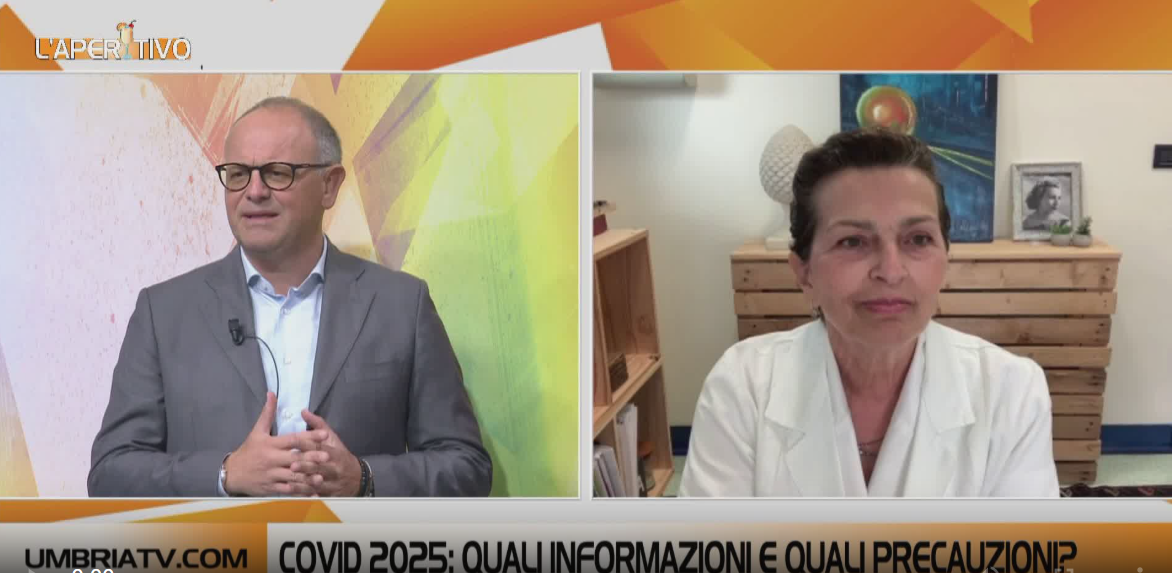 Covid 2025: crescono casi, a UTV ne parla prof.ssa Mencacci - Umbria TV
Covid 2025: crescono casi, a UTV ne parla prof.ssa Mencacci - Umbria TV
La salute in primo piano con i nuovi casi Covid che si affacciano a livello nazionale, circa 2000, da inizio settembre. Protagonista la nuova variante Stratus, importata dagli Stati Uniti e che ora si fa sentire anche nella nostra Umbria. Ne abbiamo parlato all”Aperitivo” di oggi con la prof.ssa Antonella Mencacci, direttore della struttura di Microbiologia dell’azienda ospedaliera di Perugia. Non mancano consigli su precauzioni e vaccinazione…
https://share.google/28x4XLWI1lSKt627Y
07-07-2025EVENTO
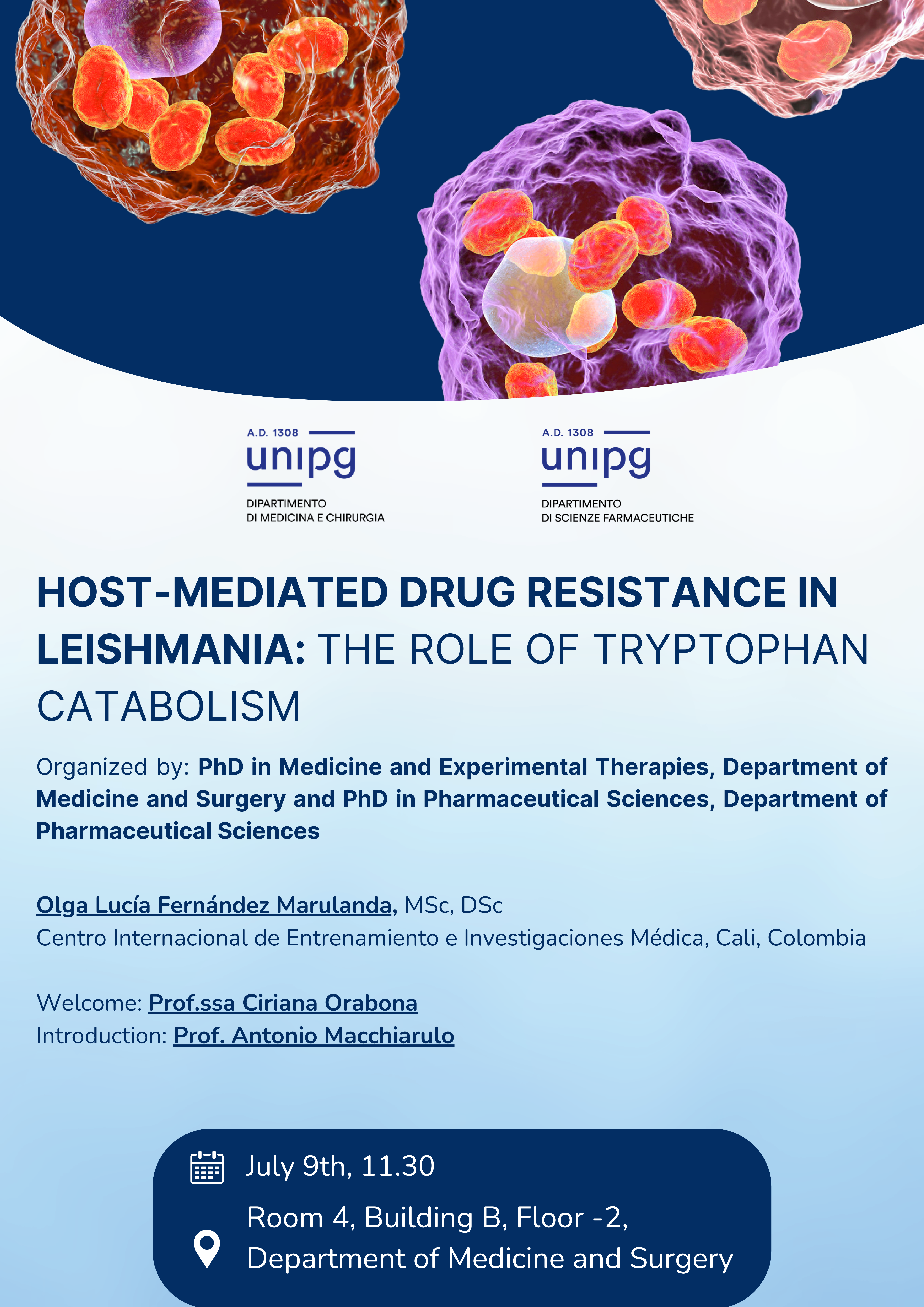 HOST-MEDIATED DRUG RESISTANCE IN LEISHMANIA: THE ROLE OF TRYPTOPHAN CATABOLISM
HOST-MEDIATED DRUG RESISTANCE IN LEISHMANIA: THE ROLE OF TRYPTOPHAN CATABOLISM
July 9th, 11.30
Room 4, Building B, Floor -2, Department of Medicine and Surgery
Organized by: PhD in Medicine and Experimental Therapies, Department of Medicine and Surgery and PhD in Pharmaceutical Sciences, Department of Pharmaceutical Sciences
Olga Lucía Fernández Marulanda, MSc, DSc
Centro Internacional de Entrenamiento e Investigaciones Médica, Cali, Colombia
Welcome: Prof.ssa Ciriana Orabona
Introduction: Prof. Antonio Macchiarulo
27-06-2025EVENTO
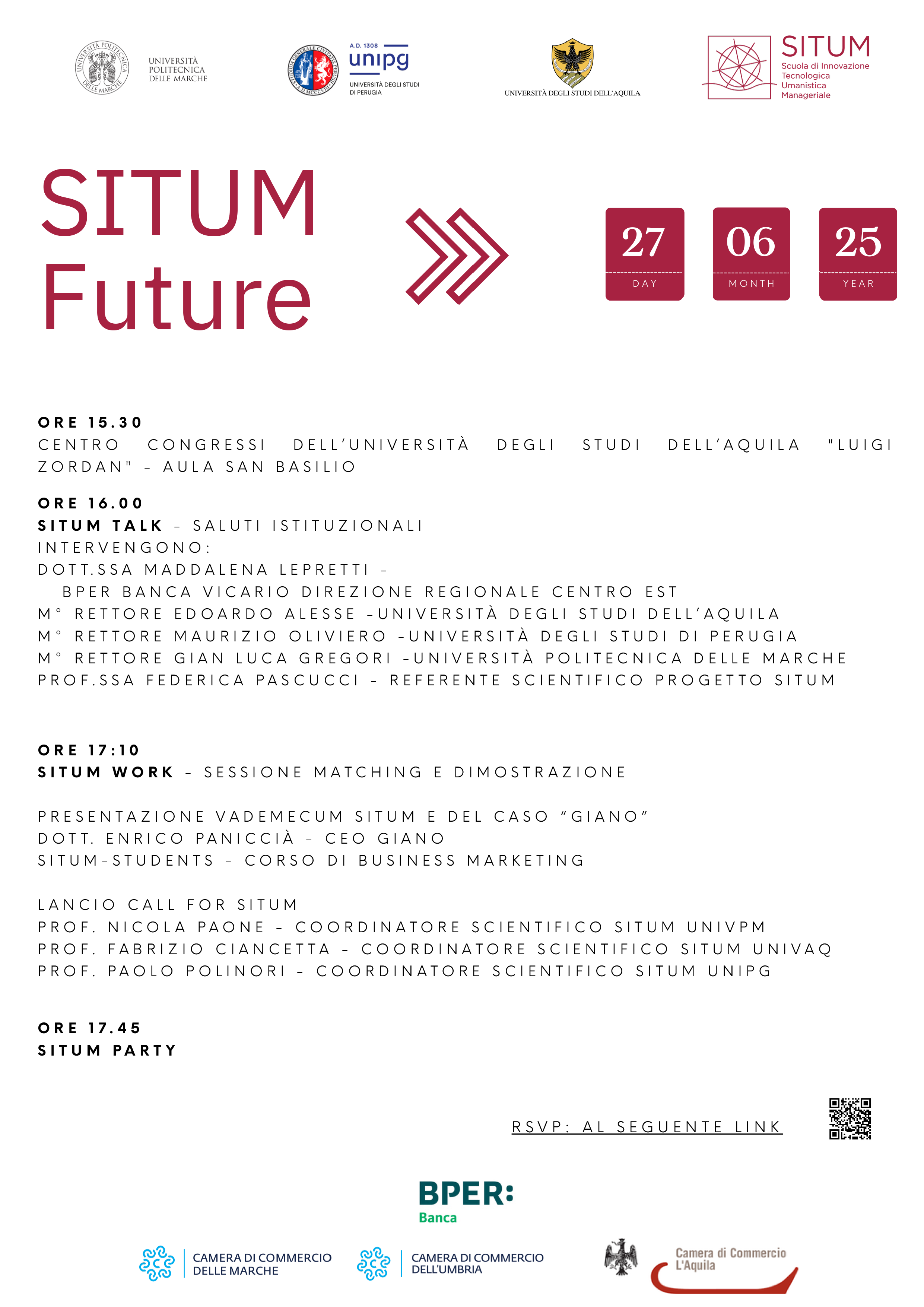 Scuola di Innovazione Tecnologica Umanistica e Manageriale
Scuola di Innovazione Tecnologica Umanistica e Manageriale
è un progetto promosso congiuntamente dall’ Università Politecnica delle Marche, all’Università degli Studi di Perugia e all’Università degli Studi dell’Aquila.
SITUM è un’iniziativa interateneo rivolta in primo luogo a docenti, studenti e imprese, ma anche dottorande, dottorandi, assegniste e assegnisti. Il suo obiettivo è quello di promuovere una didattica innovativa mediante l’integrazione di esperienze progettuali legate a sfide aziendali reali negli insegnamenti dei corsi di laurea magistrale. Il progetto prenderà avvio già dal primo semestre del prossimo anno accademico.
"SITUM-FUTURE” del 27 giugno 2025: un’occasione unica per conoscere da vicino il programma, confrontarsi con colleghi e imprese, ed esplorare le possibilità di adesione come docente referente. Durante l’evento sarà presentato il piano operativo del prossimo anno, saranno illustrati gli strumenti a disposizione e si attiveranno i primi contatti con i tutor e le imprese coinvolte.
25-06-2025EVENTO
 Lo scorso 25 giugno, a Roma presso la sede di Confindustria, ente promotore, nell’ambito dell’evento “Valorizzazione della Ricerca: la collaborazione pubblico privata. Patrimonializzare l’effetto leva del PNRR” orientato ad esplorare il ruolo della Ricerca e Sviluppo nel rafforzare la collaborazione pubblico-privato, l’Università di Perugia e Sanofi hanno avuto l’opportunità di presentare l’esperienza maturata insieme in merito al Dottorato Innovativo da loro istituito nell’ambito delle Esperienze e Risultati della Ricerca e Sviluppo nel Piano Nazionale di Ripresa e Resilienza (PNRR).
Lo scorso 25 giugno, a Roma presso la sede di Confindustria, ente promotore, nell’ambito dell’evento “Valorizzazione della Ricerca: la collaborazione pubblico privata. Patrimonializzare l’effetto leva del PNRR” orientato ad esplorare il ruolo della Ricerca e Sviluppo nel rafforzare la collaborazione pubblico-privato, l’Università di Perugia e Sanofi hanno avuto l’opportunità di presentare l’esperienza maturata insieme in merito al Dottorato Innovativo da loro istituito nell’ambito delle Esperienze e Risultati della Ricerca e Sviluppo nel Piano Nazionale di Ripresa e Resilienza (PNRR).
All’evento hanno presenziato Maurizio Tarquini, Direttore Generale di Confindustria, Francesca Galli, Segreteria Tecnica del Ministro (MUR) e Donatella Prato, direttore dell’Unità di missione per l'attuazione degli interventi del PNRR.
Attraverso l’appassionato intervento di Ester Castagnaro, dottoranda dal 2024 del XL ciclo del dottorato in Medicina e Terapie Sperimentali (Dottorato Innovativo) con il progetto “Artificial Intelligence (AI) tool version 2.0: supporting the diagnostic workup of Eosinophilic Esophagitis (EoE) across different age groups and symptoms”, è stata valorizzata l’esperienza come preziosa nel trasferimento reciproco di conoscenze e competenze, nell’orientamento all’impatto concreto dei progetti realizzati grazie alla coniugazione della ricerca accademica e la sua applicazione in un contesto reale da parte dell’azienda e la valorizzazione del ruolo del Dottorando in ambito aziendale.
A coordinare questo Dottorato Innovativo per l’Università di Perugia è la Prof.ssa Roberta Spaccapelo, Professore Associato di Microbiologia e direttore del Dottorato di Ricerca in Medicina e Terapie Sperimentali.
23-06-2025EVENTO
 Workshop: Unraveling Mosquito Mating Dynamics
Workshop: Unraveling Mosquito Mating Dynamics
23rd-25th June 2025
Lecture room 9, Building B, Level -2
Department Of Medicine and Surgery, University of Perugia
Italy
21-06-2025EVENTO
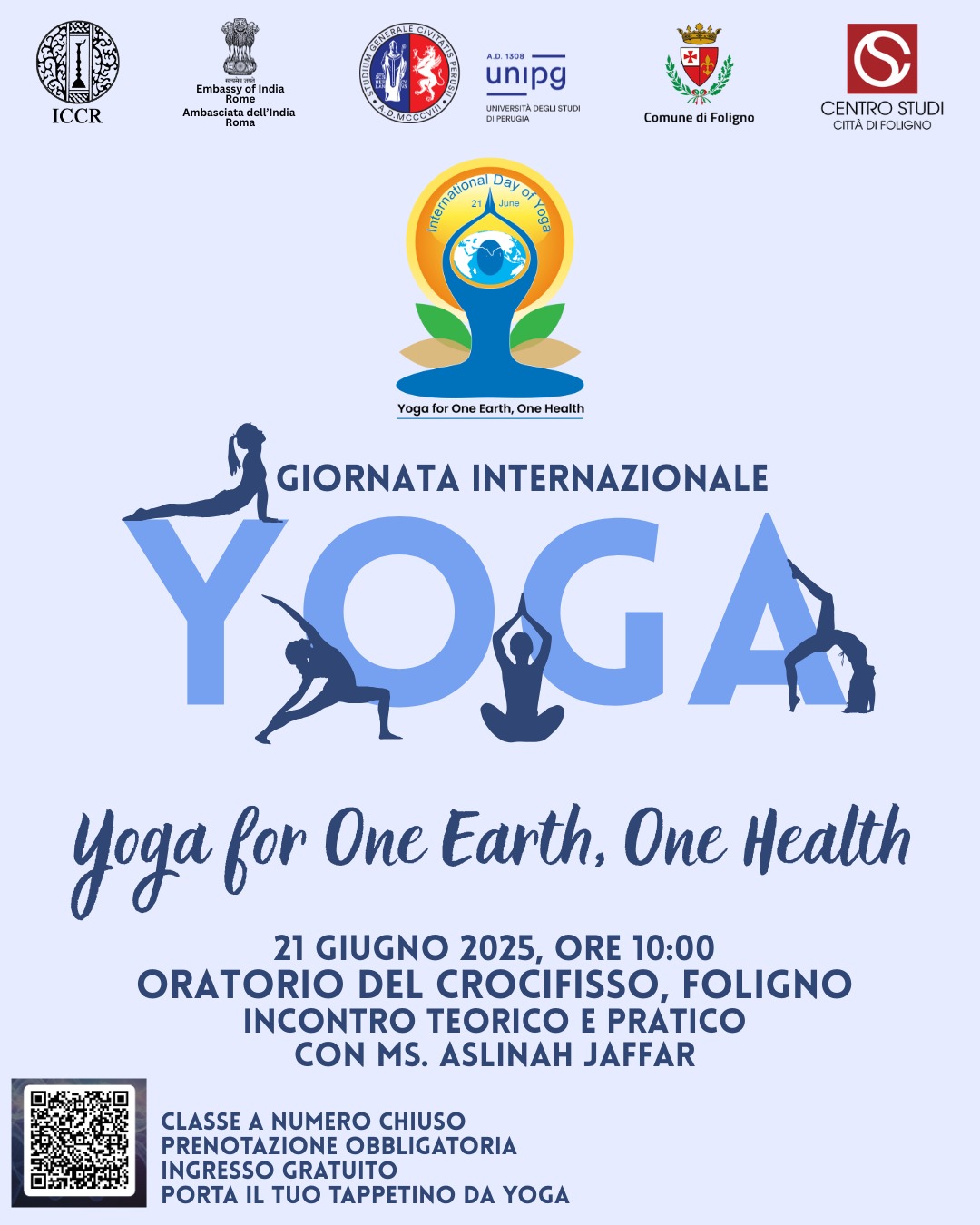 21 GIUGNO 2025, ORE 10:00
21 GIUGNO 2025, ORE 10:00
ORATORIO DEL CROCIFISSO, FOLIGNO
INCONTRO TEORICO E PRATICO CON MS. ASLINAH JAFFAR
08-06-2025COMUNICATO STAMPA
La European Hematology Association (EHA) ha riconosciuto il modello funzionale e innovativo del percorso diagnostico riservato al paziente ematologico attuato nel Laboratorio di Diagnostica Integrata delle Patologie Ematologiche della Struttura Complessa di Ematologia a Direzione Universitaria dell’Azienda Ospedaliera e Università degli Studi di Perugia, e lo ha selezionato per ospitare una Preceptorship dello Scientific Working Group Acute Myeloid Lekemia (AML) dell'European Hematology Association (SWG-AML EHA), un primo progetto pilota della società scientifica europea, che in un bando competitivo, ha visto premiata la proposta perugina.
La Preceptorship, dal titolo "Comprehensive workflow to achieve precise diagnosis in acute myeloid leukemia: a journey from cytomorphology to next generation sequencing [Flusso di lavoro completo per ottenere una diagnosi precisa nella leucemia mieloide acuta: un viaggio dalla citomorfologia al sequenziamento di nuova generazione]", sarà coordinata dalla professoressa Maria Paola Martelli, Direttore della Struttura Complessa di Ematologia, e dalla dottoressa Roberta La Starza, Responsabile del Laboratorio di Diagnostica Integrata delle Patologie Ematologiche, in collaborazione con una equipe specificatamente dedicata dall'EHA SWG-AML, e prevede la partecipazione di Docenti nazionali e internazionali, oltre che dei Responsabili delle singole unità del Laboratorio (https://ehaweb.org/connect-network/meetings/eha-swg-pilot-preceptorship).
16-05-2025COMUNICATO STAMPA
La ricerca del Dipartimento di Medicina e Chirurgia dell’Università di Perugia sull’Iperossaluria Primaria premiata dalla Oxalosis & Hyperoxaluria Foundation
13-05-2025EVENTO
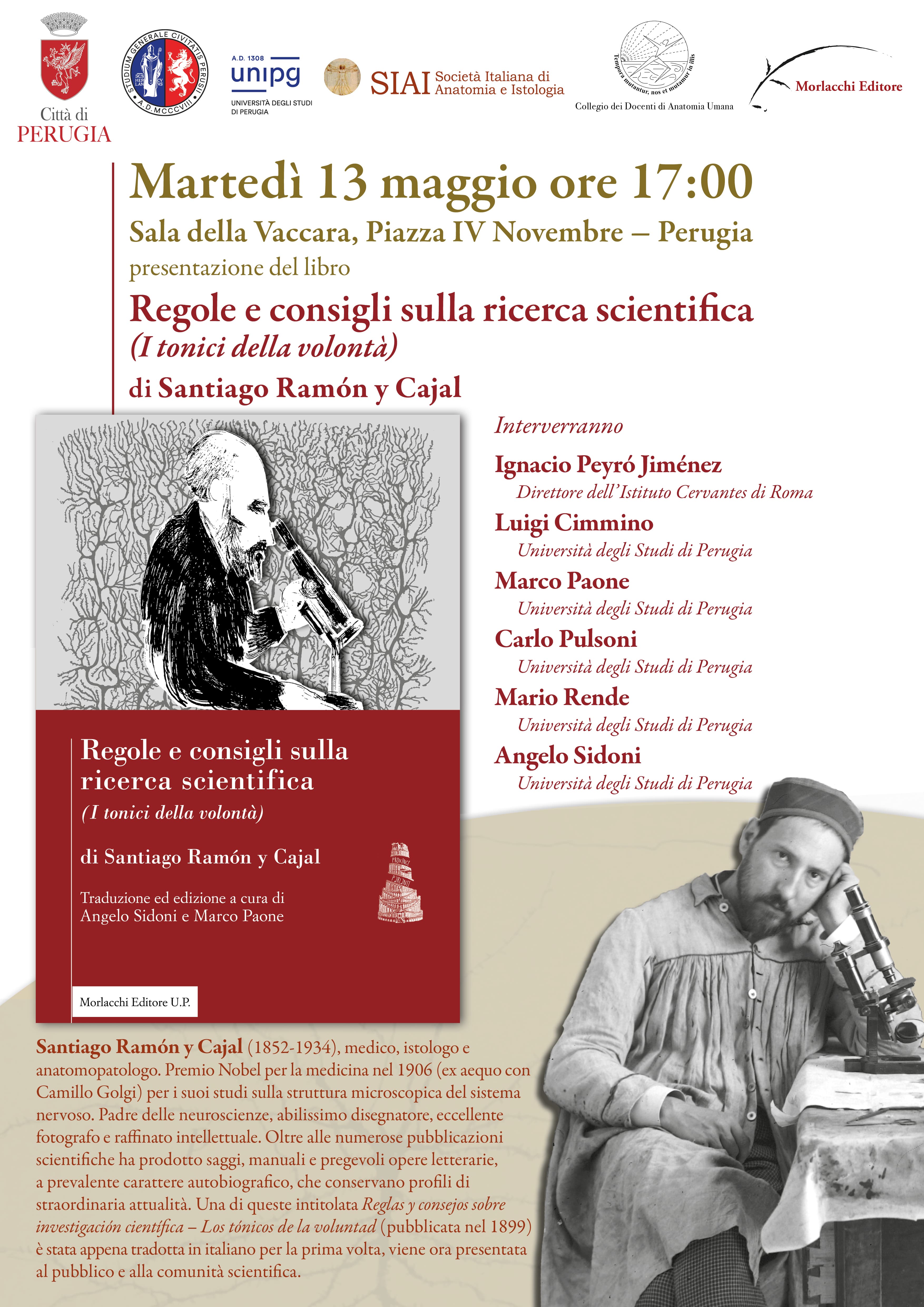 Regole e consigli sulla ricerca scientifica (I toni della volontà)
Regole e consigli sulla ricerca scientifica (I toni della volontà)
MARTEDI' 13 MAGGIO" ore 17:00
Sala della Vaccara, Piazza IV Novembre - Perugia
Presentazione del libro
Regole e consigli sulla ricerca scientifica
(I toni della volontà)
di Santiago Ramòn y Cajal
09-05-2025COMUNICATO STAMPA
Lotta all’antibiotico resistenza: il Dipartimento di Medicina e Chirurgia dell’Università degli Studi di Perugia protagonista del progetto europeo BactEradiX
10-05-2025EVENTO
 SPORT E BENESSERE
SPORT E BENESSERE
IMPLICAZIONI MUSCOLARI E NUTRIZIONALI DELL’ATTIVITÀ SPORTIVA
Sabato, 10 Maggio 2025 | 9:50 - 12:30
San Giustino, Museo del Tabacco
Moderatori:
Gabrio Possenti, Francesca Riuzzi e Guglielmo Sorci
04-05-2025EVENTO
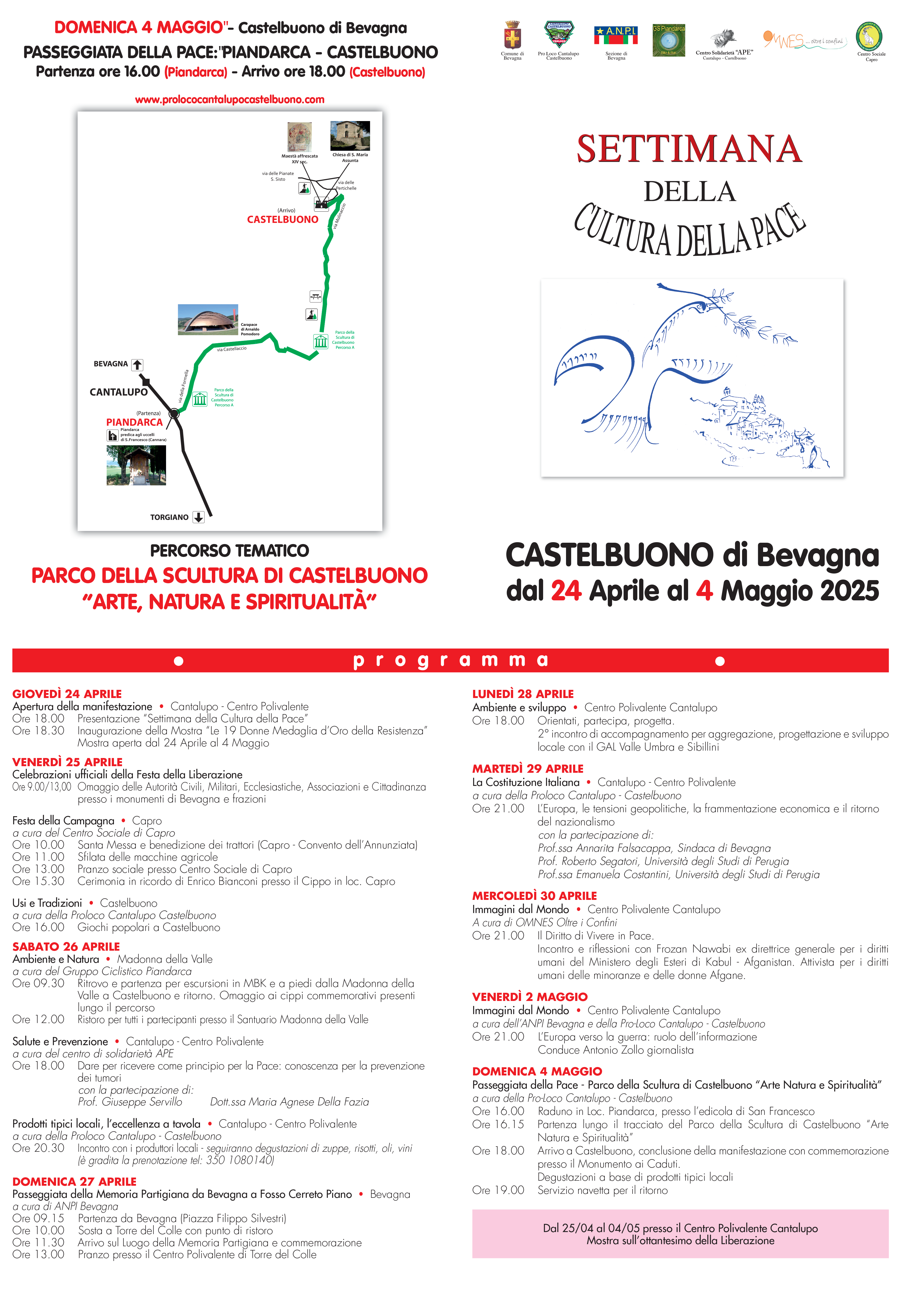 DOMENICA 4 MAGGIO"- Castelbuono di Bevagna
DOMENICA 4 MAGGIO"- Castelbuono di Bevagna
PASSEGGIATA DELLA PACE:"PIANDARCA - CASTELBUONO
Partenza ore 16.00 (Piandarca) - Arrivo ore 18.00 (Castelbuono)
dal 24 Aprile al 4 Maggio
CASTELBUONO DI BEVAGNA
PERCORSO TEMATICO
PARCO DELLA SCULTURA DI CASTLBUONO "ARTE, NATURA E SPIRITUALITA'"
Partecipano il Prof. Giuseppe SERVILLO, Dott.ssa Maria Agnese DELLA FAZIA
12-04-2025EVENTO
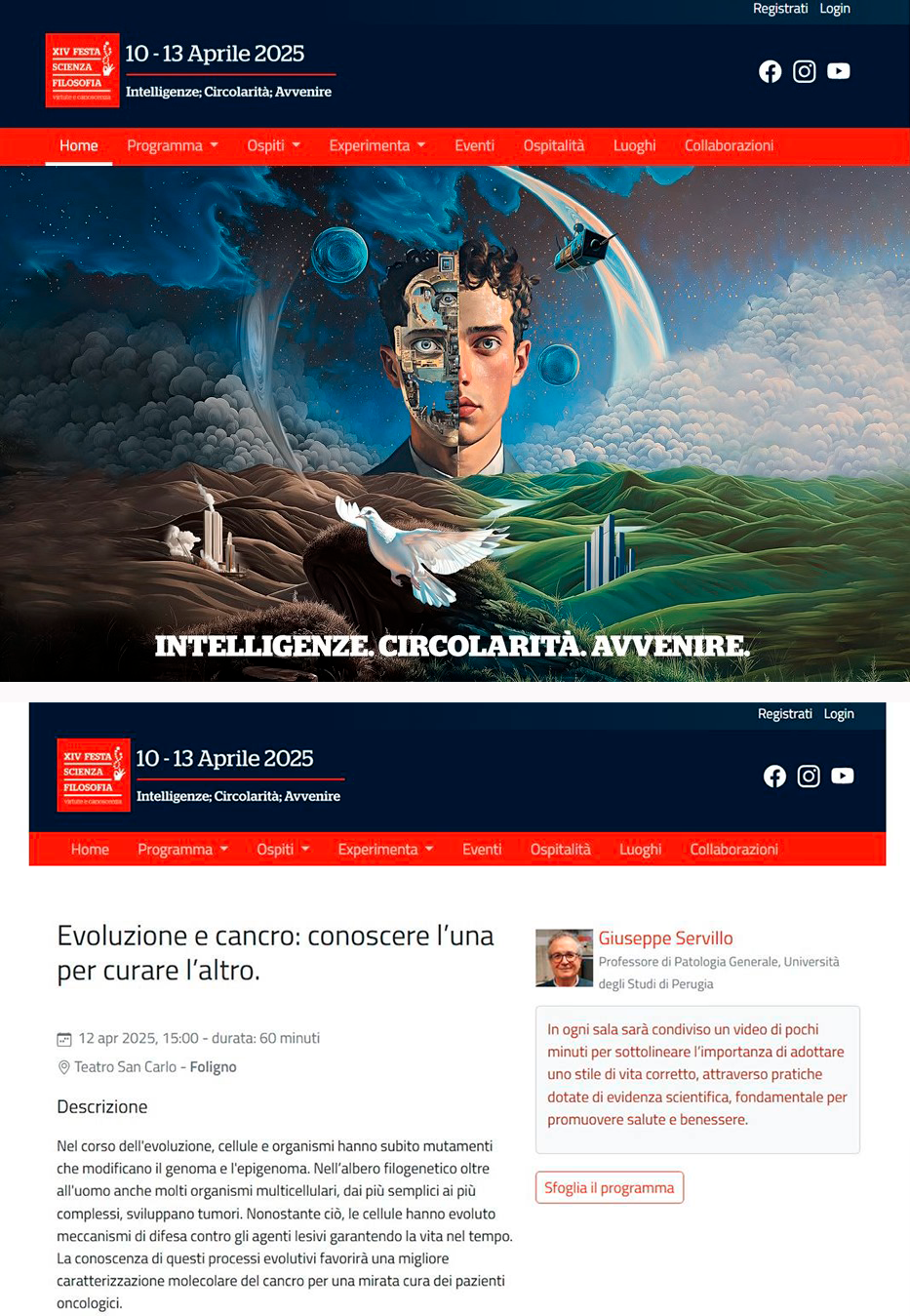 "XIV edizione di Festa di Scienza e di Filosofia. Intelligenze, Circolarità, Avvenire."
"XIV edizione di Festa di Scienza e di Filosofia. Intelligenze, Circolarità, Avvenire."
12 Aprile ore 15.00
Teatro San Carlo, Foligno
Relatore: Prof. Giuseppe SERVILLO
Dipartimento di Medicina e Chirurgia - Università degli Studi di Perugia
01-04-2025EVENTO
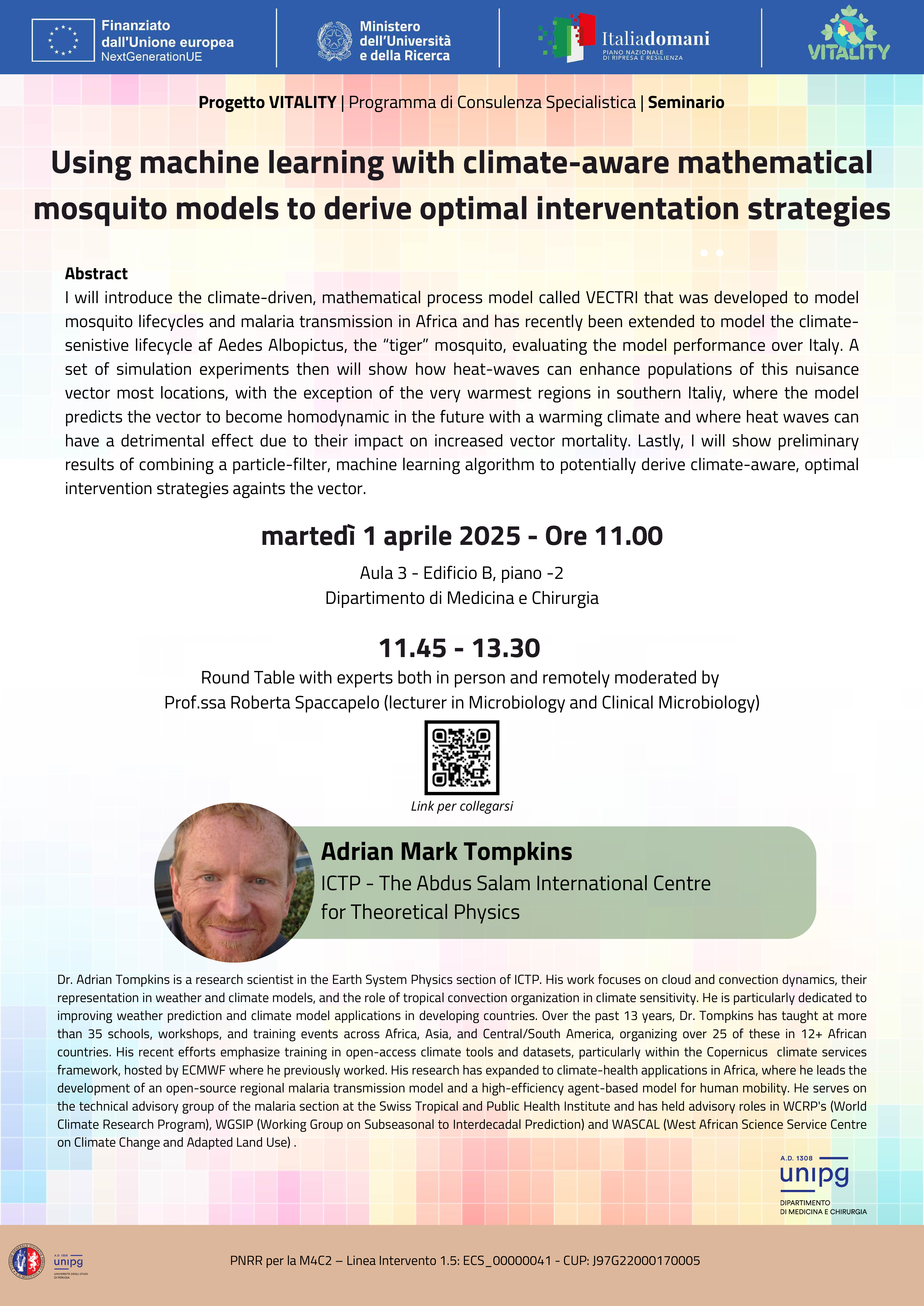 "Using machine learning with climate-aware mathematical
"Using machine learning with climate-aware mathematical
mosquito models to derive optimal interventation strategies"
Progetto VITALITY | Programma di Consulenza Specialistica | Seminario
martedì 1 aprile 2025 - Ore 11.00 - Aula 3 - Edificio B, piano -2
Dipartimento di Medicina e Chirurgia
10-03-2025EVENTO
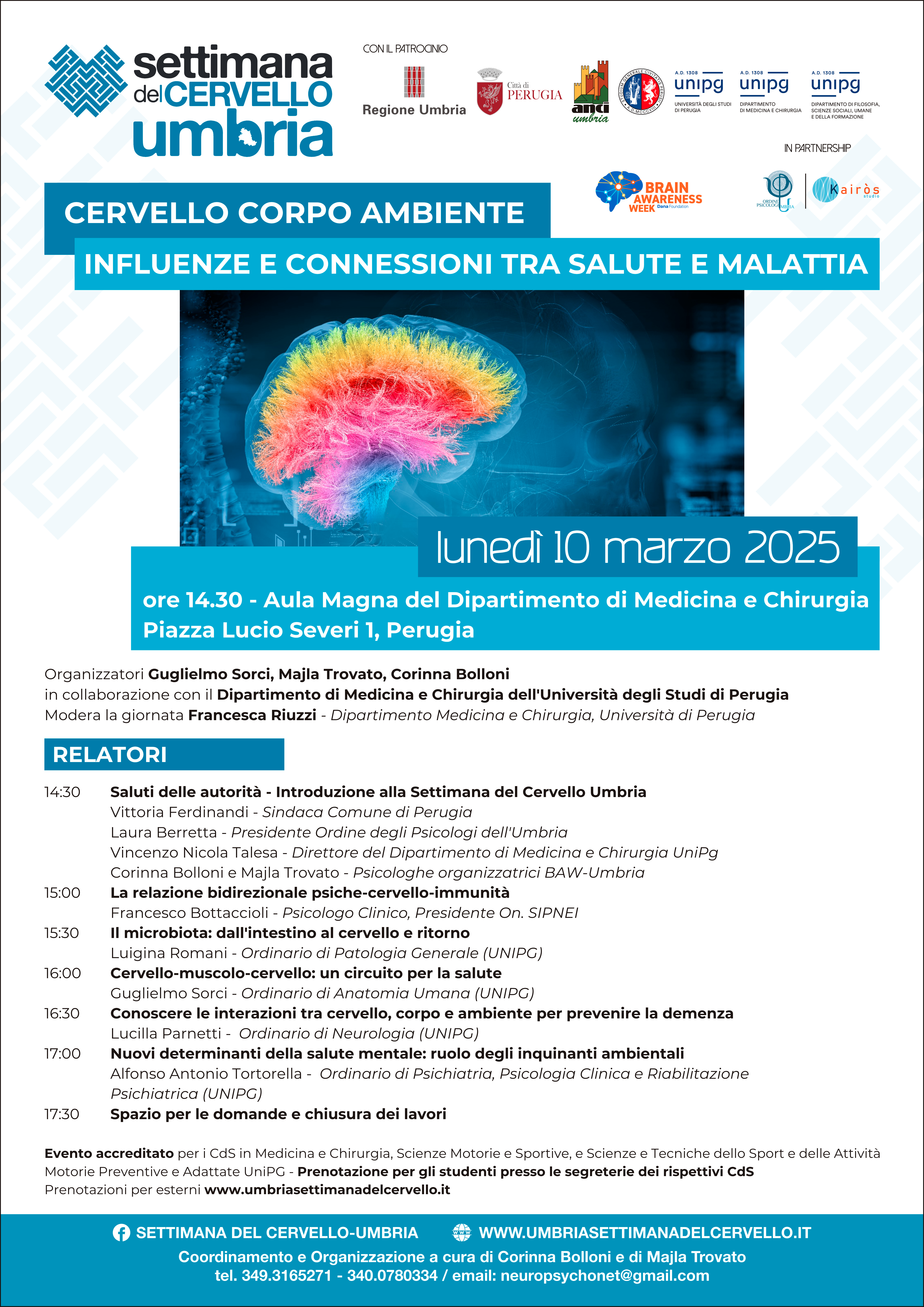 "CERVELLO CORPO AMBIENTE - INFLUENZE E CONNESSIONI TRA SALUTE E MALATTIA"
"CERVELLO CORPO AMBIENTE - INFLUENZE E CONNESSIONI TRA SALUTE E MALATTIA"
EVENTO E CONNESSIONI TRA SALUTE E MALATIA
Organizzatori: Guglielmo SORCI, Majla TROVATO, Corinna BOLLONI
Lunedì 10 Marzo 2025 ore 14.30 Aula Magna del Dipartimento di Medicina e Chirurgia
03-03-2025EVENTO
"Prevenzione a tavola" Prof.ssa Anna Villarini (Dipartimento di Medicina e Chirurgia, UNIPG);
"Effetti del consumo di una dieta malsana nel muscolo scheletrico" Dott.ssa Laura Salvadori, borsista della Fondazione Veronesi;
"Sarcobesità e prodotti naturali" Prof.ssa Francesca Riuzzi (Dipartimento di Medicina e Chirurgia, UNIPG).
Presso l'Istituto Omnicomprensivo Fanfani Camaiti (sede Alberghiero di Caprese Michelangelo)
03 Marzo 2025 ore 11:00.
19-02-2025ABSTRACT
Abstract presentato ai Research Days della società di Gastroenterologia Pediatrica Italian. Prof. Francesco VALITUTTI
https://www.corrierenazionale.it/2025/02/16/diagnosi-di-celiachia-nei-bimbi-possibile-anche-senza-biopsia-intestinale/
https://www.insalutenews.it/in-salute/diagnosi-di-celiachia-nuovo-esame-del-sangue-riduce-drasticamente-le-emissioni-di-co2-rispetto-alla-biopsia-studio-italiano/
https://gastroinfo.it/news/diagnosi-di-celiachia-senza-biopsia-meno-invasiva-per-i-bambini-e-piu-sostenibile-per-lambiente/
https://quisalute.online/ricerca/nuovo-esame-celiachia/
- Dettagli
Coordinator
Questo indirizzo email è protetto dagli spambots. È necessario abilitare JavaScript per vederlo.
Vice - Coordinator
Questo indirizzo email è protetto dagli spambots. È necessario abilitare JavaScript per vederlo.
Comitato di indirizzo del dottorato
- Il Dottorato di Ricerca rappresenta un corso di alta formazione post-lauream su tematiche di ricerca di elevato impatto sociale e di ampio respiro riguardando patologie che, in termini epidemiologici, occupano i primi posti per diffusione e, secondo le proiezioni dell’OMS, sono destinate ad aumentare. Le malattie infettive e su base infiammatoria costituiscono un grave problema di salute pubblica e sono tra le principali cause di mortalità e morbilità in tutto il mondo. In tali patologie si assiste a un fallimento o una cronicizzazione della risposta immunitaria, che avrebbe invece la potenziale capacità di far fronte con successo alla loro insorgenza o progressione. Per trattare o prevenire gli stati infiammatori o infettivi è necessario comprendere in maniera approfondita i meccanismi alla base dell’insorgenza della patologia, come il sistema immunitario controlla l’infiammazione, le strategie responsabili dell’evasione dal sistema immunitario, e gli effetti sull’ospite a seguito dell’attivazione di una risposta immunitaria diretta contro se stesso (malattia autoimmune) e i fattori di rischio predisponenti alla patologia. Il Dottorato intende attrarre giovani ricercatori con l’obiettivo di formare e motivare una nuova generazione di scienziati trasferendo loro conoscenze e capacità tecniche che consentiranno di studiare le malattie infettive e l’attivazione della risposta immunitaria in modi innovativi, entusiasmanti e produttivi. Il corso di dottorato fornisce competenze in ambiti di ricerca strategici a livello internazionale, come: i) lo studio dei meccanismi patogenetici di base che potrebbero portare all’identificazione di nuovi strumenti diagnostici, allo sviluppo di vaccini e ad altri interventi per la prevenzione e il controllo delle malattie infettive e all'identificazione di nuovi bersagli terapeutici; ii) l’analisi delle risposte immunitarie e metaboliche nelle malattie infiammatorie e immunitarie come possibili obiettivi per nuove terapie farmacologiche e per lo sviluppo di terapie personalizzate; iii) lo studio di malattie rare; iv) l’identificazione di fattori di rischio per la prevenzione di patologie cronico-degenerative. Il Dottorato promuove, anche grazie alle innumerevoli collaborazioni internazionali attivate dai docenti del Dottorato, un approccio multidisciplinare che comprende le scienze omiche- (trascrittomica, proteomica, metabolomica, lipidomica, metagenomica,secretomica) in associazione con le scienze biologiche tradizionali (immunologia, biologia molecolare e cellulare, microbiologia, biochimica, fisiologia, genomica, patologia, anatomia, farmacologia e la sanità pubblica), con l’obiettivo di valutare gli impieghi dei prodotti della ricerca per il miglioramento della salute della popolazione. Le malattie infettive e immuno-mediate attualmente allo studio comprendono malaria, toxoplasmosi, patologie fungine (da Candida e Aspergillus) e virali (coronavirus e altri virus respiratori), diabete, obesità, cancro, malattie autoimmuni, distrofia/atrofia muscolare e malattie rare. Ulteriori studi immunologici si concentrano sulla regolazione genetica della risposta immunitaria, l'interazione tra il sistema immunitario innato e le comunità microbiche intestinali, la funzione e la regolazione delle citochine coinvolte nell'infiammazione.
Il dottorato si articola in due diversi ma interconnessi curricula:
Biologia integrativa del rapporto ospite-agente patogeno: Il curriculum si concentra nei recenti progressi nella biologia delle malattie infettive e fornisce la base per condurre ricerche su tali patologie con ricadute sia di base, sia traslazionali o applicative.
Strategie biologiche integrate nelle patologie genetiche, immuno-metaboliche e oncologiche: Il curriculum si concentra sull’acquisizione di specifiche competenze nell’ambito dell'interfaccia tra le risposte immunitarie e metaboliche nelle patologie oncologiche, autoimmunitarie e genetiche con lo scopo di sviluppare terapie innovative. L’approccio alle varie patologie è di tipo traslazionale e punta all’identificazione di biomarcatori e possibili bersagli terapeutici.
Il progetto formativo previsto per il corso di dottorato ha un alto livello di approfondimento e prevede i seguenti obiettivi:
1. Attività didattica e seminari specifici del dottorato per acquisire conoscenze avanzate in ambito biomedico; attività formative finalizzate allo sviluppo di capacità di disseminazione/comunicazione dell’attività di ricerca, trasferimento tecnologico e imprenditoria; attività di formazione di carattere multidisciplinare, transdisciplinare e interdisciplinare; attività formative finalizzate alla conoscenza dei sistemi di ricerca europei e internazionali.
2. Interazione con la comunità scientifica nazionale e internazionale;
3. Acquisizione di nozioni di elevato livello professionale nel mondo accademico e industriale.
- L'obiettivo principale e specifico del corso di Dottorato è di formare nuove generazioni di ricercatori ad elevata professionalità e multidisciplinarità nel campo delle patologie infiammatorie, immunitarie e infettive, in grado di raccogliere e affrontare con successo una delle più importanti sfide scientifiche create dalla conoscenza del genoma umano, delle patologie infiammatorie e infettive, dei microrganismi e delle nuove e sempre più sofisticate tecnologie. In senso trasversale, l’interdisciplinarità del corso e le importanti collaborazioni nazionali e internazionali dei docenti del Dottorato permetteranno agli studenti di sviluppare conoscenze in ambito di strategie preventive e terapeutiche innovative e all’avanguardia (come, ad esempio, nell’ambito dei biofarmaci e della medicina personalizzata) in grado di contrastare le emergenti sfide in ambito delle malattie infettive e delle patologie infiammatorie. Il Dottorato contribuirà alla realizzazione di nuovi legami tra le Università italiane e straniere e il mondo industriale in un ambito scientifico specialistico, e tuttavia caratterizzato da rapida evoluzione e multidisciplinarietà. Tutti i dottorandi potranno beneficiare dell’interazione e della partecipazione/collaborazione con le Aziende partner del Dottorato. In tale contesto, gli studenti avranno l’opportunità di sviluppare progetti di ricerca applicata e partecipare al trasferimento dei risultati scientifici al mondo industriale. Il corso di Dottorato si articola in 2 curricula che prevedono lo sviluppo di competenze complementari nell'ambito della ricerca di base, pre-clinica e clinica e in realtà accademiche, nazionali e internazionali, e aziendali. Gli studenti diventeranno loro stessi protagonisti e collaboratori del corso di Dottorato, proponendo e gestendo in prima persona ricerche scientifiche e in collaborazione con i docenti del Corso. Il Dottorato ha l’obiettivo di ampliare e approfondire le conoscenze scientifiche dei dottorandi anche tramite un articolato percorso formativo sviluppato in collaborazione con docenti di ampio profilo scientifico nazionali e internazionali. Al termine del Dottorato, gli studenti avranno acquisito familiarità con le più innovatine tecnologie di biologia cellulare e molecolare e nozioni di elevato livello professionale nelle tematiche di biologia del rapporto ospite-patogeno, di patologie a base infiammatoria, di immunogenetica e immunologia traslazionali e biostatistica, che permetteranno loro ampi sbocchi professionali nel mondo accademico e dell’industria
Al termine del percorso formativo, i dottorandi avranno acquisito nozioni di elevato livello professionale riguardanti discipline affrontate nel corso del programma di Dottorato e saranno in grado di promuovere l’avanzamento delle conoscenze scientifiche e tecnologiche, sia in ambito accademico che industriale. Ciò consentirà ai Dottori di ricerca sia l’accesso alla carriera universitaria sia l’inserimento in enti di ricerca pubblici e privati, o presso aziende specializzate (ad esempio: aziende farmaceutiche, biotecnologiche, nutraceutiche, ospedaliere). Il percorso formativo proposto e la dimensione internazionale del Dottorato faciliteranno questo processo fornendo agli studenti l’opportunità di accedere a borse di studio post-dottorato prestigiose a livello internazionale, come le borse Marie-Curie e le borse EMBO, o a programmi di ricerca nazionali e internazionali per giovani ricercatori (SIR, ERC starting grant, AIRC). Inoltre, l’interazione e i periodi di studio/ricerca svolti presso le aziende partner del Dottorato consentiranno ai Dottori di ricerca di entrare più rapidamente in contatto con il mondo industriale e forniranno un vantaggio competitivo ai fini di eventuali assunzioni all’interno delle stesse aziende. Il Dottorato getta, altresì, i presupposti per la possibile creazione di start-up e spin-off da parte di giovani ricercatori. Infine, bandi per posizioni temporanee o permanenti pubblicati da associazioni scientifiche, riviste scientifiche, industrie farmaceutiche e università italiane e straniere vengono regolarmente resi noti ai Dottorandi. È prevista l’implementazione di un sistema di monitoraggio degli sbocchi professionali che verrà messo a disposizione già durante il percorso di Dottorato.
Biologia integrativa del rapporto ospite-agente patogeno: Il curriculum introduce gli studenti ai recenti progressi nella biologia delle malattie infettive e fornisce la base per condurre ricerche su tali malattie. Il programma si concentra sull’uso delle scienze omiche- (genomica, trascrittomica, proteomica, metagenomica, metabolomica, lipidomica, secretomica), delle scienze biologiche tradizionali quali biologia molecolare e cellulare, immunologia, genetica e della metodologia epidemiologica. In particolare, data l'esperienza scientifica di diversi supervisori del Dottorato, le attività di ricerca sono focalizzate allo studio di funghi (Candida e Aspergillus), batteri (con particolare attenzione ai batteri farmaco-resistenti), agenti virali (coronavirus e altri virus respiratori) e protozoi (Plasmodium e Toxoplasma).
Strategie biologiche integrate nelle patologie genetiche, immuno-metaboliche e oncologiche: Il curriculum si concentra sull’acquisizione di specifiche competenze nell’ambito dell'interfaccia tra le risposte immunitarie e metaboliche nelle patologie oncologiche, autoimmunitarie e genetiche con lo scopo di sviluppare terapie innovative. Grande attenzione è rivolta agli enzimi immunosoppressori che catabolizzano gli aminoacidi e al ruolo dei geni immunometabolici nelle malattie infiammatorie e immunitarie nonché alla comprensione dei meccanismi cellulari e molecolari coinvolti in patologie quali diabete, obesità, cancro, malattie autoimmuni, distrofia e atrofia muscolari, e malattie rare. L’approccio alle varie patologie è di tipo traslazionale e punta all’identificazione di biomarcatori e possibili bersagli terapeutici.
Il percorso formativo del dottorato, allineato alle nuove linee guida: “Politiche di ateneo e programmazione dell’offerta formativa”, approvato dal Senato Accademico e dal Consiglio di Amministrazione in data 28 settembre 2023 è così articolato:
- sviluppo, sotto la guida di più supervisori, di un PROGRAMMA DI RICERCA E STUDIO INDIVIDUALE, riferito ad un ambito disciplinare specifico fra quelli su cui è incentrato il Corso;
- frequenza di ATTIVITÀ DIDATTICHE DI LIVELLO DOTTORALE, complementari alla attività di ricerca, non inferiori a 30 cfu/triennio, secondo le indicazioni del Collegio;
- frequenza di ALTRE ATTIVITÀ FORMATIVE, che contribuiscono alla formazione dello studente, ma non prevedono acquisizione di cfu.
PROGRAMMA DI RICERCA E STUDIO INDIVIDUALE
Per quanto riguarda il programma di ricerca, i dottorandi vengono inseriti nelle attività dei gruppi di lavoro già esistenti presso le strutture afferenti al corso di dottorato (Dipartimenti universitari e Aziende farmaceutiche) con un programma di ricerca concordato con il docente responsabile della formazione dello studente e approvato dal Collegio dei Docenti, e parteciperanno attivamente a lab meetings e journal clubs. Inoltre, grazie all'estesa rete di collaborazioni con altre Università e Enti di Ricerca nazionali e internazionali, che i partecipanti al Collegio dei Docenti intrattengono, i dottorandi possono partecipare alle riunioni per la definizione dei vari aspetti dei progetti di ricerca e per la valutazione dei risultati raggiunti.
Per facilitare interazioni e collaborazioni tra dottorandi sono anche previsti regolari incontri tra i dottorandi e ricercatori del Dipartimento finalizzati allo scambio di esperienze pratiche e conoscenze teoriche.
Il dottorando, in accordo con il supervisore, può seguire presso altre strutture in Italia o all'estero brevi stage e corsi finalizzati e correlati al settore scientifico nel quale il dottorando svolge la sua attività di ricerca.
Inoltre, il dottorando può svolgere il progetto di ricerca, fino ad un massimo di 18 mesi, presso prestigiosi laboratori di ricerca internazionali.
ATTIVITÀ DIDATTICHE DI LIVELLO DOTTORALE
Le attività didattiche programmate per l’intero ciclo triennale prevedono:
| Tipologia |
Cfu previsti (studente/ciclo) |
Esame finale |
| A. Didattica frontale erogata dal Corso di Dottorato | 17 cfu | Si, in presenza |
| B. Didattica frontale erogata da altri Corsi di Dottorato | 4 cfu | Si, in presenza |
| C. Didattica frontale e trasversale di Ateneo e/o di altro Corso di Dottorato, a carattere multi/inter/trans-disciplinare | 6 cfu | Si, in presenza |
| D. Attività congressuali e scuole dottorali | 3 cfu | |
| TOTALE | 30 cfu |
Le attività didattiche sono erogate prevalentemente in lingua inglese anche a distanza in modalità sincrona e asincrona.
Il dettaglio delle attività didattiche erogate è riportato nella cartella del ciclo di riferimento.
ATTIVITÀ FORMATIVE
Le attività formative contribuiscono alla formazione del dottorando e includono le seguenti tipologie:
- attività in qualità di cultore della materia, con nomina ai sensi del vigente Regolamento d’Ateneo in materia;
- attività di tutorato da bando, accertato dagli Uffici di Ateneo competenti;
- attività di tutorato agli studenti di lauree di I e II livello, accertato e certificato dal Tutor o dal Docente di riferimento del corso cui il tutorato è destinato (fino ad un max 30 ore);
- partecipazione attiva ad eventi di Terza Missione organizzati dal Dipartimento di riferimento o dall’Ateneo (fino a max 10 ore);
- presentazione da parte del dottorando di atti scientifici a congressi e seminari;
- partecipazione a journal club.
Le attività formative sono registrate nel curriculum del Dottorando, ma per esse non è previsto il conseguimento di cfu e non concorrono a soddisfare i requisiti minimi delle attività didattica. Concorrono alla valutazione finale del dottorando.
XL ciclo
XXXIX ciclo
XXXVIII ciclo
XXXVII ciclo
XXXVI ciclo
Rappresentanti Dottoranti:
Florinda Apone – XXXIX ciclo
Gianluca Vascelli – XXXIX ciclo
Regolamento di Ateneo per i Corsi di dottorato di ricerca valevole a decorrere dal XXXVIII ciclo
Regolamento di Ateneo dei corsi di Dottorato di Ricerca valevole fino al XXXVII ciclo
Moduli per soggiorni all'estero
Modulo missione in paesi extra UE
Guidelines-for-preparation-of-PhD-thesis_new
ATTIVITÀ DIDATTICA PROGRAMMATA/PREVISTA
Le attività formative del dottorato sia a contenuto specialistico sia interdisciplinare trattano le principali aree di ricerca del dottorato: Immunologia, Genetica, Biologia Molecolare, Biologia Cellulare, Microbiologia e Virologia, Bioetica. In particolare i dottorandi potranno fruire di vari insegnamenti e attività didattiche, come di seguito riportato:
INSEGNAMENTI PREVISTI (distinti da quelli impartiti in insegnamenti relativi ai corsi di studio di primo e secondo livello).
ALTRE ATTIVITA’ DIDATTICHE (seminari, attività di laboratorio e di ricerca, formazione interdisciplinare, multidisciplinare e transdisciplinare)
ATTIVITÀ DIDATTICA PROGRAMMATA/PREVISTA
Le attività formative del dottorato sia a contenuto specialistico sia interdisciplinare trattano le principali aree di ricerca del dottorato: Immunologia, Genetica, Biologia Molecolare, Biologia Cellulare, Microbiologia e Virologia, Bioetica. In particolare i dottorandi potranno fruire di vari insegnamenti e attività didattiche, come di seguito riportato:
INSEGNAMENTI PREVISTI (distinti da quelli impartiti in insegnamenti relativi ai corsi di studio di primo e secondo livello).
ALTRE ATTIVITA’ DIDATTICHE (seminari, attività di laboratorio e di ricerca, formazione interdisciplinare, multidisciplinare e transdisciplinare)
ATTIVITÀ DIDATTICA PROGRAMMATA/PREVISTA
La didattica è organizzata in CORSI DI BASE e ATTIVITÀ FORMATIVE SPECIALISTICHE per un totale di 30 CFU. Ciascun dottorando deve seguire obbligatoriamente i corsi proposti per ciascun anno e sostenere l’esame laddove previsto. Gli esami che riguardano i corsi di base sono prevalentemente costituiti da prove definite dai docenti, mentre gli esami dei corsi specialistici consistono in una presentazione rivolta a tutti i dottorandi su una tematica trattata nel corso. La maggior parte dei corsi sono tenuti in lingua inglese.
L'Ufficio Dottorato di Ricerca organizza CORSI DI BASE TRASVERSALI ai vari Corsi di Dottorato dell’Ateneo di Perugia. I corsi di base prevedono attività di formazione disciplinare e interdisciplinare e di perfezionamento linguistico e informatico, nonché nel campo della gestione della ricerca e della conoscenza dei sistemi di ricerca europei e internazionali, della valorizzazione dei risultati della ricerca e della proprietà intellettuale.
I CORSI DI BASE previsti dall’Ateneo saranno tenuti ad anni alterni e pertanto gli studenti potranno liberamente decidere in quale anno accademico usufruire delle attività sotto elencate:
| Attività di perfezionamento linguistico e informatico | |
| Linguistica |
Il Corso di Dottorato prevede il conseguimento di un certificato di lingua inglese di livello B2 e pertanto offre ai dottorandi la possibilità di partecipare a corsi di lingua straniera presso il Centro Linguistico d’Ateneo (CLA). I livelli dei corsi di lingua offerti dal CLA fanno riferimento al Common European Framework of Reference e potranno avere una durata semestrale (10 CFU) o annuale (13 CFU) con valutazione conseguita nelle singole abilità linguistiche.
Le informazioni relative alle attività linguistiche fruibili presso il CLA sono disponibili al seguente link: www.cla.unipg.it Inoltre, saranno implementati corsi e periodi di formazione all’estero per migliorare la conoscenza dell’inglese. |
| Informatica |
Il Corso di Dottorato offre ai dottorandi la possibilità di partecipare a laboratori informatici già offerti in altri corsi di studio dell'Ateneo. Saranno inoltre organizzati specifici corsi in moduli da 1 CFU:
Per tali corsi sarà prevista una verifica del livello di conoscenza acquisito. |
| Attività di valorizzazione della ricerca e della proprietà intellettuale | |
| Gestione della ricerca, della conoscenza dei sistemi di ricerca e dei sistemi di finanziamento |
Il Corso di Dottorato offre la possibilità di partecipare a corsi da 1 CFU relativi alla gestione della ricerca e alla conoscenza dei sistemi di ricerca e dei sistemi di finanziamento. I corsi tratteranno in particolare di:
I Corsi prevedono una verifica finale del livello di conoscenza acquisito. |
| Valorizzazione dei risultati della ricerca e della proprietà intellettuale |
Il corso di Dottorato offre la possibilità di partecipare a 6 corsi da 1 CFU sulla valorizzazione della ricerca e della proprietà intellettuale. I 6 corsi tratteranno di:
I Corsi prevedono una verifica finale del livello di conoscenza acquisito. |
Le ATTIVITÀ FORMATIVE SPECIFICHE del dottorato sia a contenuto specialistico sia interdisciplinare si ripetono ciclicamente ogni tre anni. Essi trattano le principali aree di ricerca del dottorato: Immunologia, Genetica, Biologia Molecolare, Biologia Cellulare, Microbiologia e Virologia, Bioetica. In particolare i dottorandi potranno fruire dei seguenti corsi:
| Corsi specifici del dottorato | |
| I anno |
|
| II anno |
|
| III anno | |
ATTIVITA' FORMATIVA SPECIFICA XXXVI
ATTIVITA' DIDATTICA
La didattica è organizzata in CORSI DI BASE e ATTIVITÀ FORMATIVE SPECIALISTICHE per un totale di 30 CFU. Ciascun dottorando deve seguire obbligatoriamente i corsi proposti per ciascun anno e sostenere l’esame laddove previsto. Gli esami che riguardano i corsi di base sono prevalentemente costituiti da prove definite dai docenti, mentre gli esami dei corsi specialistici consistono in una presentazione rivolta a tutti i dottorandi su una tematica trattata nel corso. La maggior parte dei corsi sono tenuti in lingua inglese.
L'Ufficio Dottorato di Ricerca organizza CORSI DI BASE TRASVERSALI ai vari Corsi di Dottorato dell’Ateneo di Perugia. I corsi di base prevedono attività di formazione disciplinare e interdisciplinare e di perfezionamento informatico, nonché nel campo della gestione della ricerca e della conoscenza dei sistemi di ricerca europei e internazionali, della valorizzazione dei risultati della ricerca e della proprietà intellettuale.
I CORSI DI BASE previsti dall’Ateneo saranno tenuti ad anni alterni e pertanto gli studenti potranno liberamente decidere in quale anno accademico usufruire delle attività sotto elencate:
| Attività di perfezionamento linguistico e informatico | |
| Linguistica |
Il Corso di Dottorato prevede il conseguimento di un certificato di lingua inglese di livello B2 e pertanto offre ai dottorandi la possibilità di partecipare a corsi di lingua straniera presso il Centro Linguistico d’Ateneo (CLA). I livelli dei corsi di lingua offerti dal CLA fanno riferimento al Common European Framework of Reference e potranno avere una durata semestrale (10 CFU) o annuale (13 CFU) con valutazione conseguita nelle singole abilità linguistiche.
Le informazioni relative alle attività linguistiche fruibili presso il CLA sono disponibili al seguente link: www.cla.unipg.it Inoltre, saranno implementati corsi e periodi di formazione all’estero per migliorare la conoscenza dell’inglese. |
| Informatica |
Il Corso di Dottorato offre ai dottorandi la possibilità di partecipare a laboratori informatici già offerti in altri corsi di studio dell'Ateneo. Saranno inoltre organizzati specifici corsi in moduli da 1 CFU:
Per tali corsi sarà prevista una verifica del livello di conoscenza acquisito. |
| Attività di valorizzazione della ricerca e della proprietà intellettuale | |
| Gestione della ricerca, della conoscenza dei sistemi di ricerca e dei sistemi di finanziamento |
Il Corso di Dottorato offre la possibilità di partecipare a corsi da 1 CFU relativi alla gestione della ricerca e alla conoscenza dei sistemi di ricerca e dei sistemi di finanziamento. I corsi tratteranno in particolare di:
I Corsi prevedono una verifica finale del livello di conoscenza acquisito. |
| Valorizzazione dei risultati della ricerca e della proprietà intellettuale |
Il corso di Dottorato offre la possibilità di partecipare a 6 corsi da 1 CFU sulla valorizzazione della ricerca e della proprietà intellettuale. I 6 corsi tratteranno di:
I Corsi prevedono una verifica finale del livello di conoscenza acquisito. |
Le ATTIVITÀ FORMATIVE SPECIFICHE del dottorato sia a contenuto specialistico sia interdisciplinare si ripetono ciclicamente ogni tre anni. Essi trattano le principali aree di ricerca del dottorato: Immunologia, Genetica, Biologia Molecolare, Biologia Cellulare, Microbiologia e Virologia, Bioetica. In particolare i dottorandi potranno fruire dei seguenti corsi:
| Corsi specifici del dottorato | |
| I anno | |
| II anno | |
| III anno | |
Attività formativa erogata XXXIV>Attività formativa erogata XXXIV
Documento generale riassuntivo del XXXIV ciclo
BANDO ORDINARIO
Graduatoria di merito candidati (XXXIV ciclo)
Bando di selezione per l'ammissione ai corsi di dottorato di ricerca - XXXIV ciclo - A.A. 2018/2019
BANDO REGIONE UMBRIA
Graduatoria di merito candidati (XXXIV ciclo)
Bando di selezione per l'ammissione ai corsi di dottorato di ricerca - XXXIV ciclo - A.A. 2018/2019

